Hi there! We'd love to hear from you... please add your comments below the articles...
-
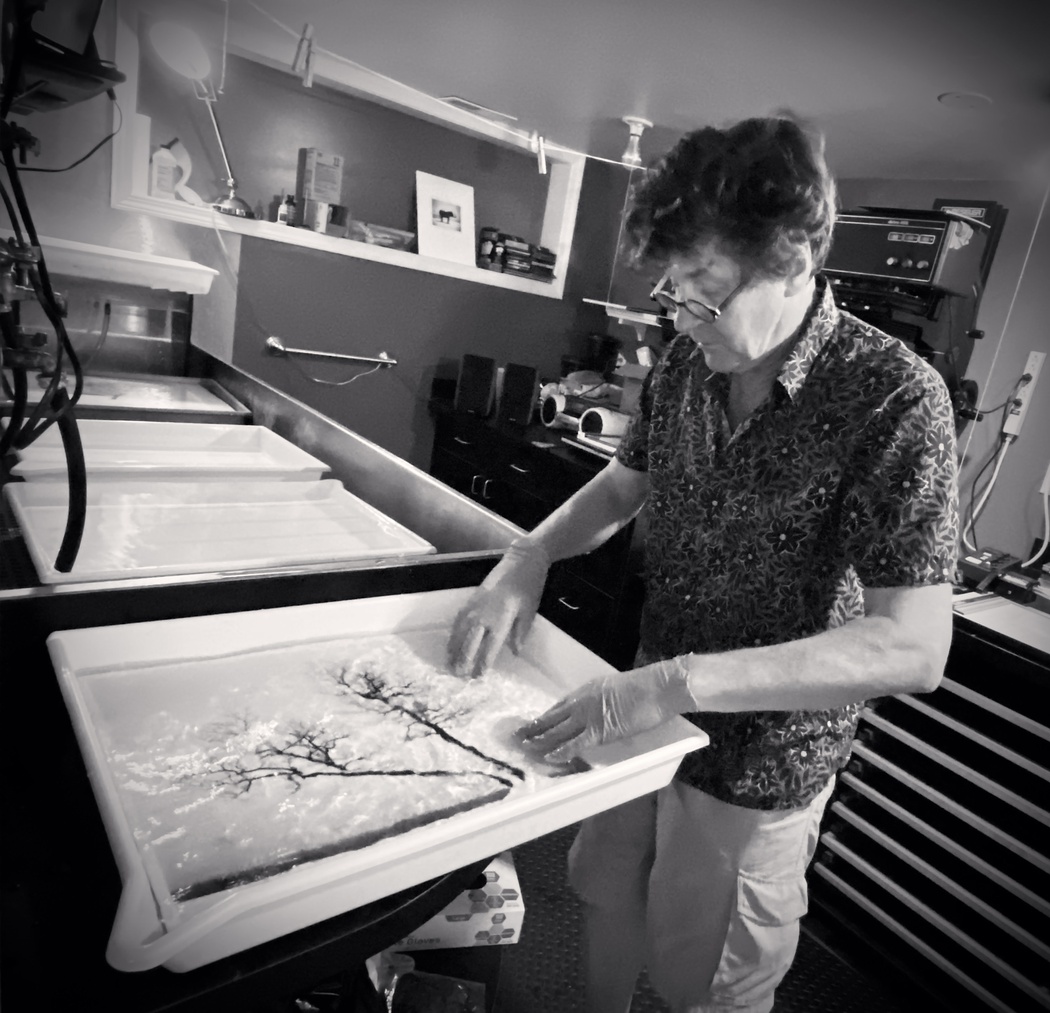
PRESS | Michael Kenna's Darkroom Diaries | Chapter 2
Black & White Photography Magazine Issue 305 August 2025In the second chapter of Michael Kenna's Darkroom Diaries, Michael invites you into his personal darkroom in Seattle, USA and explains how he interprets each negative. But first Luke Whitaker, owner of the Bosham Gallery, sheds further light on Michael's printing process. -
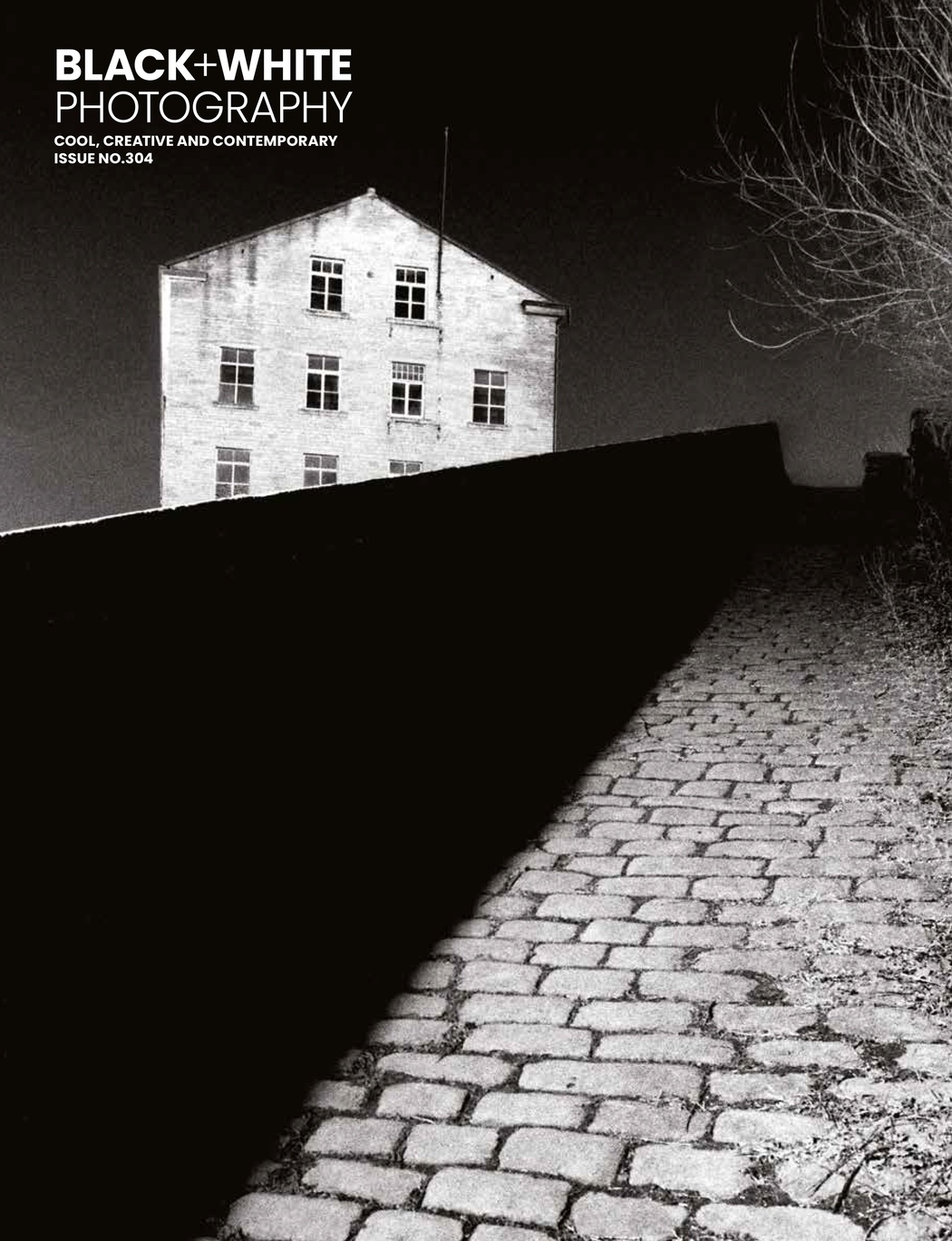
PRESS | Michael Kenna's Darkroom Diaries | Chapter 1
Black & White Photography Magazine Issue 304 July 2025"Michael Kenna has been photographing on film and making silver gelatin prints in his own darkroom for over 50 years. In the first of a series of five chapters sharing extracts from Kenna's Darkroom Diaries, we are reminded why prints made in the traditional analogue process, printed from original film negatives by hand in the darkroom, are so special. Michael will discuss his process of photographing on film and will explain the patient and painstaking work of making prints by hand in his darkroom which has allowed him to produce the distinct images that are celebrated for their rich blacks, luminous highlights and a grainy aesthetic that compliments the ethereal lighting his work is best known for." Luke Whitaker -
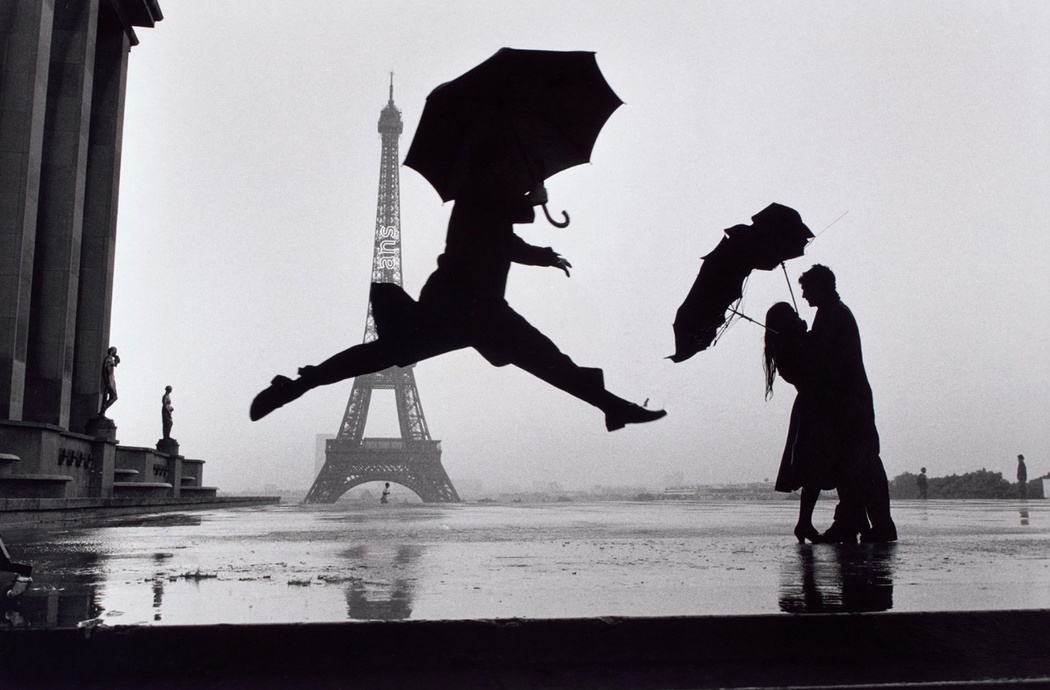
-
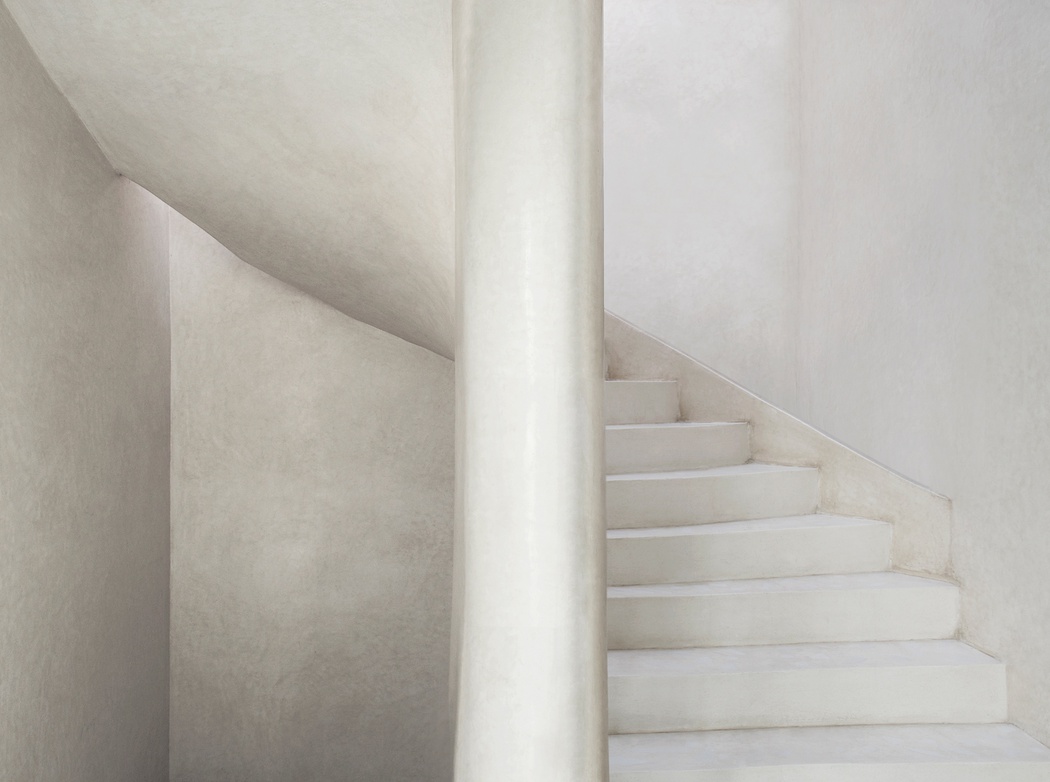 Marrakesh, Morocco 2014 by Charlie Waite (b.1949) | Archival Pigment Print 80 x 60cm
Marrakesh, Morocco 2014 by Charlie Waite (b.1949) | Archival Pigment Print 80 x 60cm -
 Elton John, Dodger Stadium, Los Angeles 1975 by Terry O'Neill (1938-2019) | Digital C-Type Print 61 x 50.8cm
Elton John, Dodger Stadium, Los Angeles 1975 by Terry O'Neill (1938-2019) | Digital C-Type Print 61 x 50.8cm -
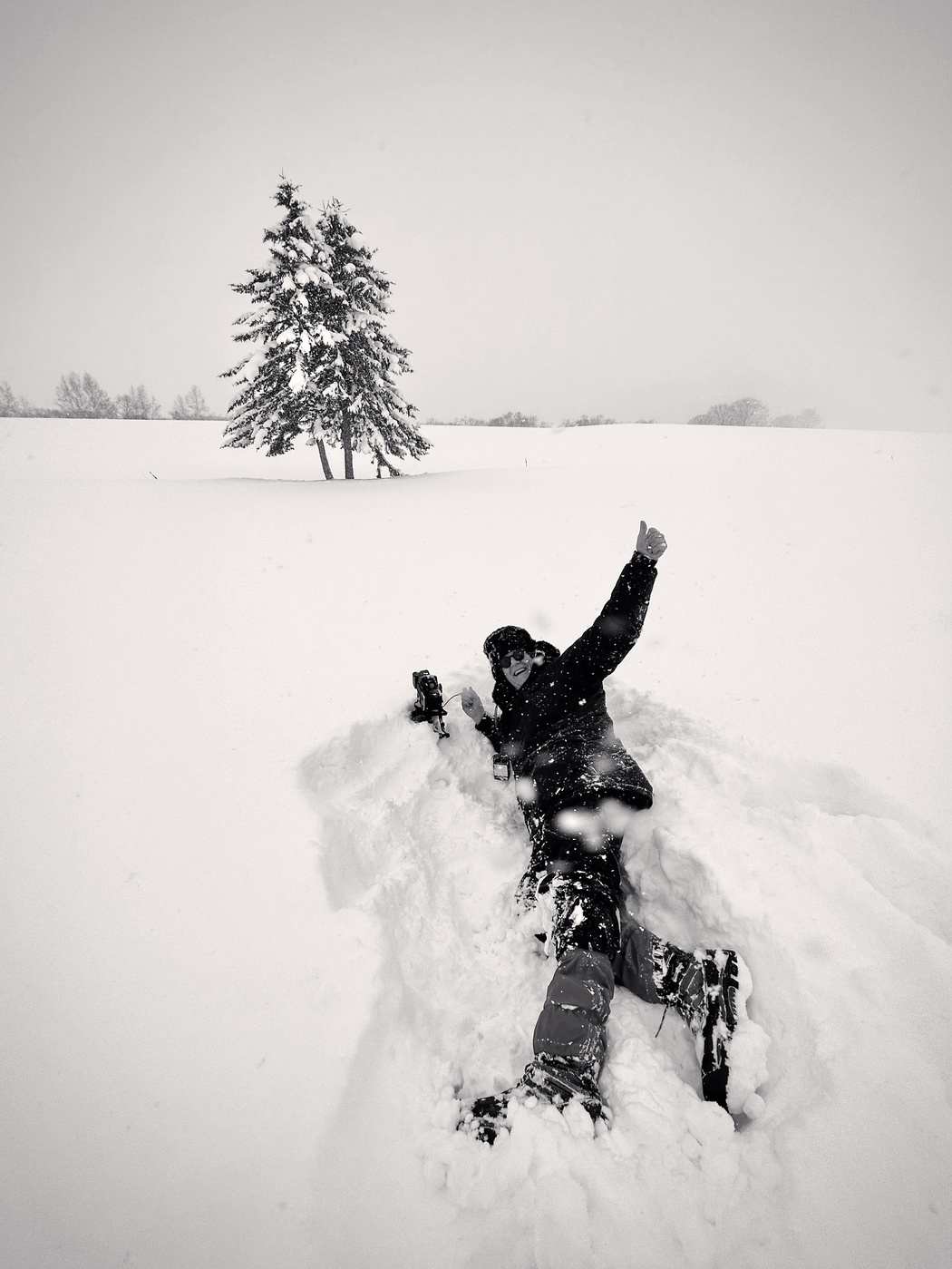 Michael Kenna, Hokkaido, Japan 2024 ©Tsuyoshi Kato
Michael Kenna, Hokkaido, Japan 2024 ©Tsuyoshi KatoMichael Kenna's Darkroom Diaries | Chapter 1
Working With Film For Over 50 YearsTo celebrate 50 years of darkroom printing, Luke Whitaker at Bosham Gallery is publishing a series of 5 chapters from Michael Kenna's Darkroom Diaries, in partnership with Black & White Photography Magazine, to accompany an online exhibition of Kenna's Artist Proofs. The online exhibition runs from 17 July - 17 December 2025.
-
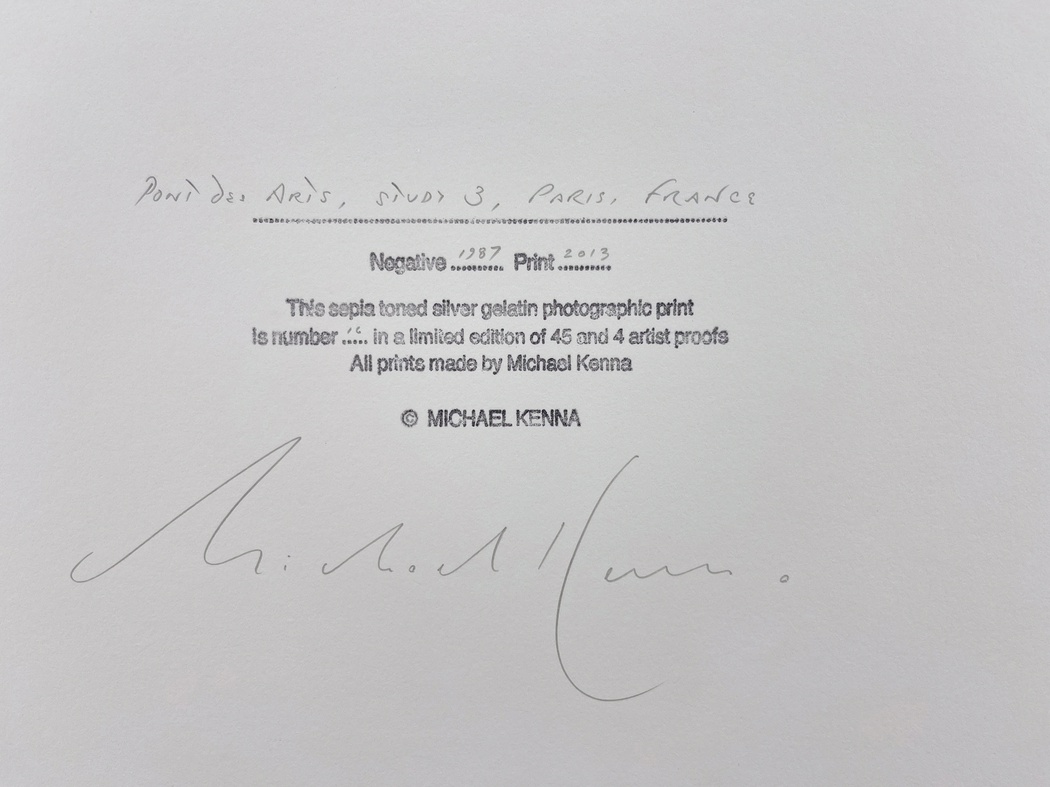 Michael Kenna's silver gelatin prints are matted and mounted on archival 16x20 inch mountboard and framed in a 15mm wide hand-painted black wooden frame moulding behind museum glass.
Michael Kenna's silver gelatin prints are matted and mounted on archival 16x20 inch mountboard and framed in a 15mm wide hand-painted black wooden frame moulding behind museum glass. -
 Michael Kenna retouches 'Pont Des Arts, Study 1, Paris, France 1987' in Bosham Gallery in 2019 © Henry Wells
Michael Kenna retouches 'Pont Des Arts, Study 1, Paris, France 1987' in Bosham Gallery in 2019 © Henry Wells -
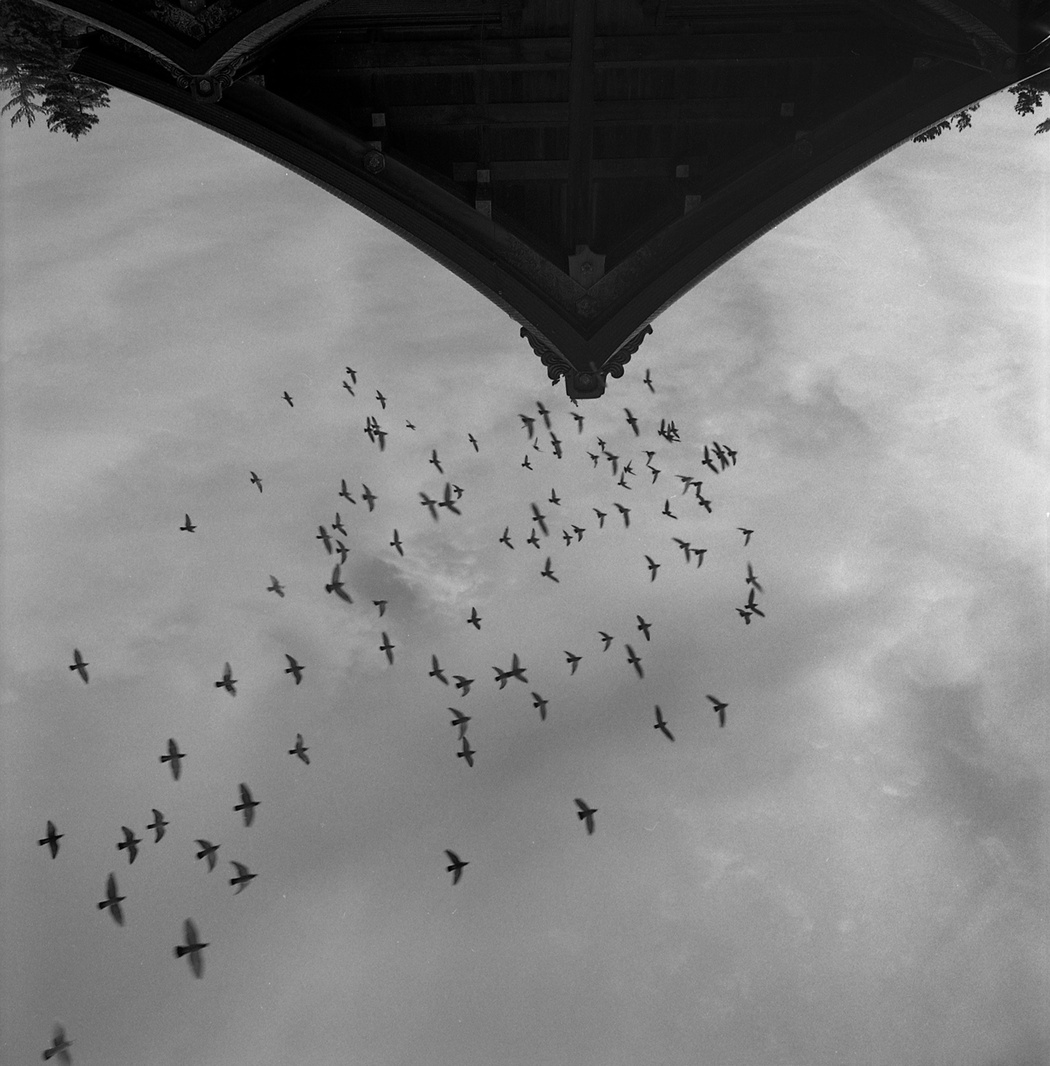 Full Frame Work Print Upside Down Of 'Nine Birds, Taisha Shrine, Honshu, Japan 2001' © Michael Kenna
Full Frame Work Print Upside Down Of 'Nine Birds, Taisha Shrine, Honshu, Japan 2001' © Michael Kenna -
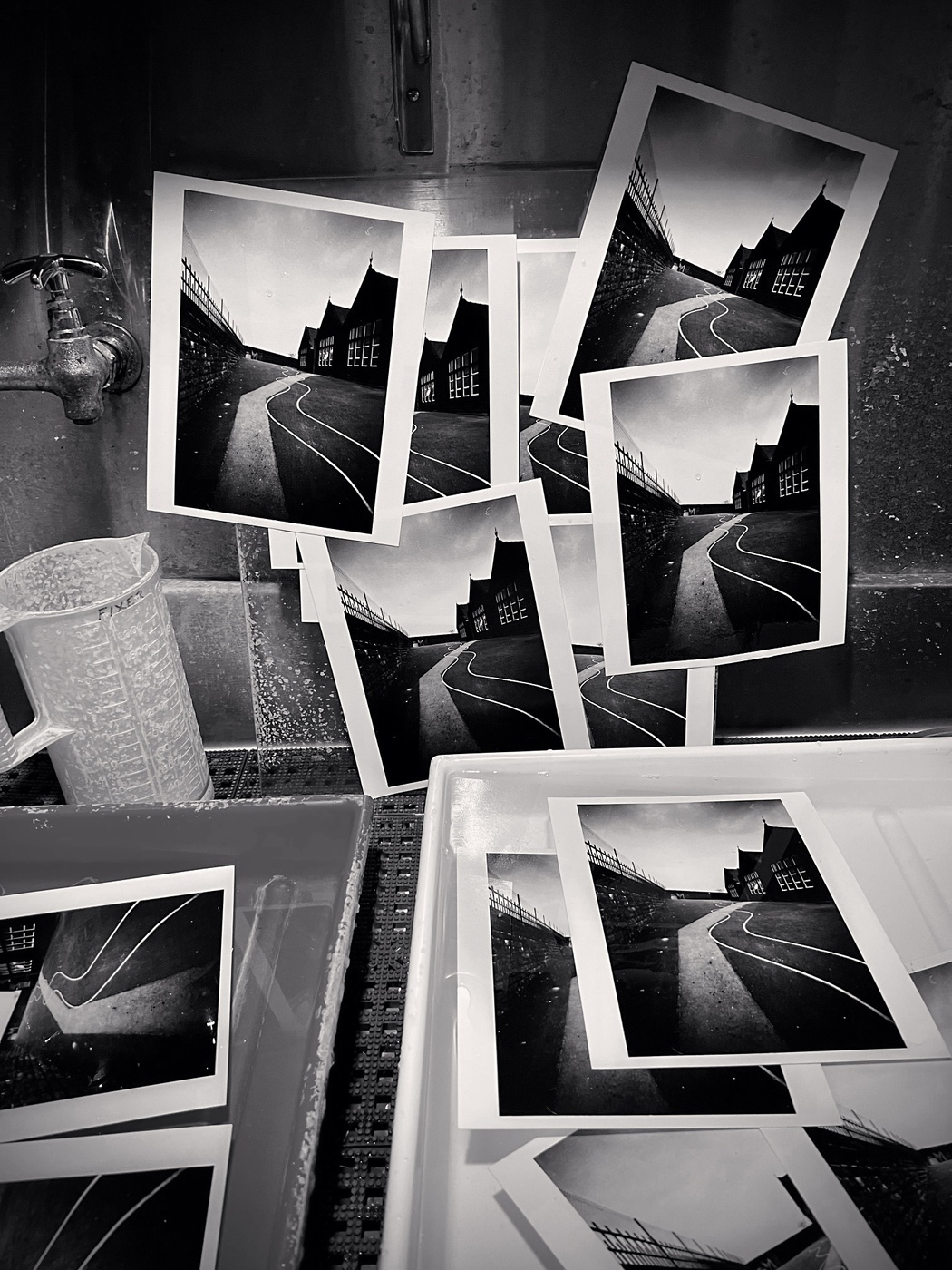 ‘Getting There’ 12 Working Prints Of 'School Yard, Heptonstall, Yorkshire, England 1983' © Michael Kenna
‘Getting There’ 12 Working Prints Of 'School Yard, Heptonstall, Yorkshire, England 1983' © Michael Kenna -
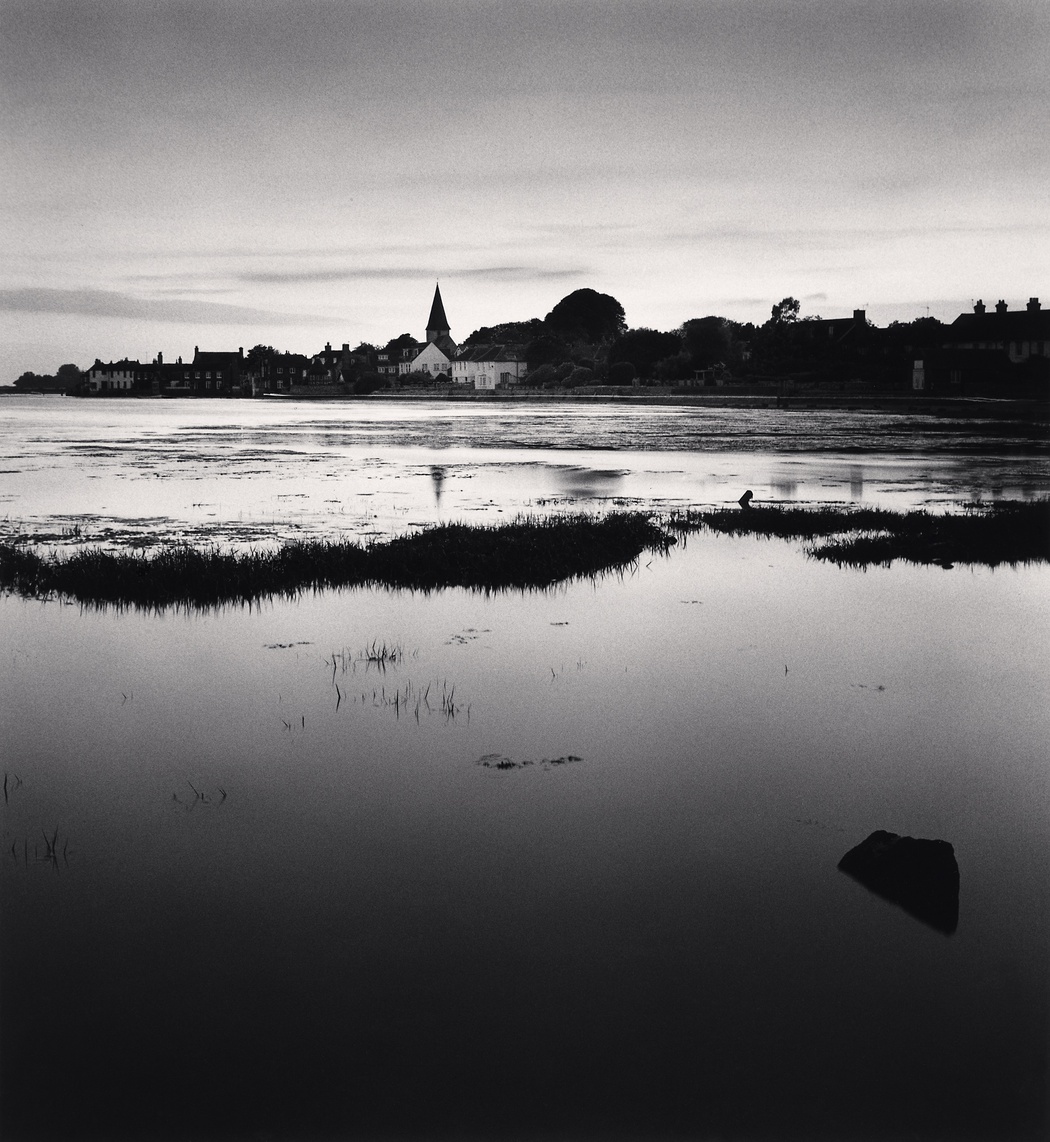 Across The Creek, Bosham, West Sussex, England 2019 © Michael Kenna
Across The Creek, Bosham, West Sussex, England 2019 © Michael Kenna -
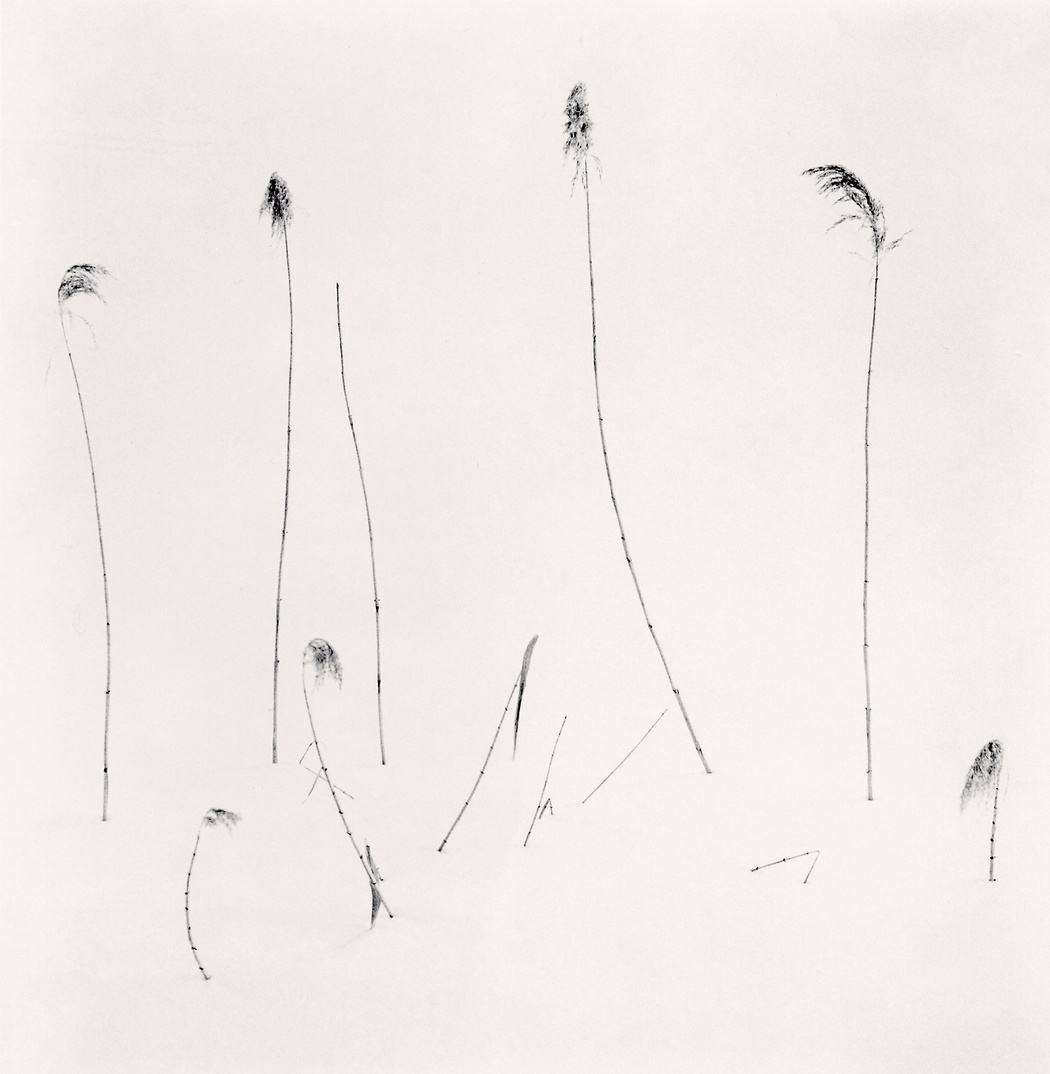 Twelve Winter Stalks, Furano, Hokkaido, Japan 2012
Twelve Winter Stalks, Furano, Hokkaido, Japan 2012 -
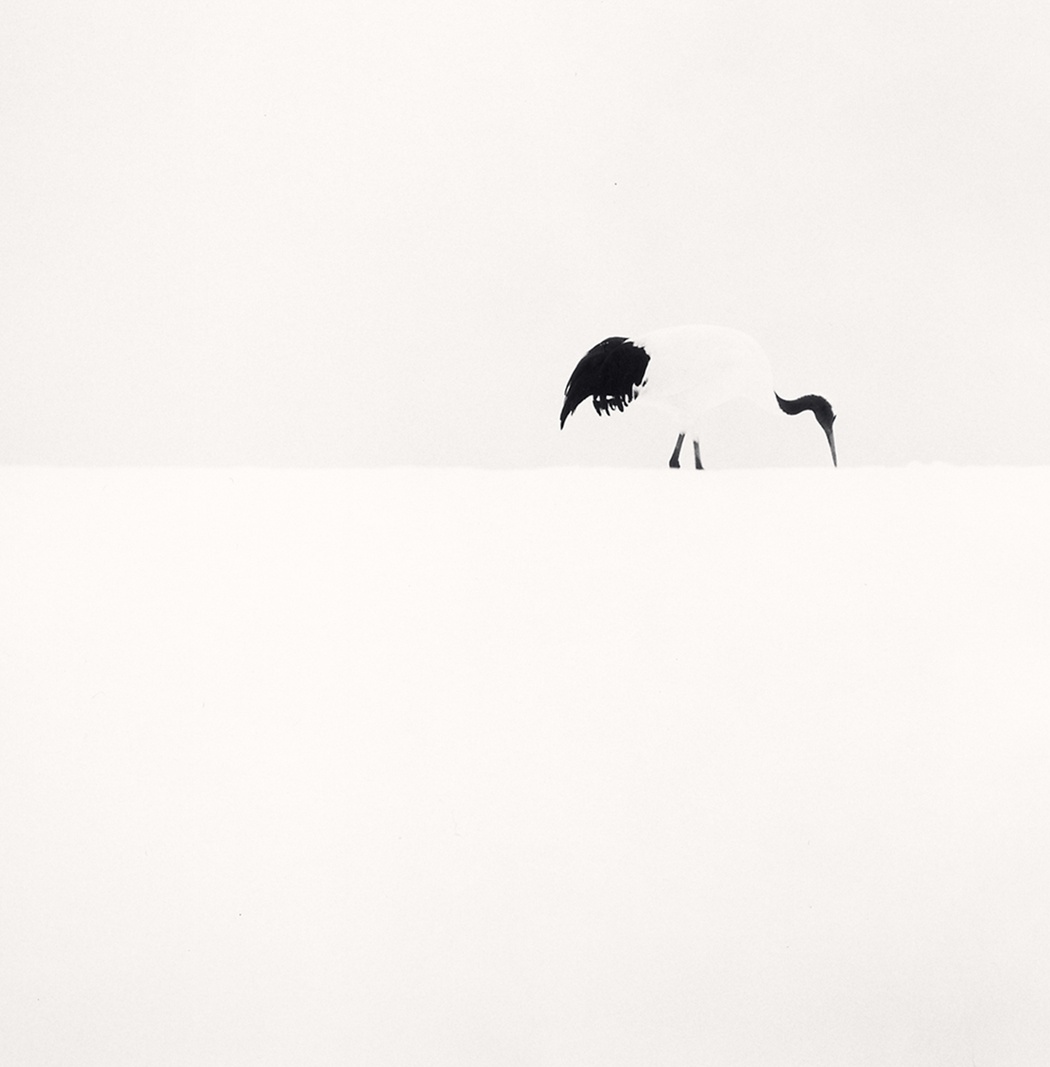 Red Crown Crane Feeding, Tsurui, Hokkaido, Japan 2005
Red Crown Crane Feeding, Tsurui, Hokkaido, Japan 2005 -
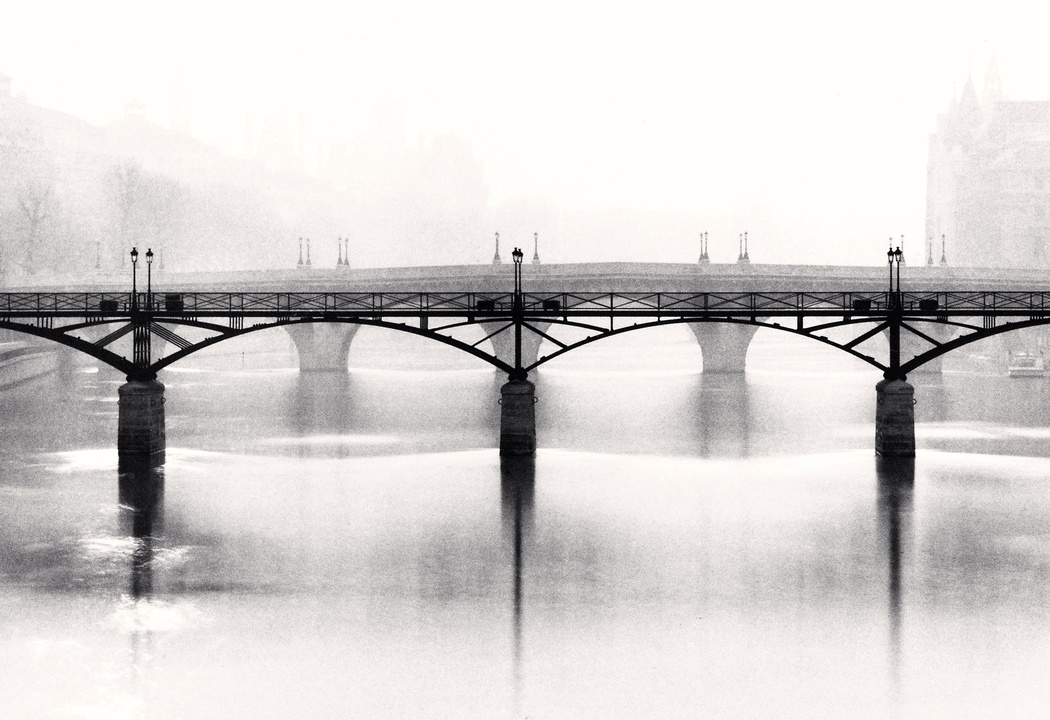
-
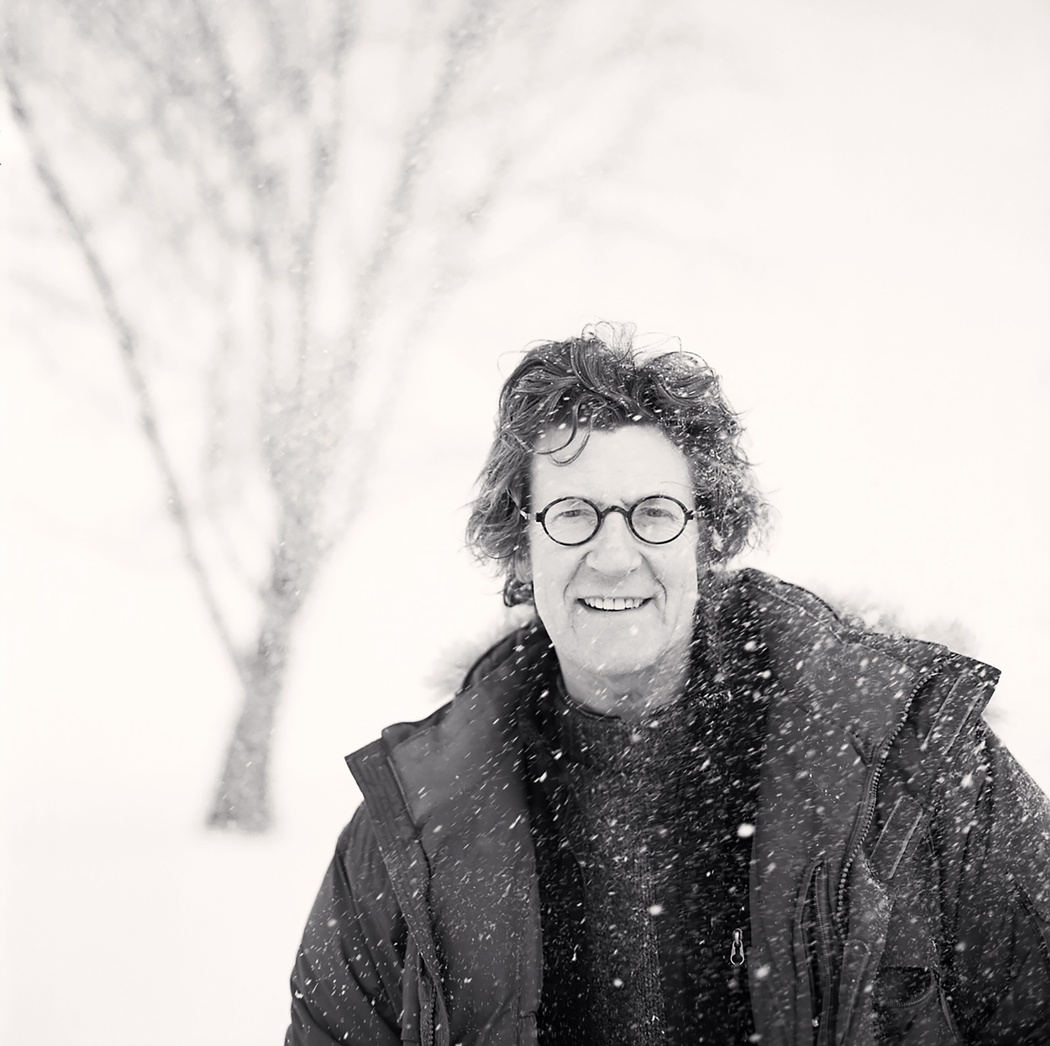 Michael Kenna, Biei, Hokkaido, Japan 2009 © Mark SilvaMichael Kenna discusses his love of Japan, and the stories behind three of his most celebrated works made between 2002 and 2004...
Michael Kenna, Biei, Hokkaido, Japan 2009 © Mark SilvaMichael Kenna discusses his love of Japan, and the stories behind three of his most celebrated works made between 2002 and 2004... -
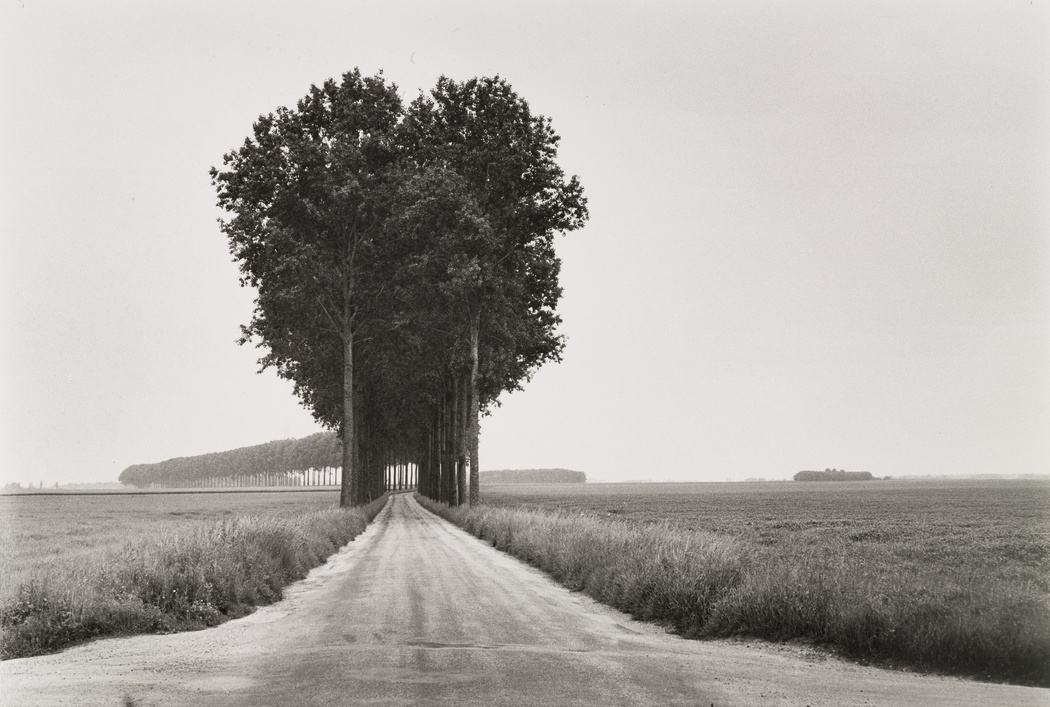 Brie, Brittany, France 1968 © Henri Cartier BressonIn the third of a series of four articles tracing the career of Michael Kenna, Michael discusses the work of French photographer Henri Cartier-Bresson (1908-2004), one of the most original, accomplished, influential and beloved figures in the history of photography.
Brie, Brittany, France 1968 © Henri Cartier BressonIn the third of a series of four articles tracing the career of Michael Kenna, Michael discusses the work of French photographer Henri Cartier-Bresson (1908-2004), one of the most original, accomplished, influential and beloved figures in the history of photography. -
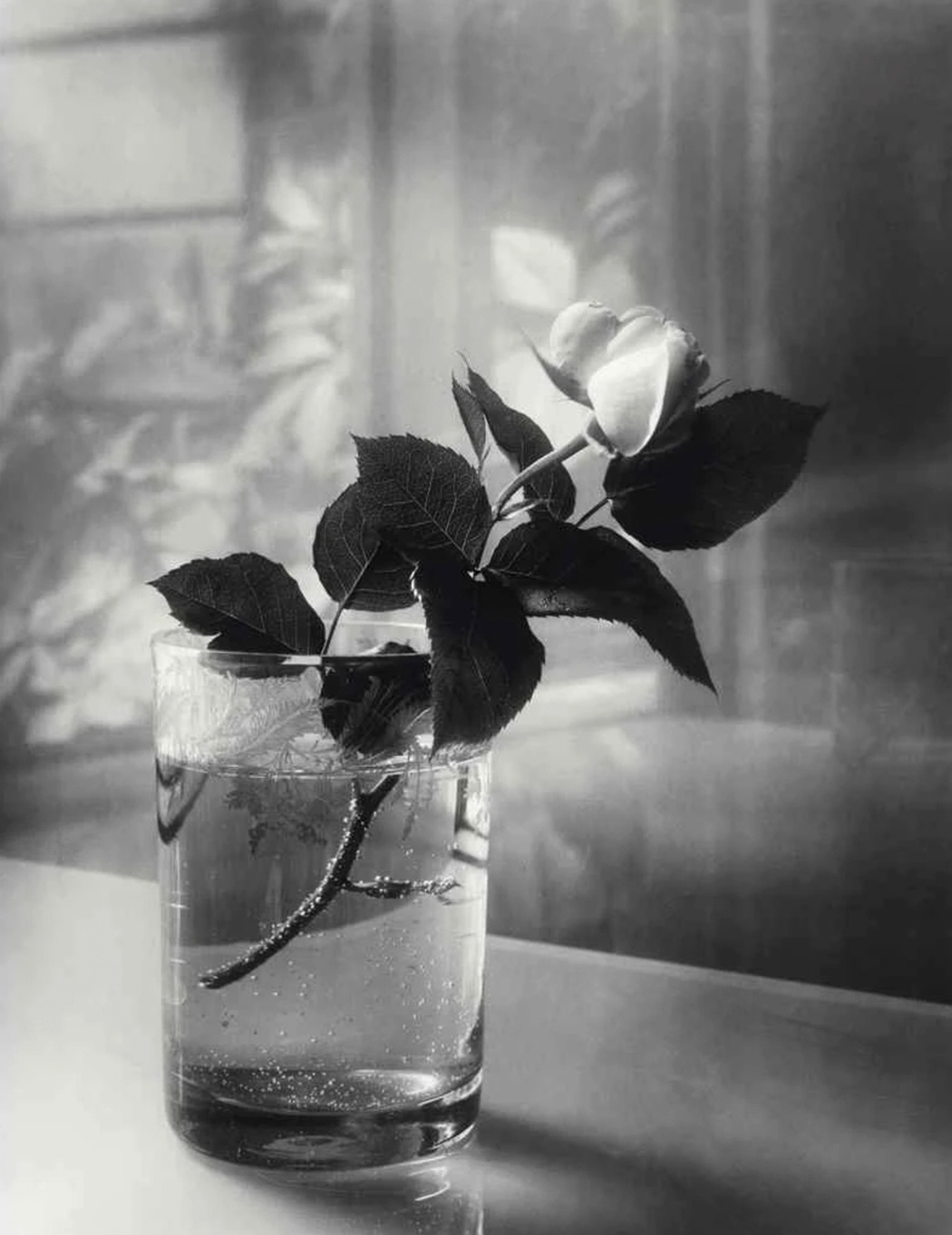 White Rose In A Glass 1952 © Josef SudekIn the fourth and final article in a series tracing the career of Michael Kenna, Michael discusses the influence of Czech photographer Josef Sudek, dubbed the ‘Poet of Prague’, who was best known for his lyrical and poetic black-and-white images of Prague, and intimate still life’s taken in and around his studio.
White Rose In A Glass 1952 © Josef SudekIn the fourth and final article in a series tracing the career of Michael Kenna, Michael discusses the influence of Czech photographer Josef Sudek, dubbed the ‘Poet of Prague’, who was best known for his lyrical and poetic black-and-white images of Prague, and intimate still life’s taken in and around his studio. -
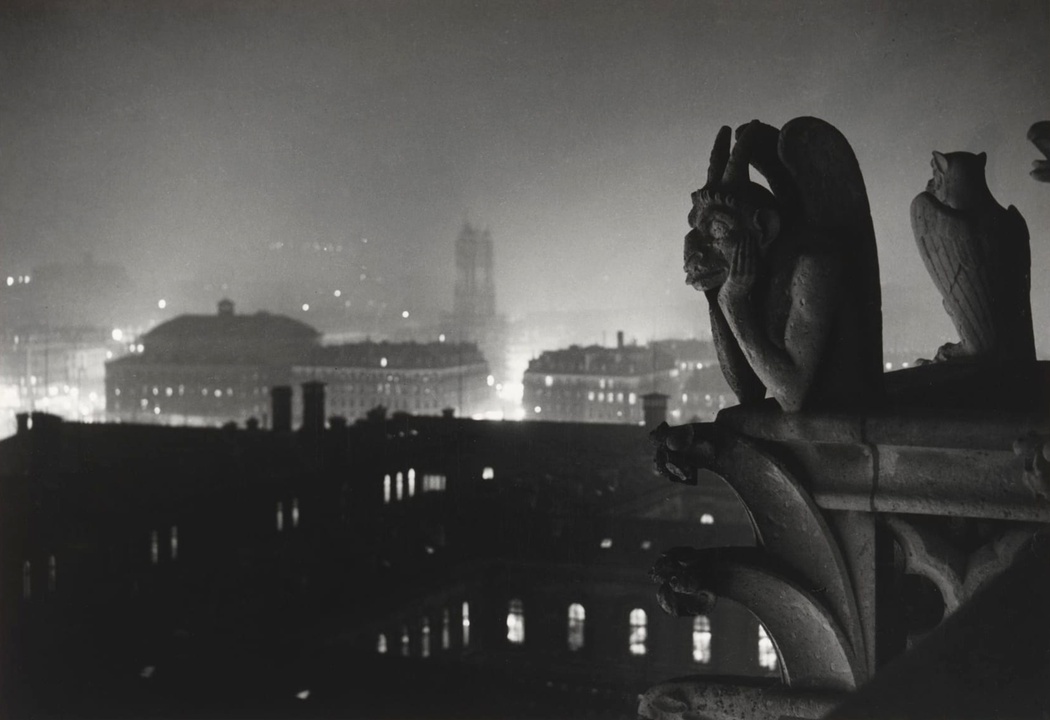 Notre-Dame de Paris, 1934 © BrassaïIn the second of four articles tracing the career of Michael Kenna, Michael discusses the influence of the Hungarian-French photographer Gyula Halász (1899-1984) or Brassaï (the pseudonym by which he has become much better known)
Notre-Dame de Paris, 1934 © BrassaïIn the second of four articles tracing the career of Michael Kenna, Michael discusses the influence of the Hungarian-French photographer Gyula Halász (1899-1984) or Brassaï (the pseudonym by which he has become much better known) -
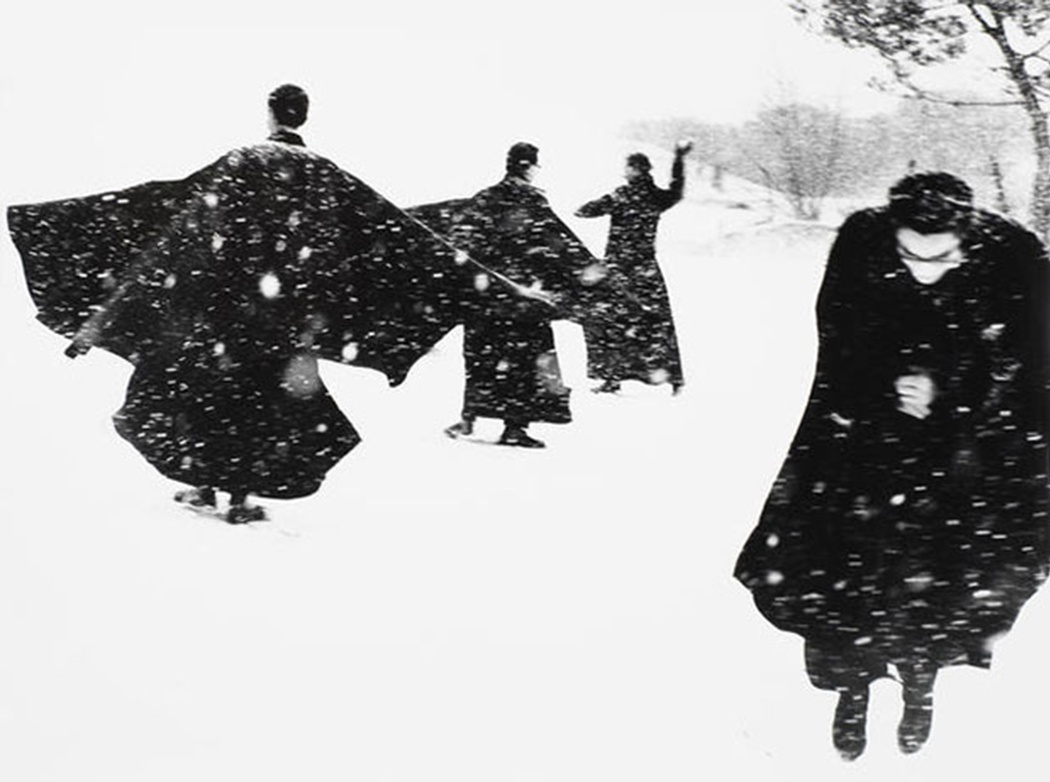 Dancing Seminarians, Senigallia, Italy 1961 © Mario GiacomelliIn the first of four articles tracing the career of Michael Kenna we hear Michael reflect on the work of Italian photographer Mario Giacomelli (1925-2000), whose work is widely regarded as some of the most original photography of the twentieth century.
Dancing Seminarians, Senigallia, Italy 1961 © Mario GiacomelliIn the first of four articles tracing the career of Michael Kenna we hear Michael reflect on the work of Italian photographer Mario Giacomelli (1925-2000), whose work is widely regarded as some of the most original photography of the twentieth century. -
 Ponte Vecchio, Florence, Italy 1988 © Michael Kenna
Ponte Vecchio, Florence, Italy 1988 © Michael KennaMichael Kenna's 1988 Photograph of The Ponte Vecchio, Florence
Picture/Story by Michael KennaThere can be doubt that Florence is one of the most beautiful and romantic cities on the face of the earth. I have had the good fortune to have made sporadic visits there since the seventies. -
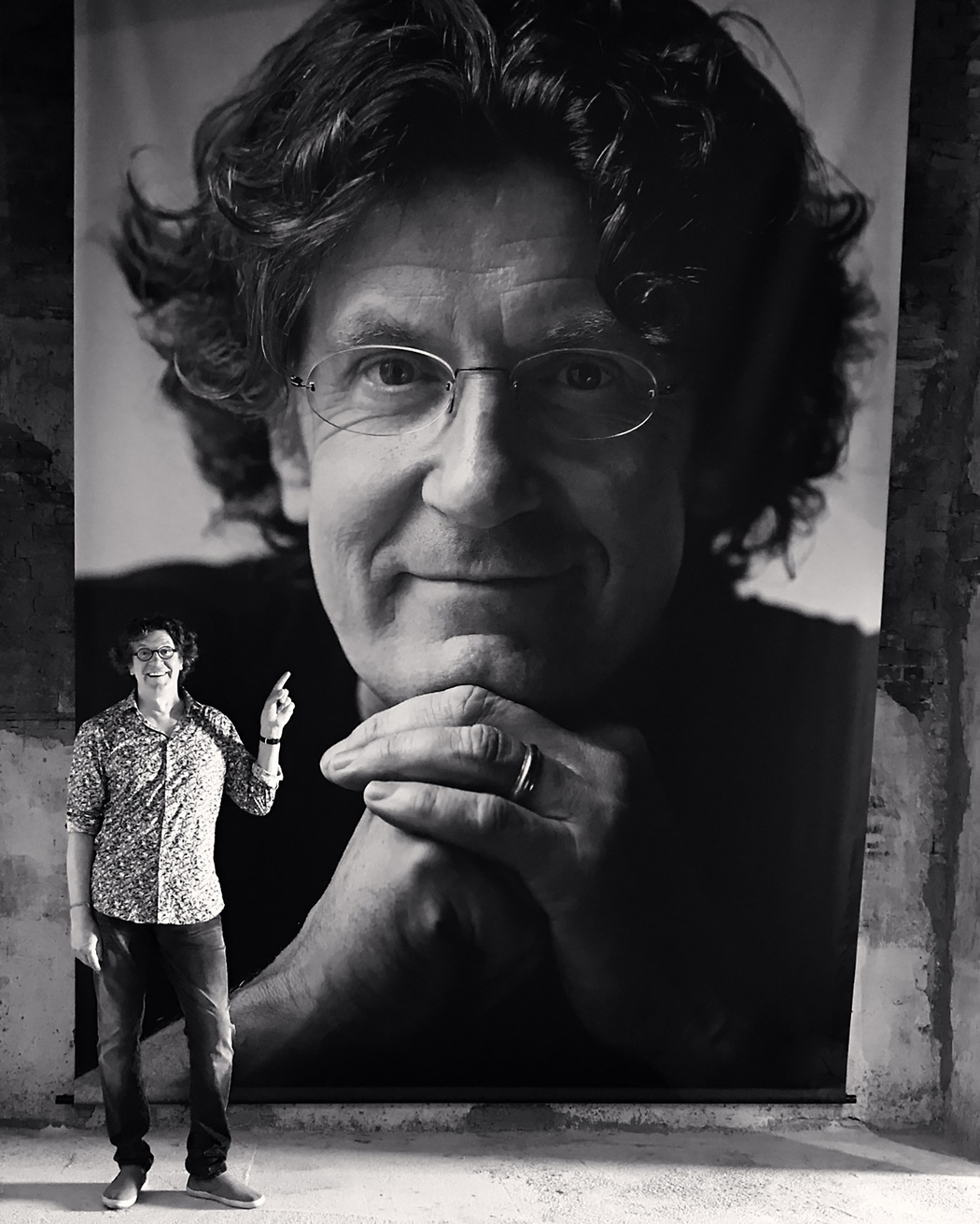 Michael Kenna By Vincenzo Di Pompeo 2017 © All Rights ReservedA collection of favourite portraits of photographer Michael Kenna...
Michael Kenna By Vincenzo Di Pompeo 2017 © All Rights ReservedA collection of favourite portraits of photographer Michael Kenna... -
 Pont Des Arts, Paris, France 1987 by Michael Kenna
Pont Des Arts, Paris, France 1987 by Michael KennaWorld-renowned photographer Michael Kenna, one of the most collected artists of his generation, has been given a top arts award by the French Government and has donated his lifetime’s work to France.
-

Before an artist makes an edition of prints, they must first make an Artist Proof. Artist Proofs are typically printed before the numbered edition and are used as a way for the artist to make final adjustments to the photograph or to experiment with different combinations of tone or colour. A simple way of understanding an Artist Proof is to think of it as a finalised print that the photographer approves to sign off the production of the Limited Edition.
-
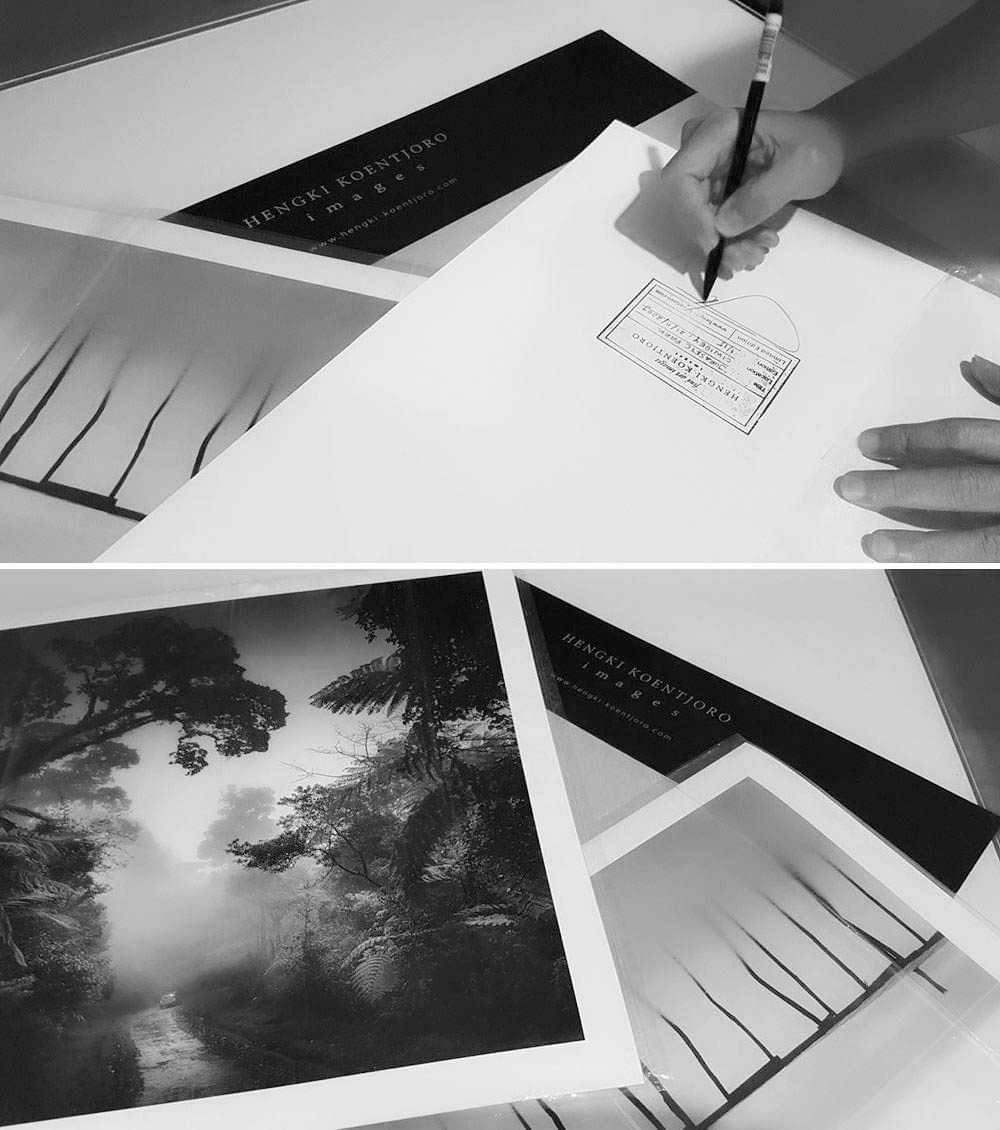
Hengki Koentjoro | Print Provenance
Limited Editions of 35 PrintsHengki Koentjoro makes all of his archival pigment prints himself personally, at his studio in Indonesia. -
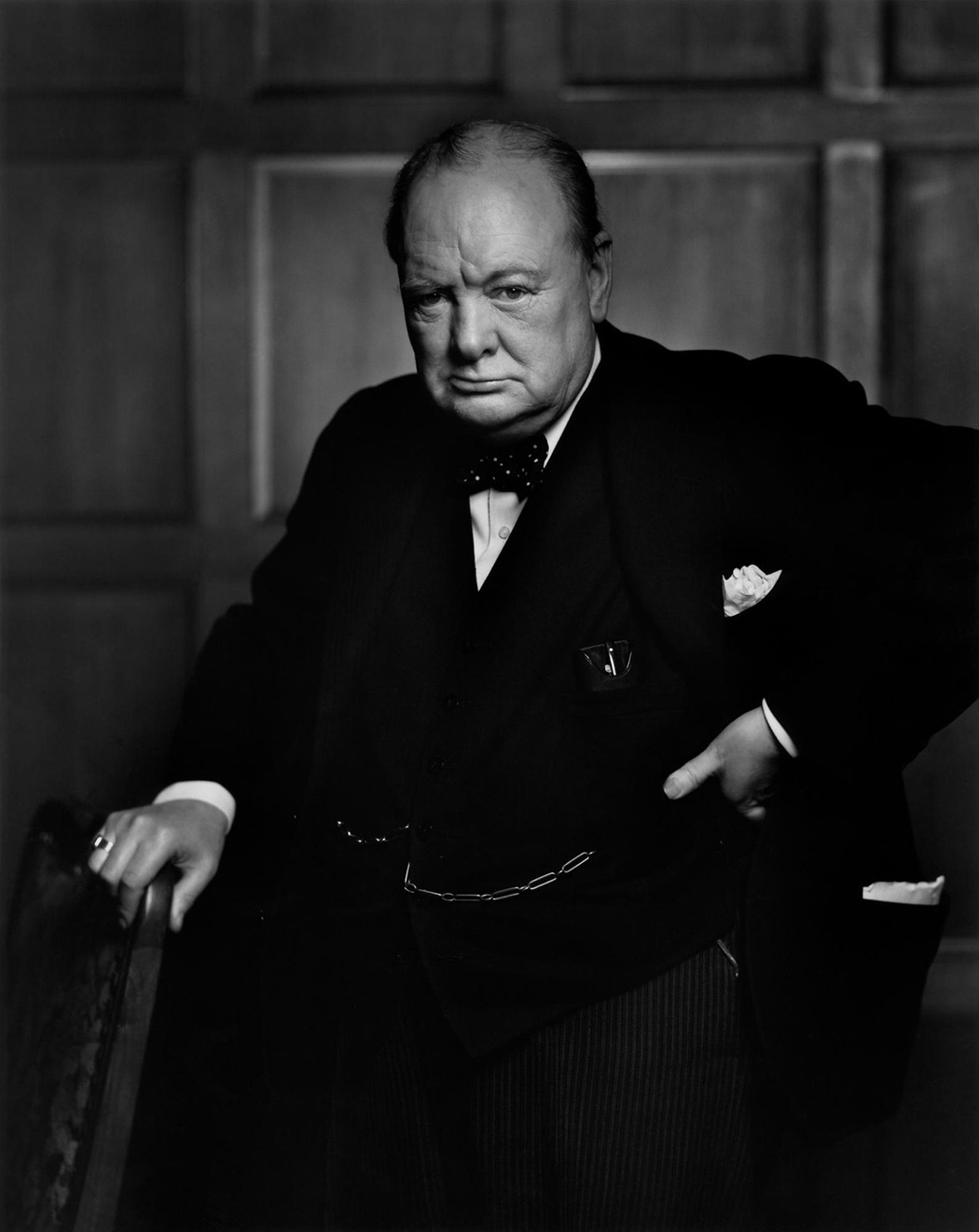
The Roaring Lion, Winston Churchill, 1941 by Yousuf Karsh (1908-2002)
20x24" (51x61cm) Signed Silver Gelatin PrintI am pleased to present an opportunity to acquire a very famous print The Roaring Lion, Winston Churchill, 1941 by Yousuf Karsh (1908-2002), an Armenian-Canadian photographer known for taking the definitive portraits of the men and women who shaped the twentieth century. This iconic photograph is widely regarded as one of the most important portraits in the history of photography. Read on to hear the amusing story behind this famous photograph, along with details of this rare signed print which is offered for sale in very fine condition. -
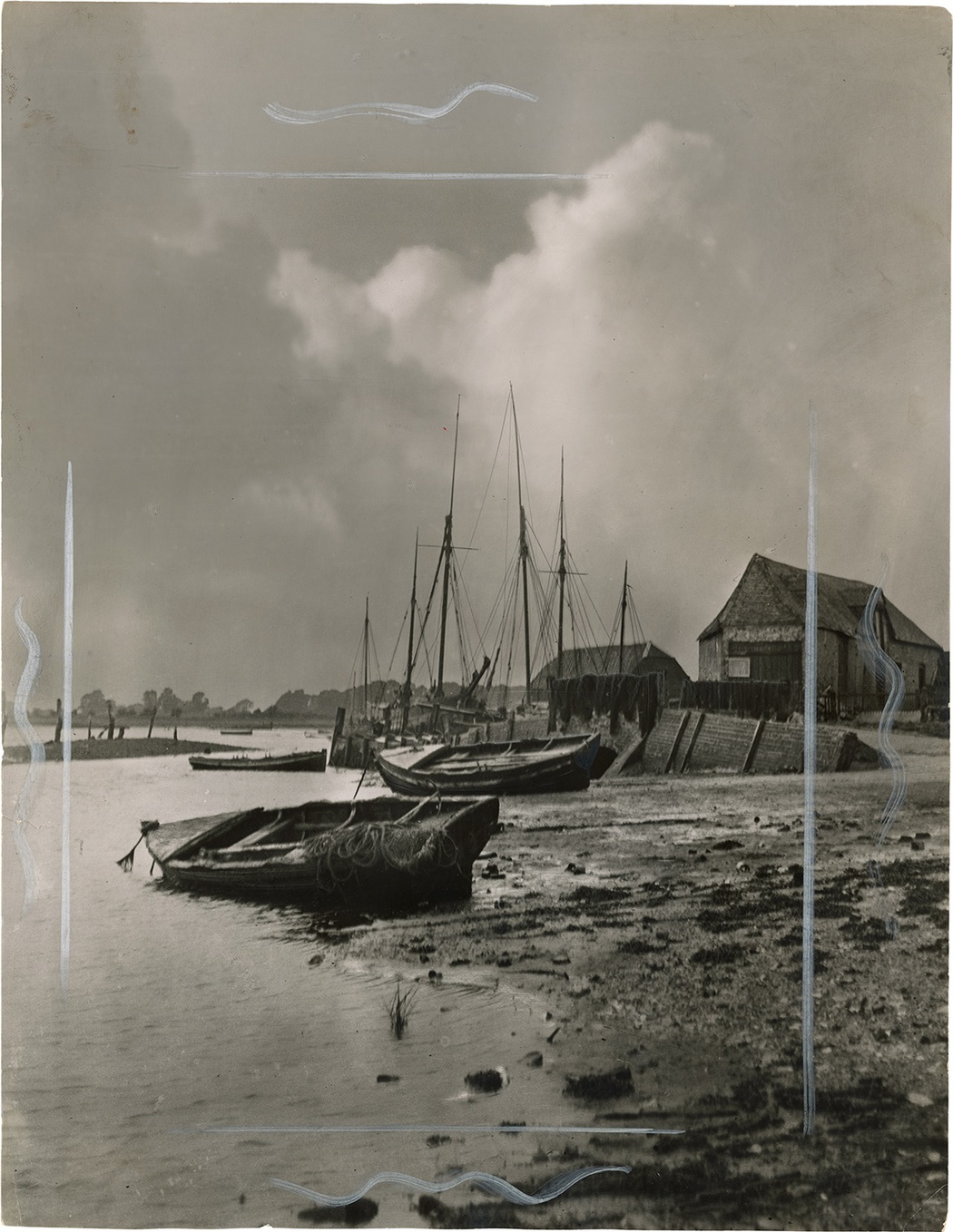
RARE | Silver Gelatin Print Of Bosham's Fishing Fleet 1914
The Fishing Fleet, Bosham, England 1914 | Bertram C Wickison FRPSI am pleased to present an opportunity to acquire an extremely rare and beautiful original silver gelatin photograph of Bosham’s fishing fleet in 1914, with a fascinating provenance. The photograph has been made very much in the pictorialist style of the day, an international art movement that dominated from 1880-1915 when an argument raged about whether photographs were art, and photographers deliberately made their pictures look like paintings. Photographers typically made their prints darker than we are used to seeing today, with subdued highlights, they used soft focus lenses to convey atmosphere, and often toned them warm brown rather than straight black and white. -
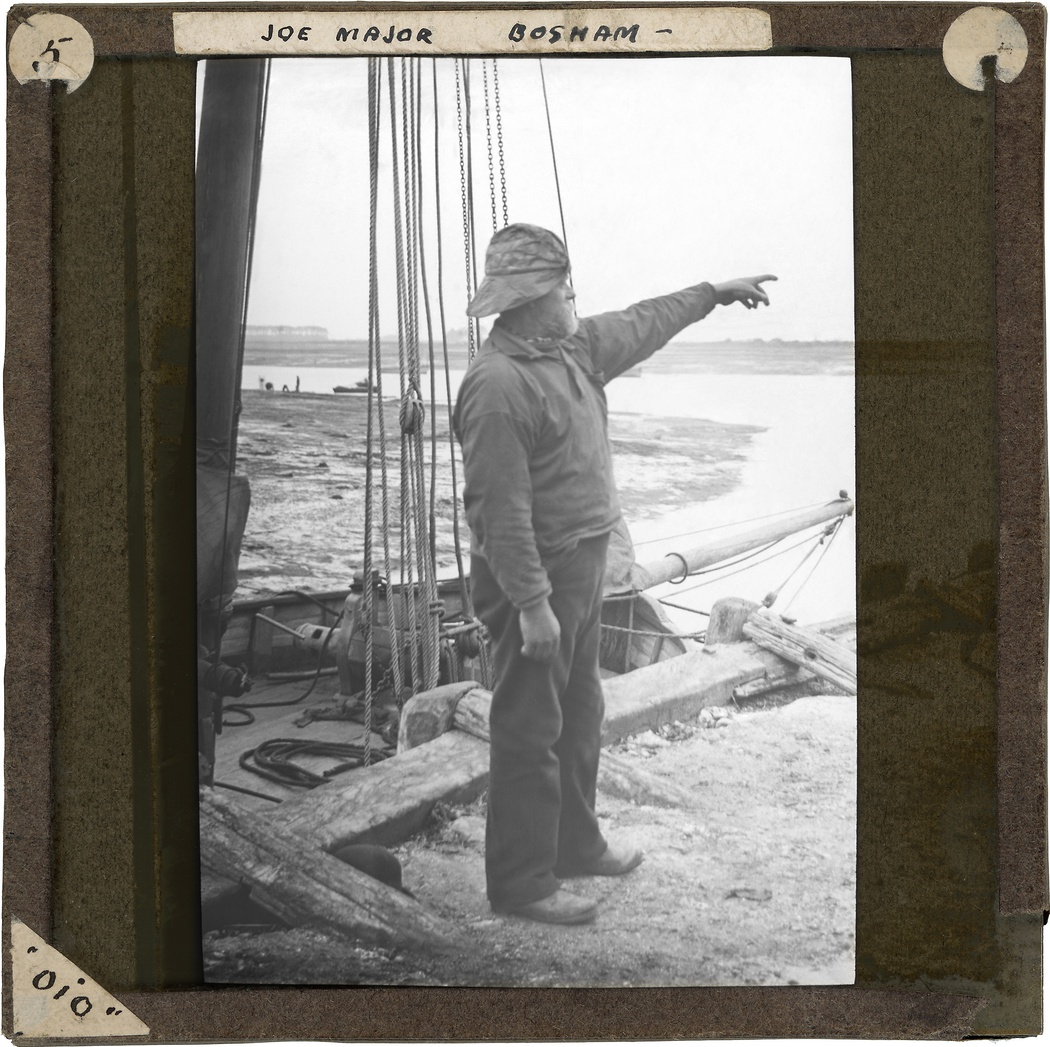
-
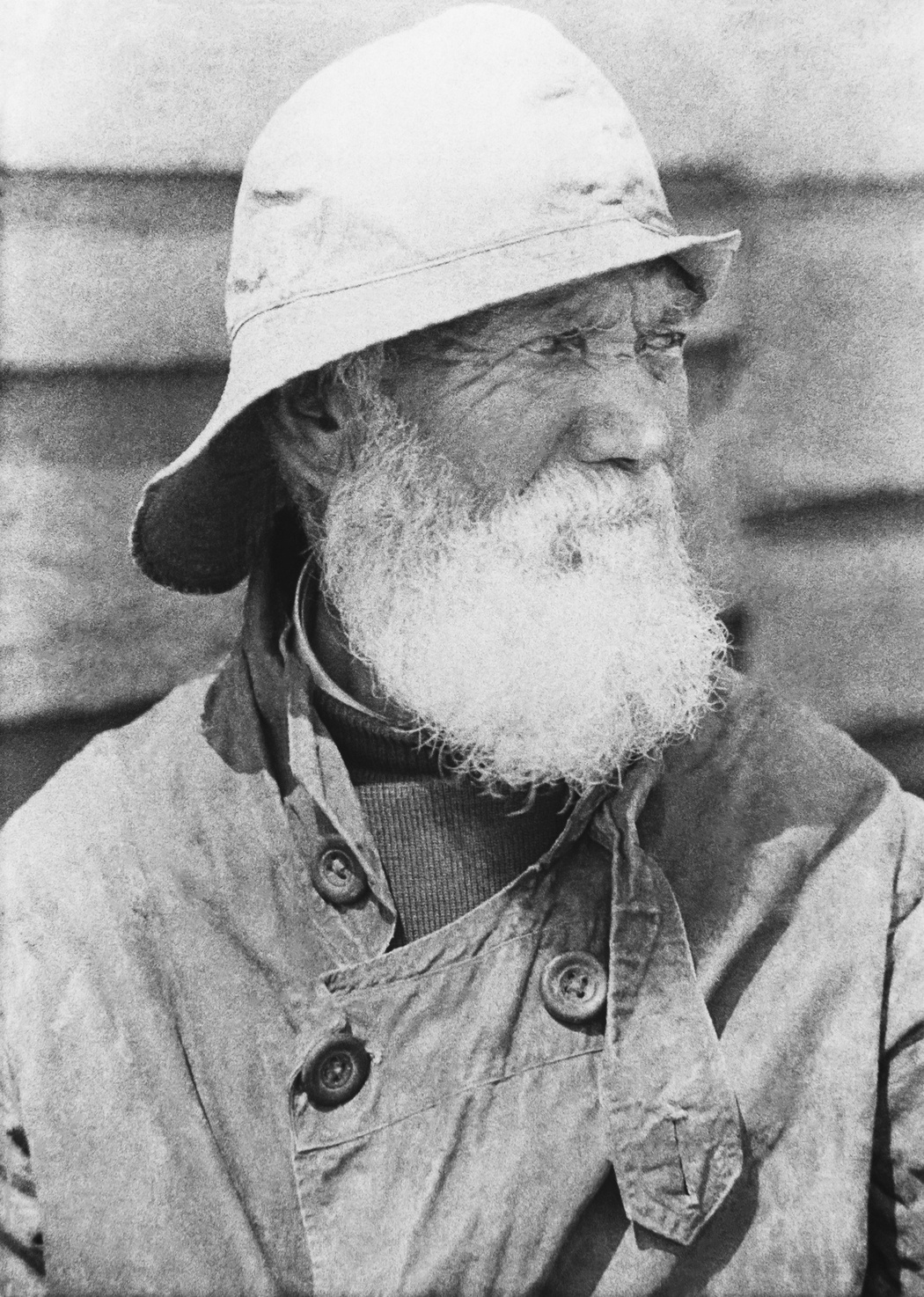 Oyster Fisherman, Bosham, England c1900
Oyster Fisherman, Bosham, England c1900 -
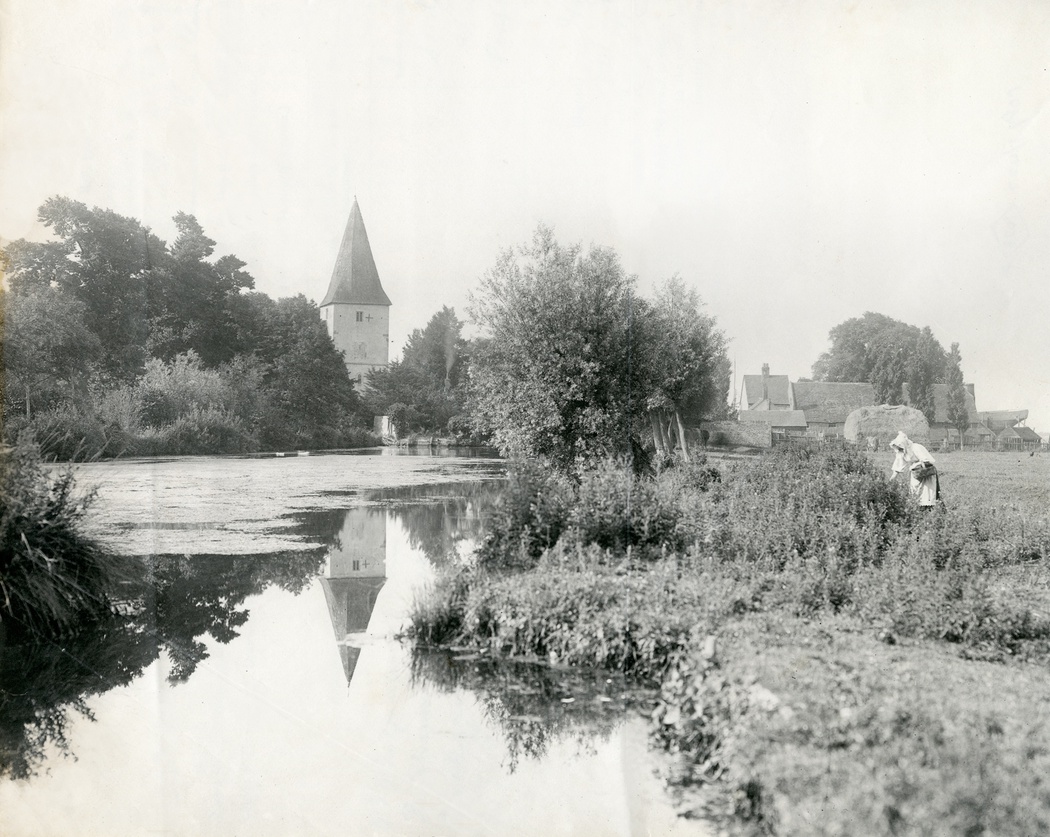 Photograph of view at Bosham, church in background, water in foreground, 1896I still enjoy collecting old photographs of Bosham and thought you might be interested to see two recent additions to my archive below, which I have licensed from the National Archives in Kew for a book of Bosham photographs, and am slowly compiling. The two prints were originally deposited into the National Archives in December 1896, and I have included the copyright entries that I was sent by their Image Library Manager for your interest too...
Photograph of view at Bosham, church in background, water in foreground, 1896I still enjoy collecting old photographs of Bosham and thought you might be interested to see two recent additions to my archive below, which I have licensed from the National Archives in Kew for a book of Bosham photographs, and am slowly compiling. The two prints were originally deposited into the National Archives in December 1896, and I have included the copyright entries that I was sent by their Image Library Manager for your interest too... -
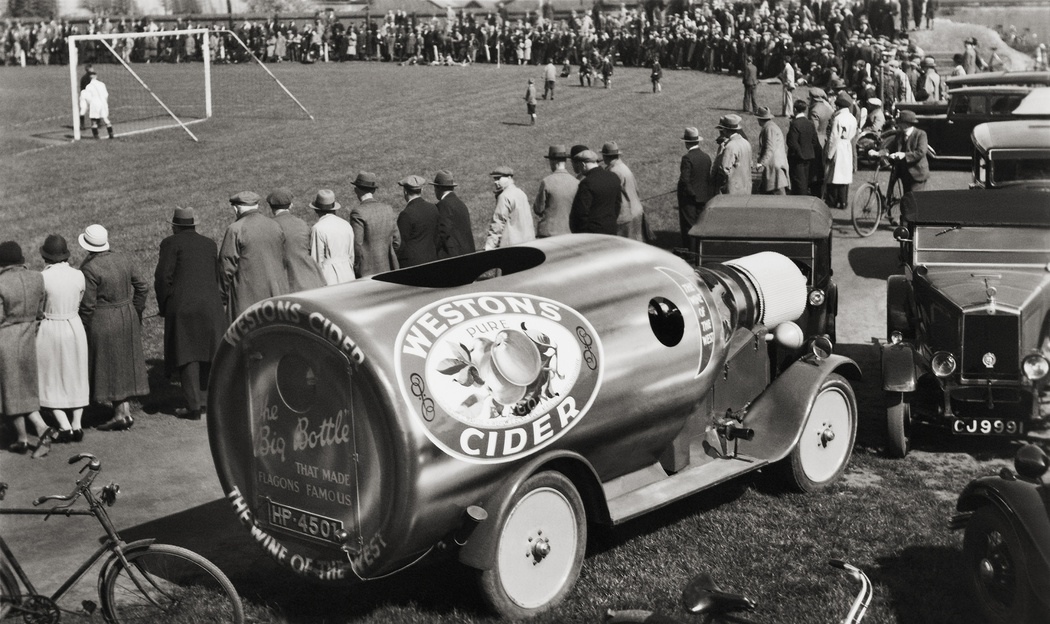 I have recently finished setting up a significant photography archive for Westons Cider in Much Marcle, Herefordshire and I thought you might enjoy seeing a few of the photographs...
I have recently finished setting up a significant photography archive for Westons Cider in Much Marcle, Herefordshire and I thought you might enjoy seeing a few of the photographs... -
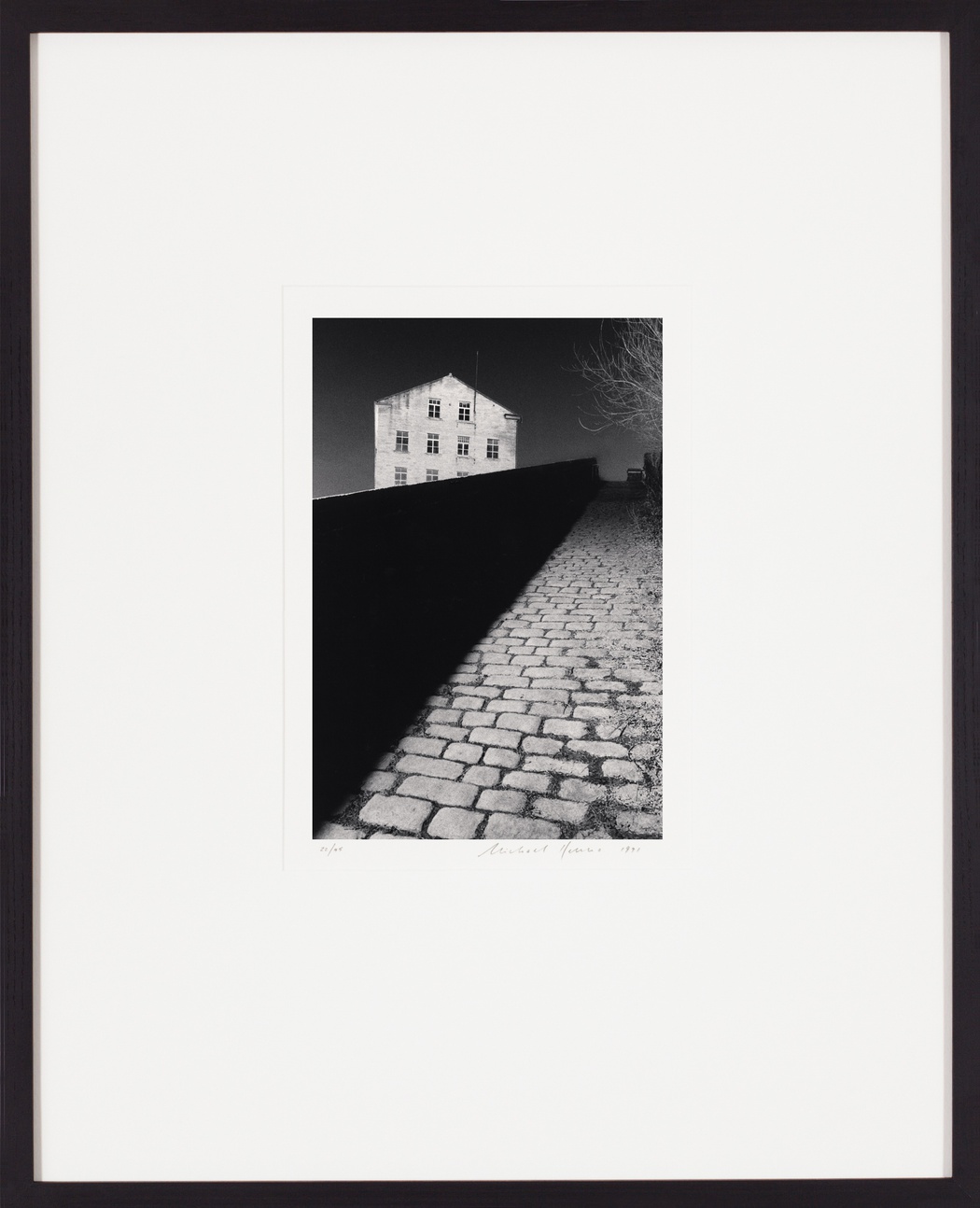 Bill Brandt's Snicket, Halifax, Yorkshire, England 1986 by Michael Kenna
Bill Brandt's Snicket, Halifax, Yorkshire, England 1986 by Michael KennaFraming photographic prints is a whole art in itself, and there are a myriad of considerations to get ‘just right’ in order to enhance the visual impact of the photograph. Here are my top tips…
-
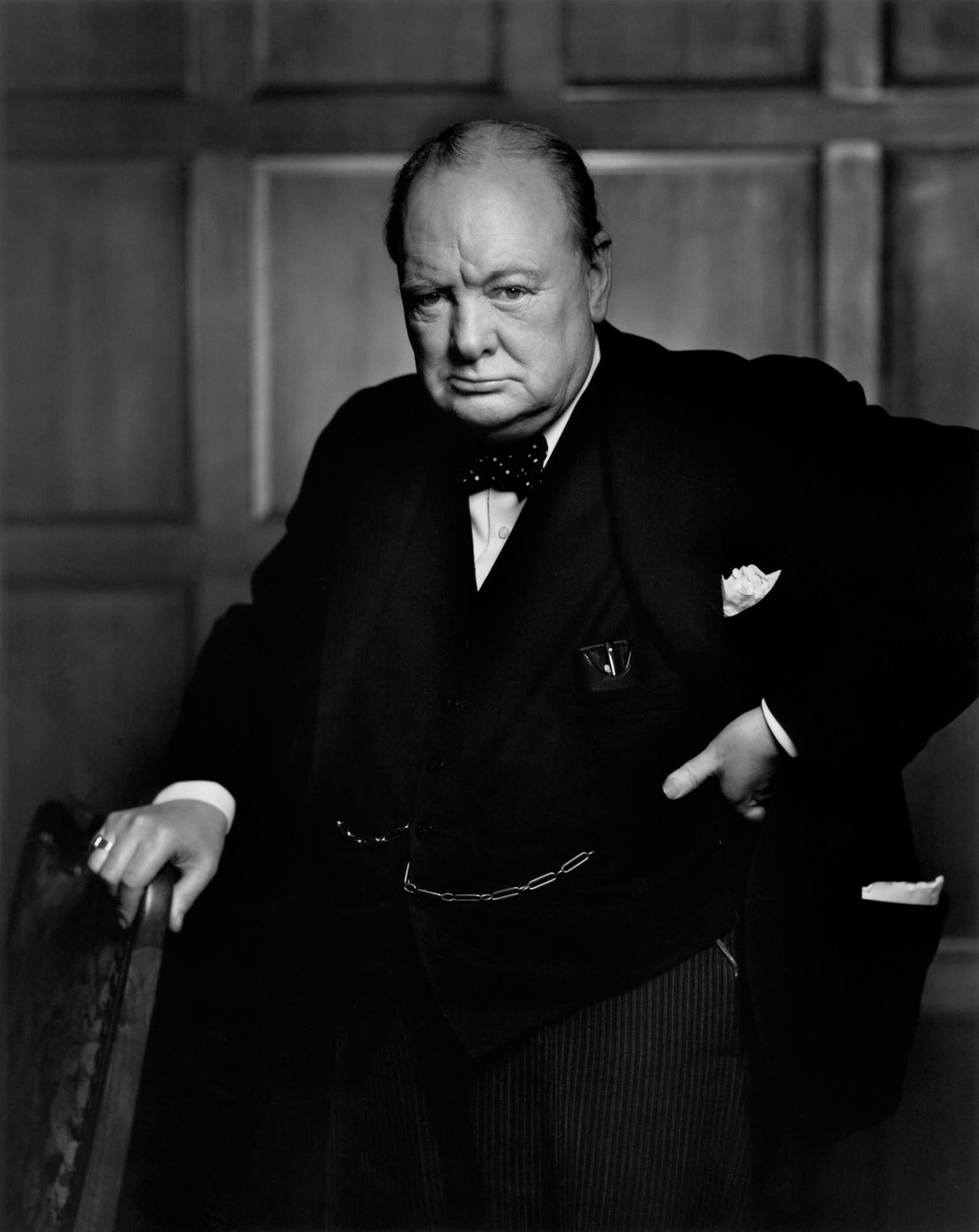 The Roaring Lion, Winston Churchill, 1941 | Yousuf Karsh
The Roaring Lion, Winston Churchill, 1941 | Yousuf KarshGuide To Photographic Print Processes
Darkroom And Digital PrintsIn photography’s near 200-year history a great variety of printing processes have been used to make prints, which can be broadly divided into two categories – traditional wet chemistry prints made in a darkroom using light-sensitive paper and chemical baths, and contemporary digital prints made by fine droplets of ink deposited onto the printing paper (no chemicals). The characteristics of each printing process give the prints a distinct ‘look and feel’ in terms of how sharply defined and detailed the image content is, the print’s tonal range, its texture and the longevity of the print.
-
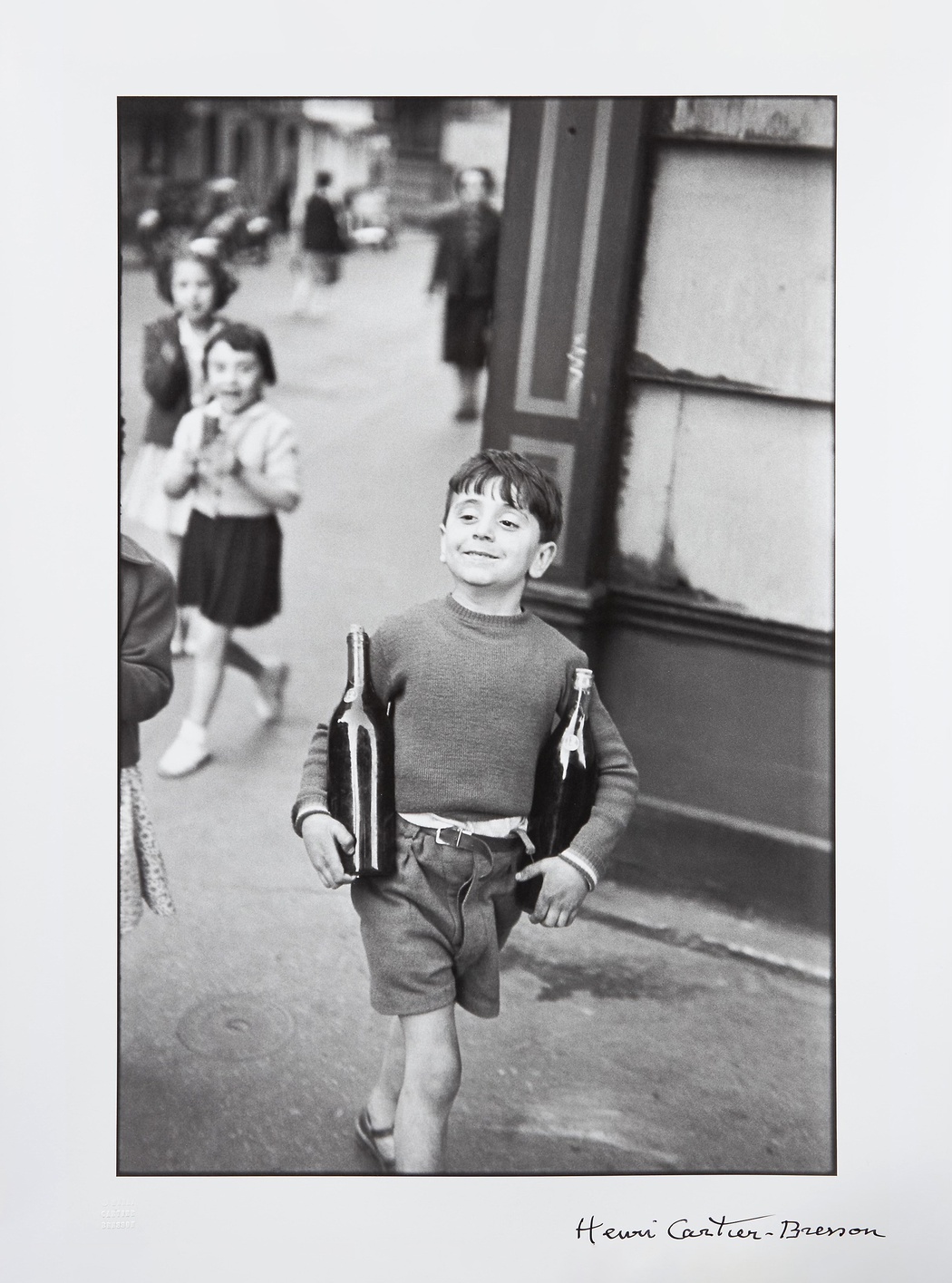
Are you thinking of buying a photograph, or perhaps starting a collection? Here are my top tips to get you started with a few examples of prints I've collected over the years...
-
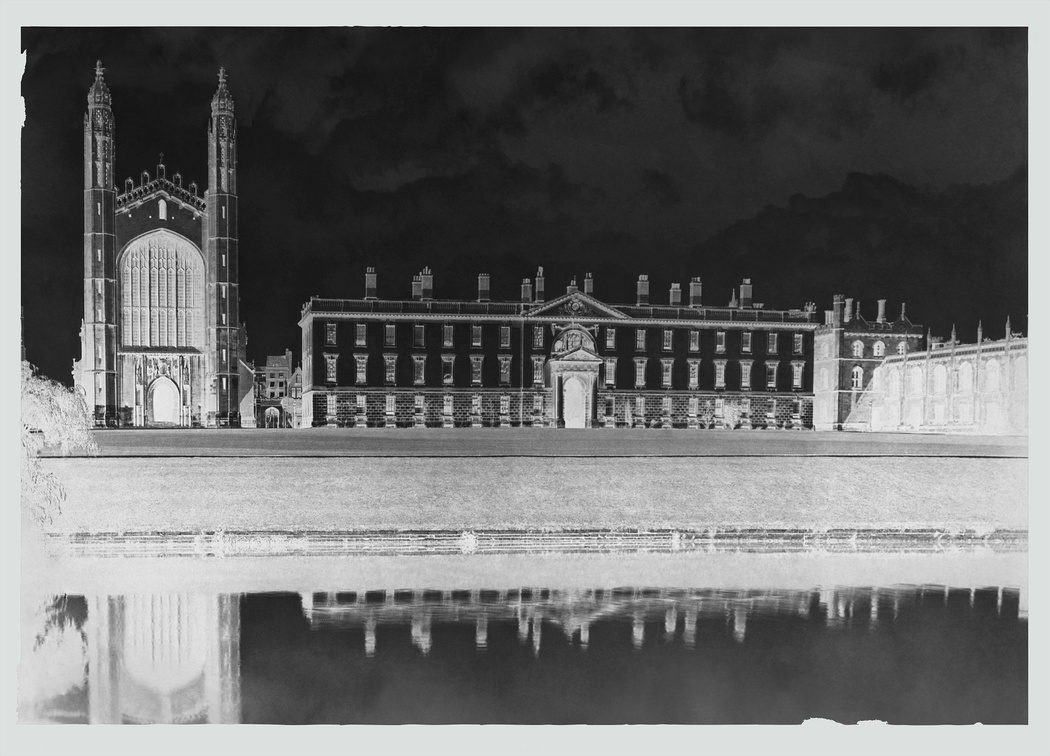 Glass Plate Negative Of King's College Chapel & Fellows' Buildings, Cambridge by George Washington WilsonPhotographic ‘plates’ preceded photographic film as a capture medium in photography. The light-sensitive emulsion of silver salts was coated onto a glass plate, typically thinner than common window glass.
Glass Plate Negative Of King's College Chapel & Fellows' Buildings, Cambridge by George Washington WilsonPhotographic ‘plates’ preceded photographic film as a capture medium in photography. The light-sensitive emulsion of silver salts was coated onto a glass plate, typically thinner than common window glass. -
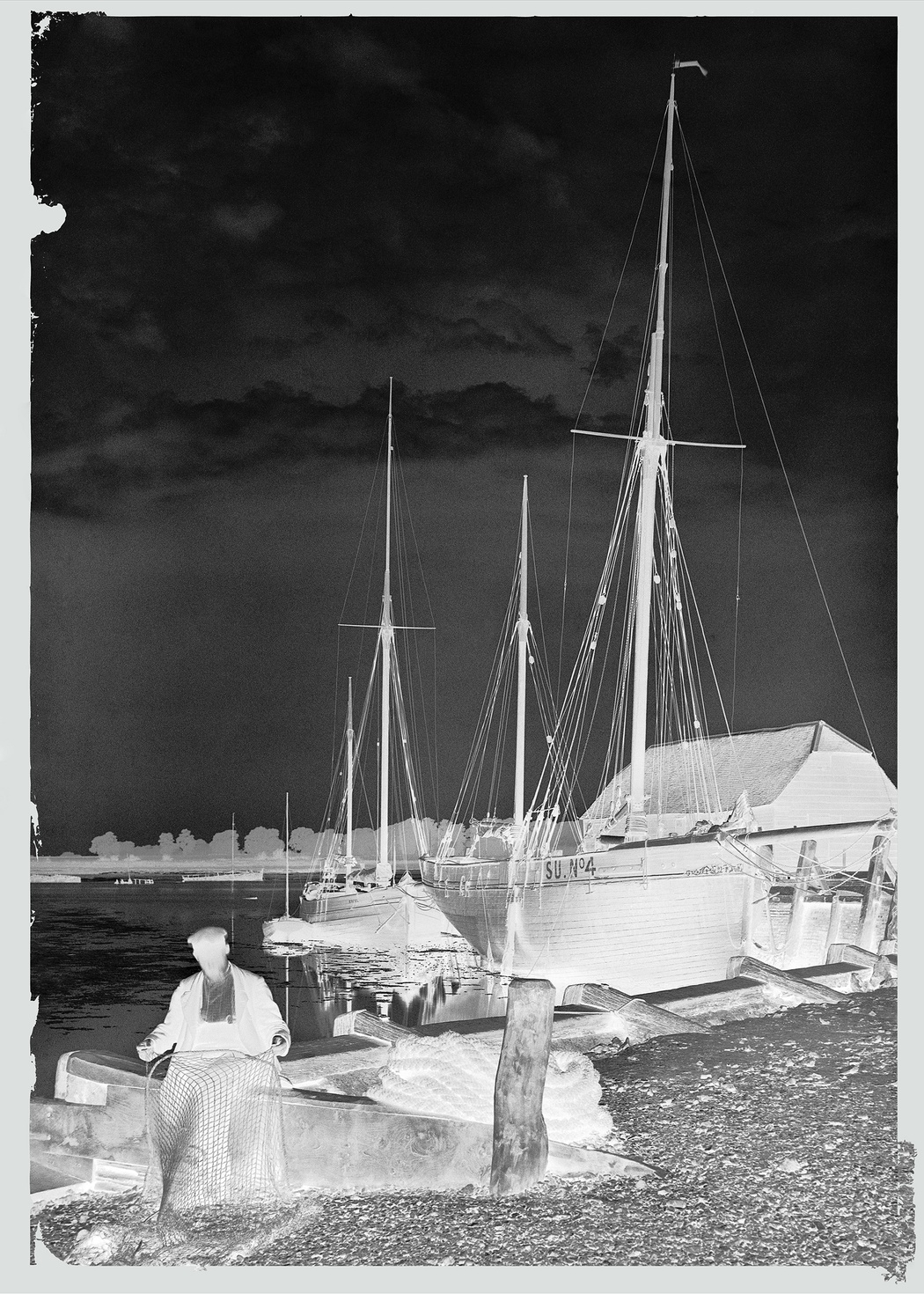 A glass plate negative of a photograph titled 'Fisherman Mending Nets, Bosham, Sussex, England 1890' followed by the inverted scan...
A glass plate negative of a photograph titled 'Fisherman Mending Nets, Bosham, Sussex, England 1890' followed by the inverted scan... -
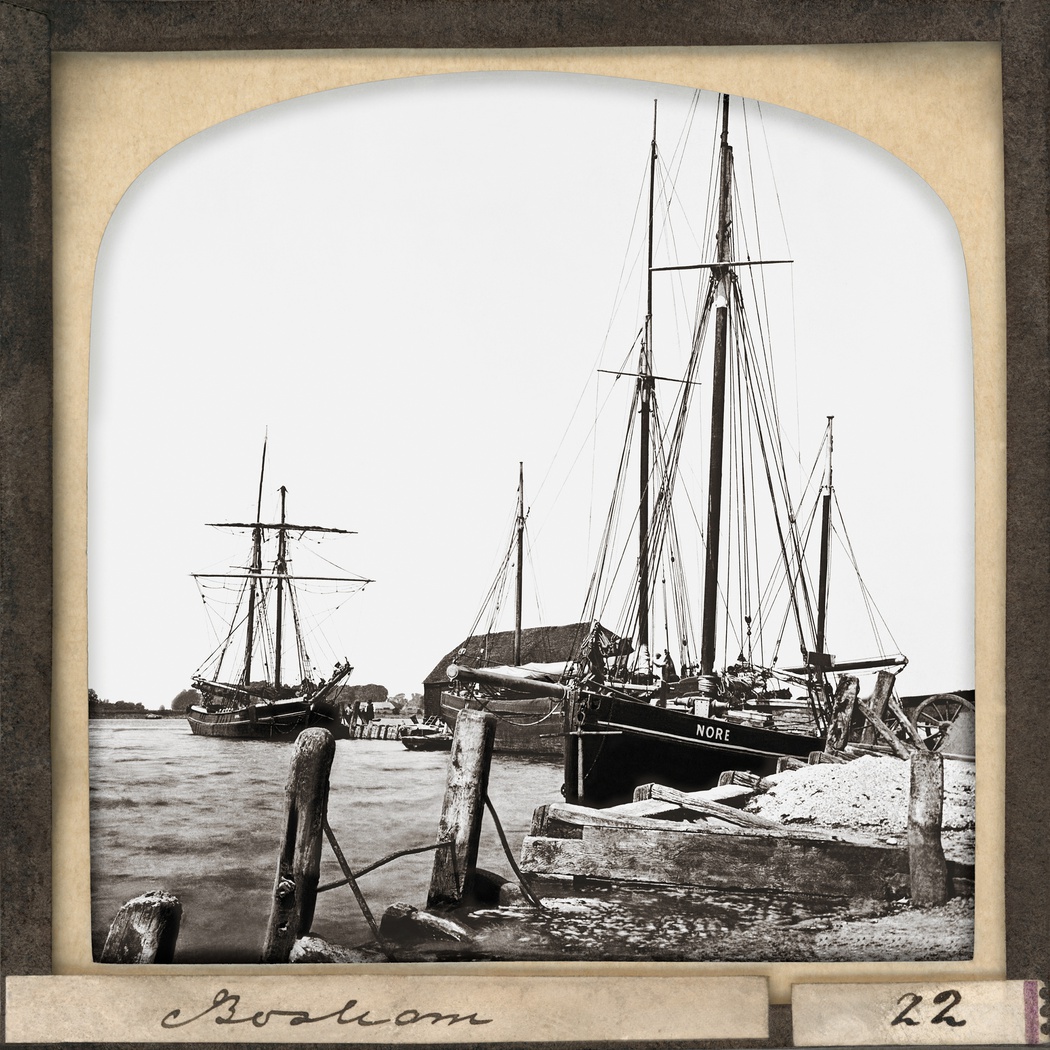 A 19th century magic lantern slide photograph of Bosham...
A 19th century magic lantern slide photograph of Bosham... -
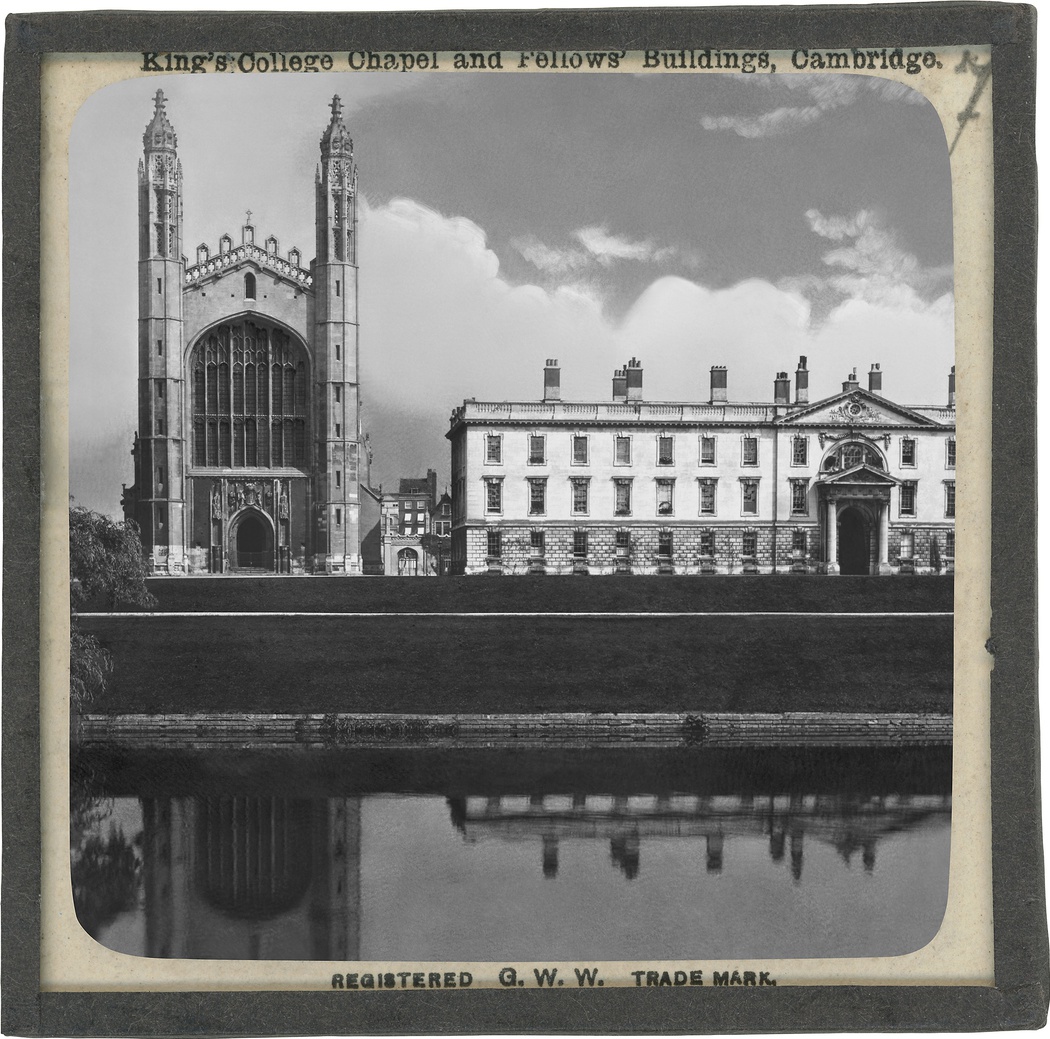 King's College Chapel & Fellows' Buildings, Cambridge by George Washington WilsonA photographic magic lantern slide is a positive photograph on glass, which has been copied from a glass plate negative, for the purpose of projecting it for display using a ‘magic lantern’, the predecessor of the slide projector. Images were projected using a candle flame, and later a gas lamp. They were common in the late 19th and first half of the 20th centuries.
King's College Chapel & Fellows' Buildings, Cambridge by George Washington WilsonA photographic magic lantern slide is a positive photograph on glass, which has been copied from a glass plate negative, for the purpose of projecting it for display using a ‘magic lantern’, the predecessor of the slide projector. Images were projected using a candle flame, and later a gas lamp. They were common in the late 19th and first half of the 20th centuries. -
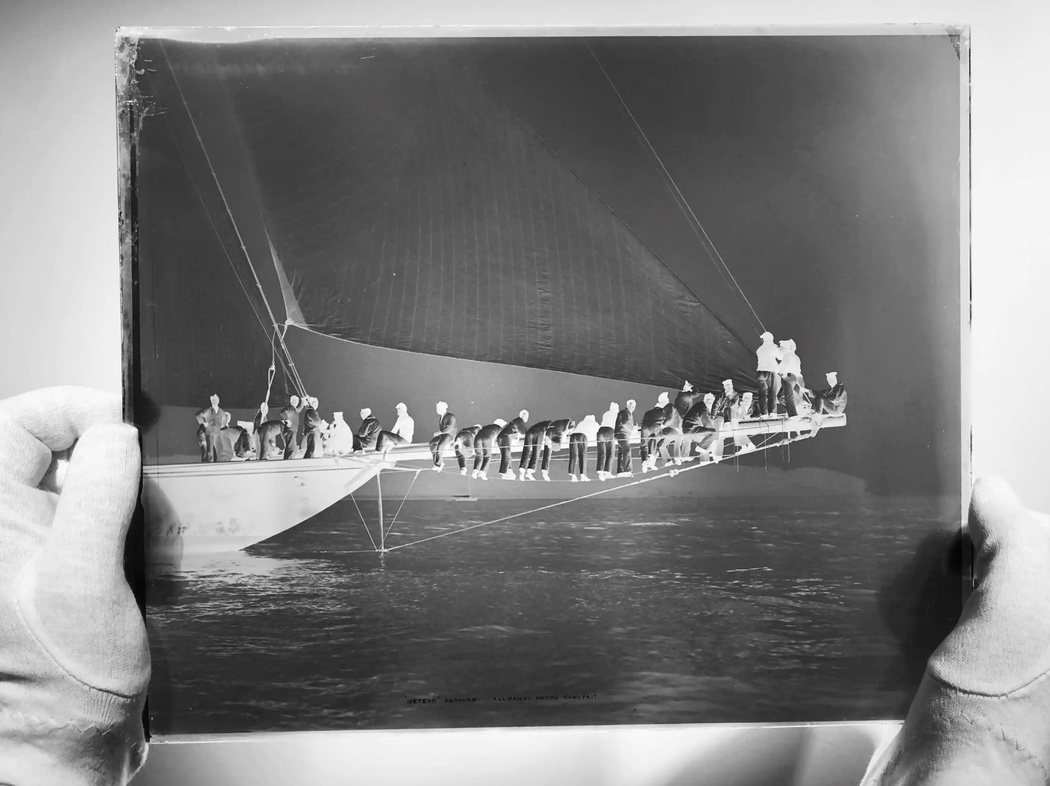
In order to make silver gelatin photographs today using the original glass plate negatives in the Beken of Cowes archive, which are over 130 years old, first the glass plate negatives needed to be cleaned and then scanned to produce a digital file. Here's how the arduous task of digitally restoring the Beken of Cowes photographs was completed by Paul Brett in 2015, by way of an example using Alfred John West's iconic photograph of Meteor II Aground in 1899.
-
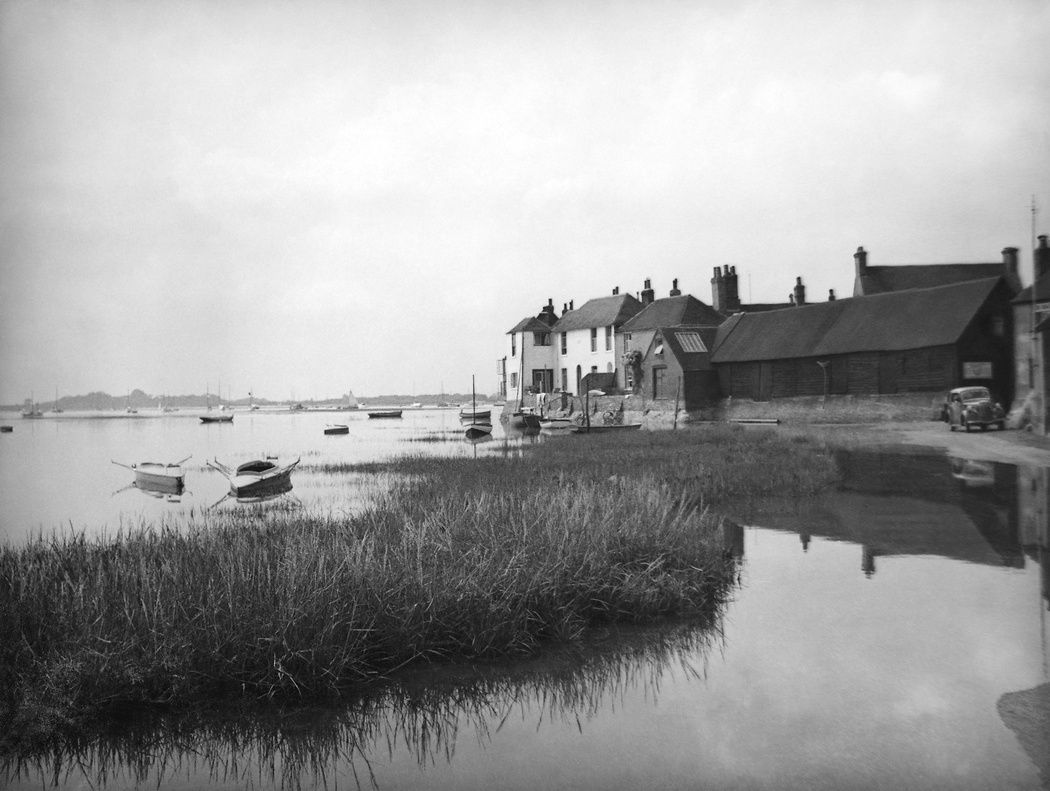 Bosham, 1938 by Sir Kenneth YoungerA fascinating and rare set of photographs of Bosham in 1938, by Sir Kenneth Younger. The newsstand outside the Post Office on the High Street reads 'Eden's Future', a young cricketer is captured rowing up to a car caught out by the high tide, and locals are seen sitting on the wall along the foreshore enjoying the August sunshine, almost exactly one year before the outbreak of World War II.
Bosham, 1938 by Sir Kenneth YoungerA fascinating and rare set of photographs of Bosham in 1938, by Sir Kenneth Younger. The newsstand outside the Post Office on the High Street reads 'Eden's Future', a young cricketer is captured rowing up to a car caught out by the high tide, and locals are seen sitting on the wall along the foreshore enjoying the August sunshine, almost exactly one year before the outbreak of World War II. -
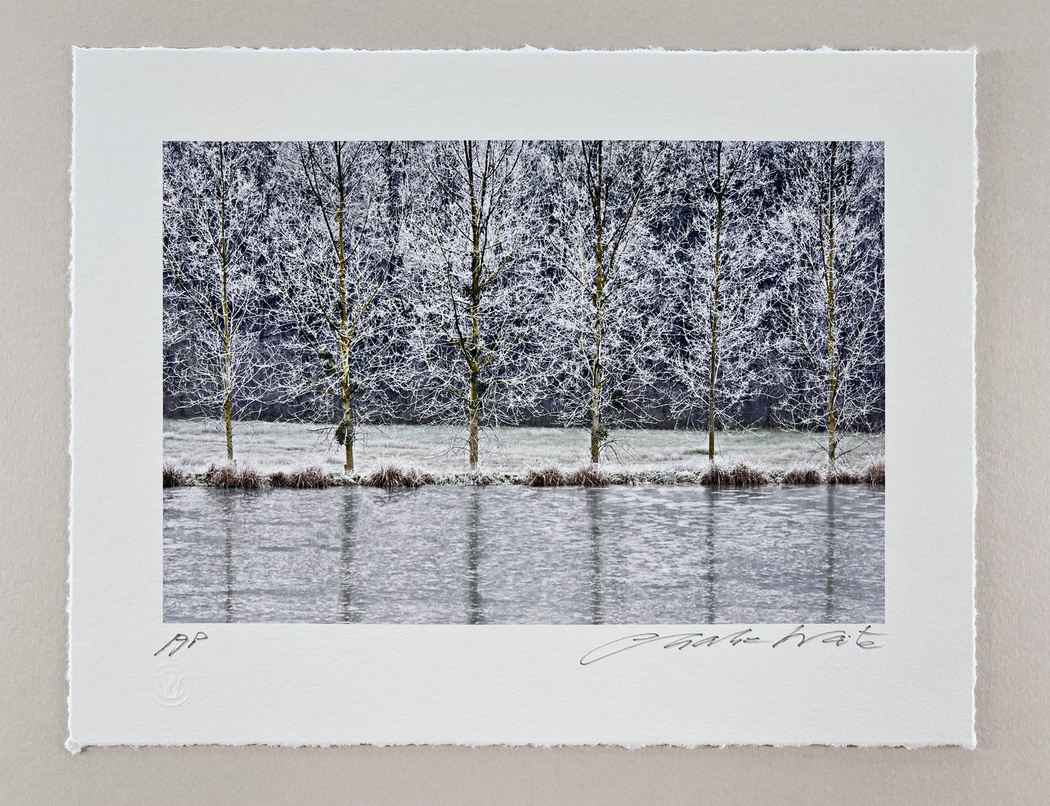
-
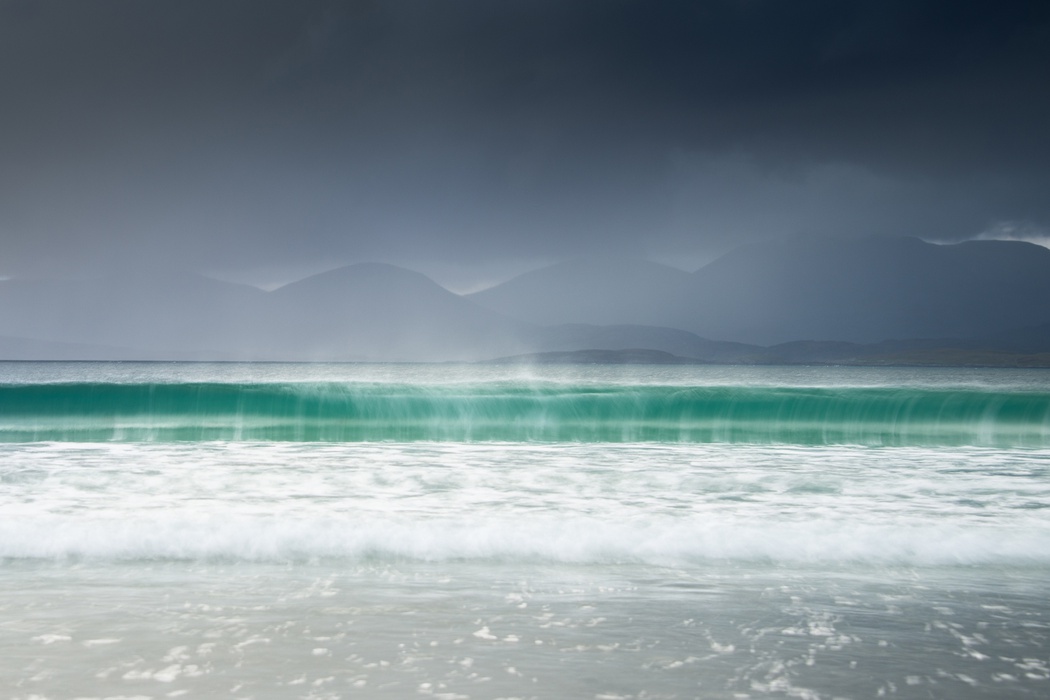 Isle of Harris, Study 3, Scotland 2017
Isle of Harris, Study 3, Scotland 2017 -
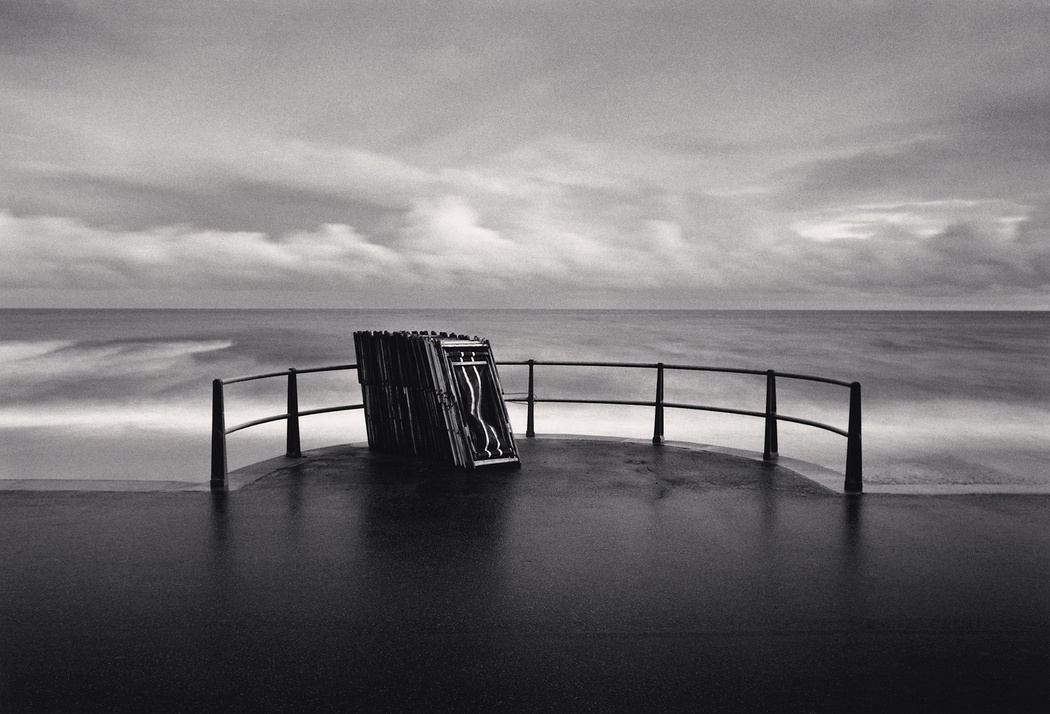 Deckchairs, Bournemouth, Dorset, England 1983 © Michael Kenna
Deckchairs, Bournemouth, Dorset, England 1983 © Michael KennaMichael Kenna | Deckchairs, Bournemouth, Dorset, England 1983
Picture/Story By Michael KennaProjects sometimes develop without prior research or specific intentions. Curiosity can lead to a keen interest, which may in turn transform into an avid infatuation. Such was the case with a series of photographs I made in England between 1983 and 1986, of which Deckchairs, Bournemouth, Dorset 1983 is included. -
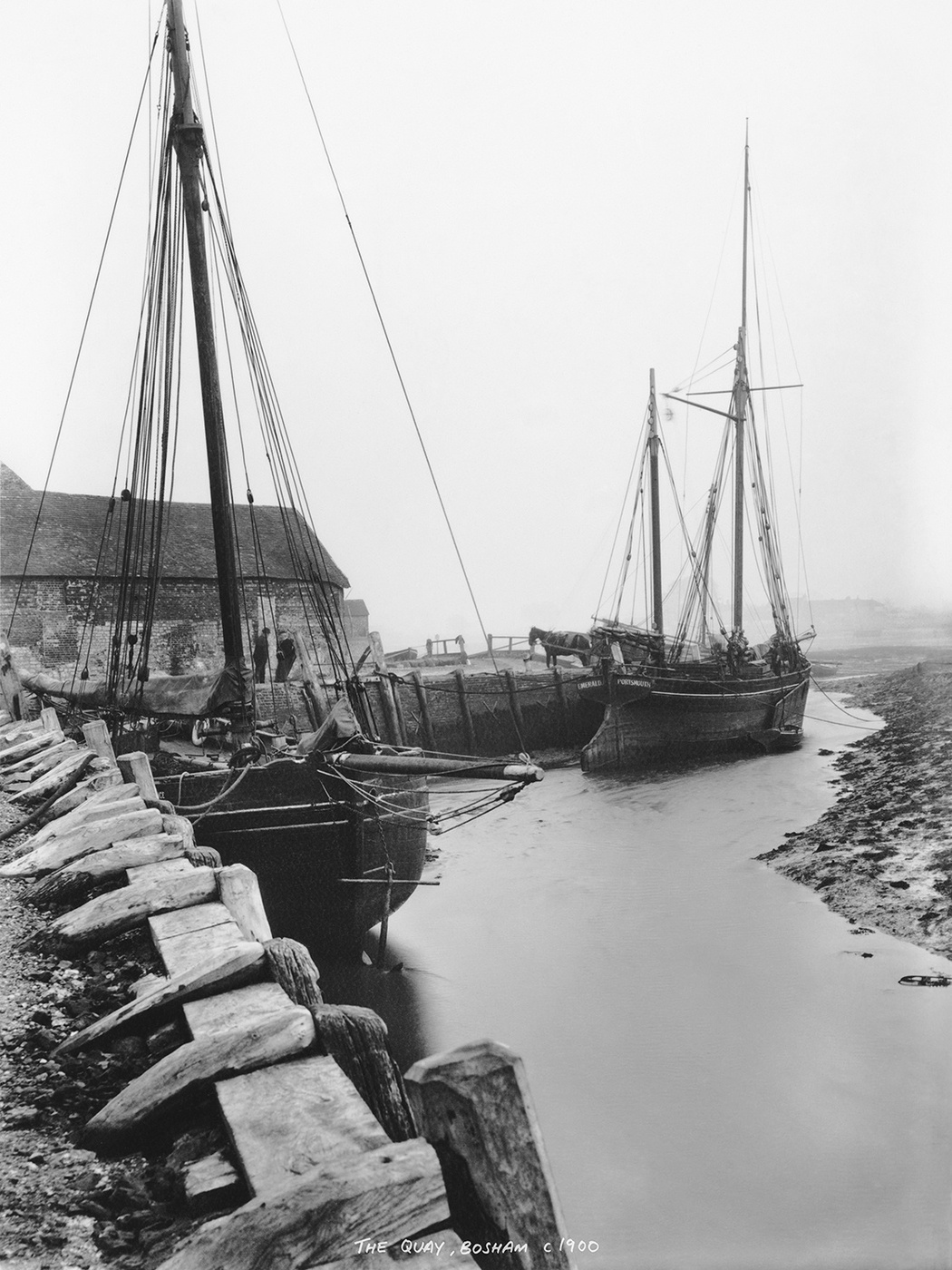 The Quay, Bosham, Sussex, England c1900
The Quay, Bosham, Sussex, England c1900Bosham's Sea Trade In The 19th Century
Archive Reference: BMA097Longer read...
Prior to 1900, Bosham had been a thriving commercial port for freight transport along Britain's coastline for over 300 years. This photograph captures two trading ketches tied to Bosham Quay being unloaded by horse and cart at low tide. On the left, two mariners can be seen leaning against the oak piles of the Quay, chatting.
-
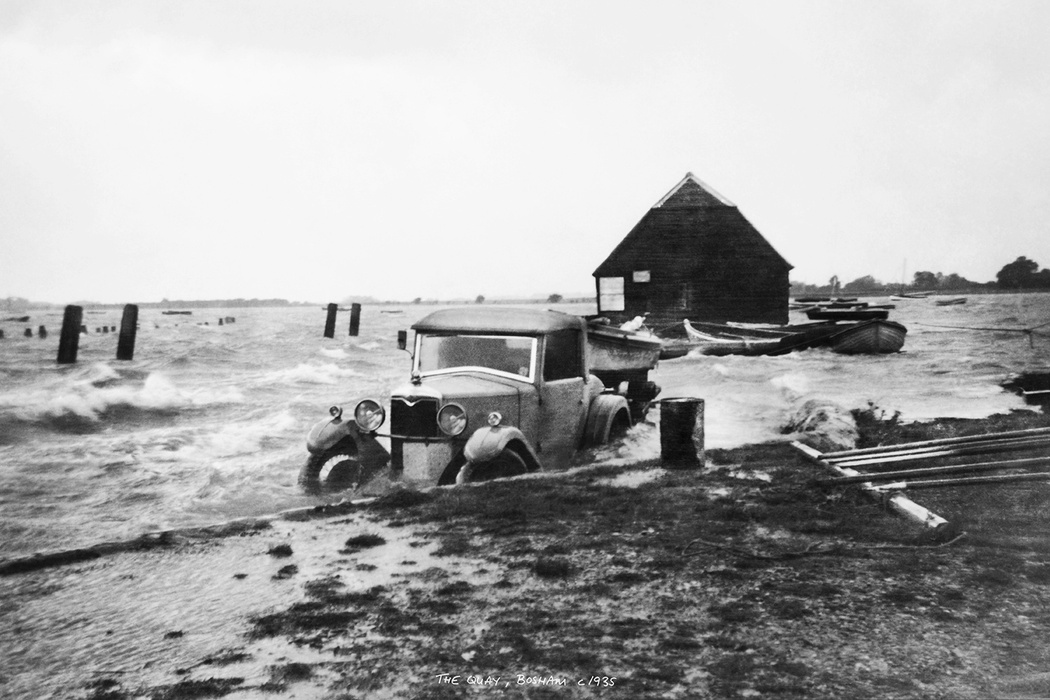 The Quay, Bosham, Sussex 1935
The Quay, Bosham, Sussex 1935Caught By The Tide, Bosham, Sussex, England 1935
Archive Reference: BGA1817Bosham Sailing Club is the oldest sailing club in Chichester Harbour and was formed in 1907. It wasn’t until after World War I that other clubs were established within the harbour and since then, the harbour has mainly been used for recreational and competitive sailing. What was once a busy, working Quay for Bosham’s fishermen and mariners, with customs tolls payable to the Lord of The Manor of Bosham, has since been used to launch and keep sailing boats that are raced in the harbour, or tenders that are used to row out to the deep-sea moorings.
-
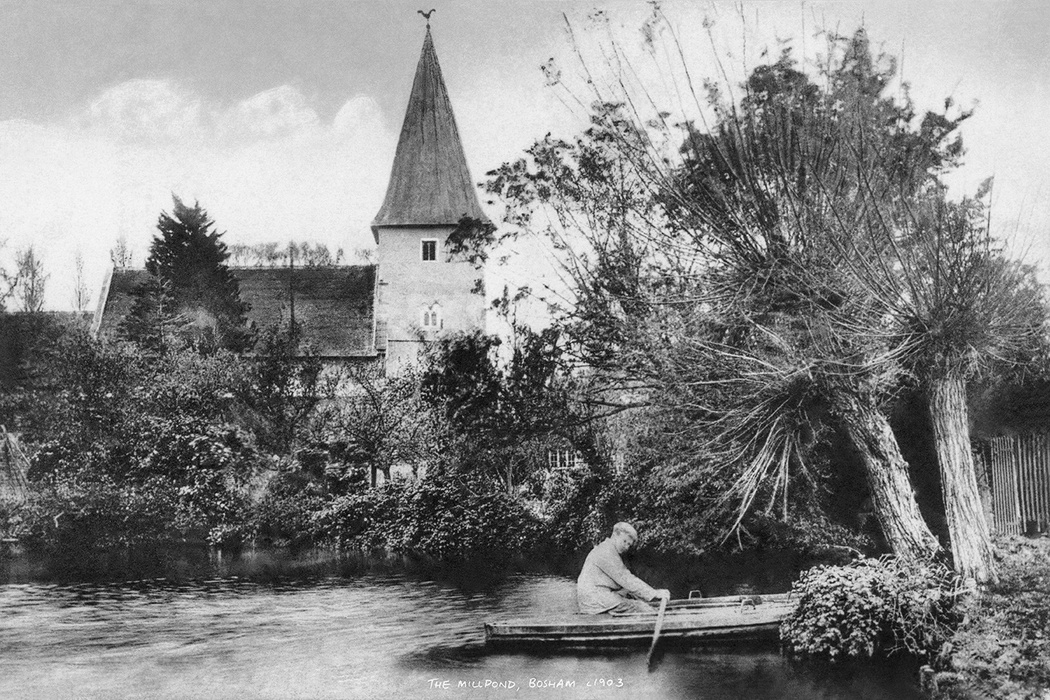 The Millpond, Bosham, Sussex, England c1903
The Millpond, Bosham, Sussex, England c1903The History Of The Old Watermill On Bosham Quay
Archive Reference: BGA840Longer read...
Bosham used to have a millpond to even out the seasonal variations in the water level of the man-made Bosham stream, which fed the watermill on Bosham Quay until it closed in 1936. It was the oldest watermill in the area and had been in operation since at least the eleventh century, as it is mentioned in the Domesday Survey in 1080 as one of eight mills in the area. It was a very large millpond, with sluice gates to control the flow, and over the centuries it was stocked with fish and eel, which were regularly trapped for food.
-
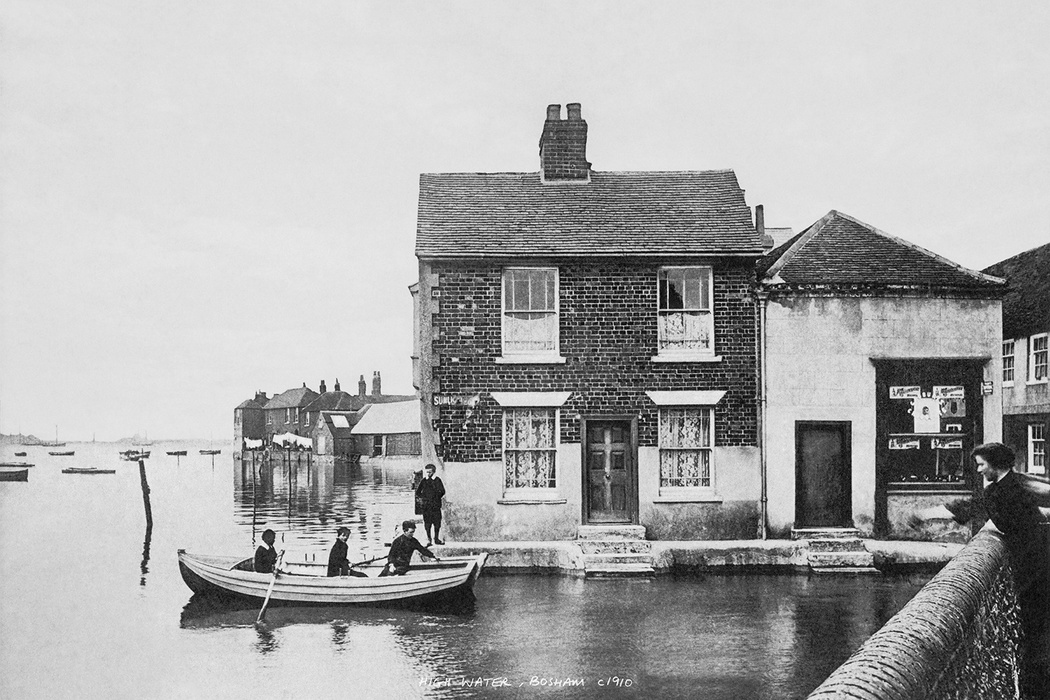 High Water, Bosham, Sussex, England c1910
High Water, Bosham, Sussex, England c1910High Water, Bosham, Sussex, England c1910
Archive Reference: BGA1902The tide comes right into the village at Bosham. During a high spring tide, the sea covers the road at Street End, and rises up Bosham Lane and into the High Street. At the peak of the incoming tide, the village is entirely transformed as it looks as though Bosham stands on the borders of some great lake, with the old cottages along the High Street appearing to float on the water. The tide rises right up their front walls, shimmering and reflecting in the sea with countless subtle patterns and colours, and waves lapping under their windows. -
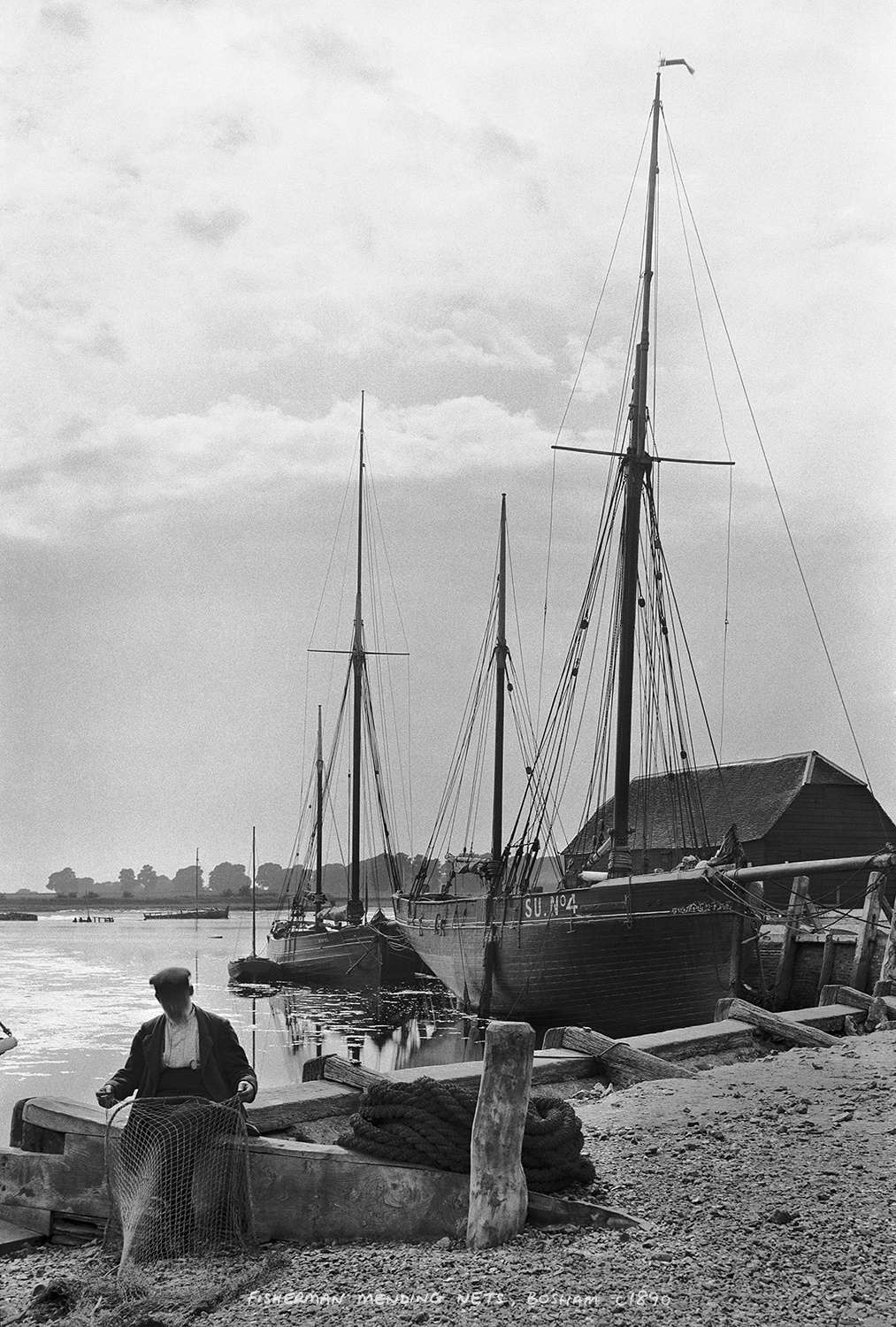 Fisherman Mending Nets, Bosham, Sussex c1890
Fisherman Mending Nets, Bosham, Sussex c1890Bosham's Fishing Fleet In The 19th Century
Archive Reference: BGA3321Longer read...
Bosham’s fishing industry enjoyed a boom in the second half of the nineteenth century. The arrival of the railways in 1846 allowed the fishermen to expand their markets, and Bosham’s boatbuilders began to build larger fishing boats that could stay at sea longer, and hold larger cargoes of fish. Young oysters were dredged up in the shallow waters of the English Channel and off the French coast, and left to mature in nursery beds within Chichester Harbour. Scallops were dredged up in deeper waters (below 25 feet) of the English Channel, where herring, mullet, crab and bass could also be fished with ease. Mackerel, shrimp, and cockles were in plentiful supply in Chichester Harbour, and Bosham’s fishing fleet sailed to Shoreham to fish for mussels, and to the North Sea for cod.
-
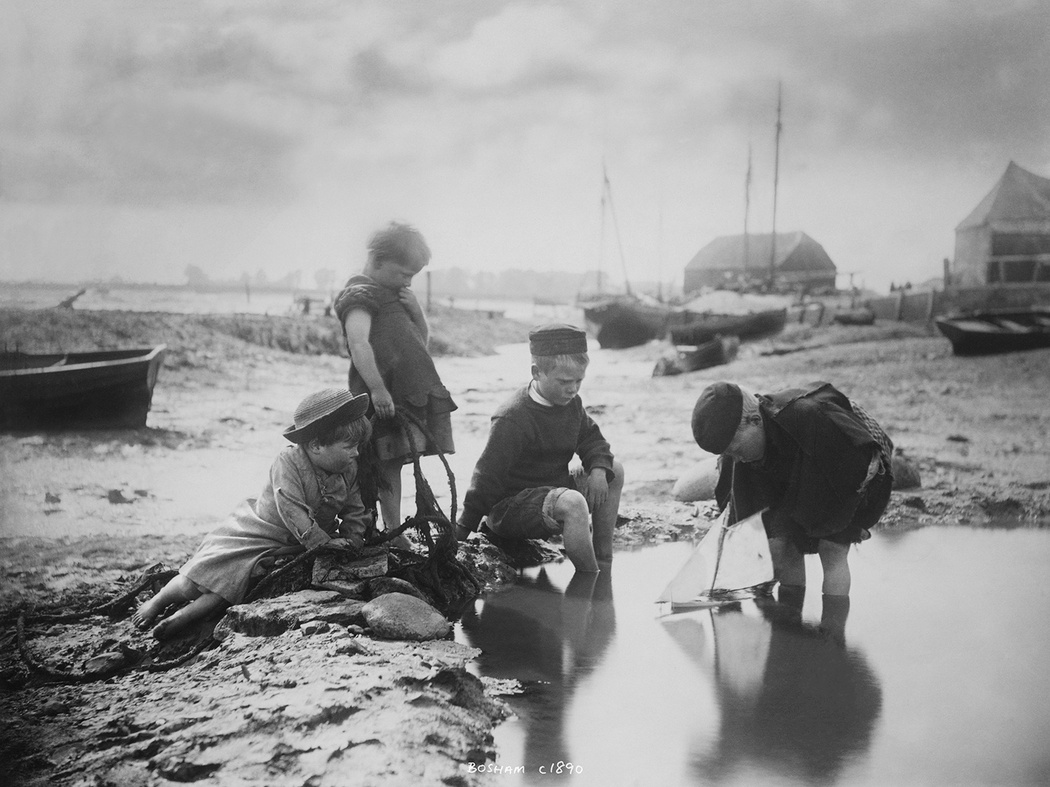 Bosham c1890
Bosham c1890 -
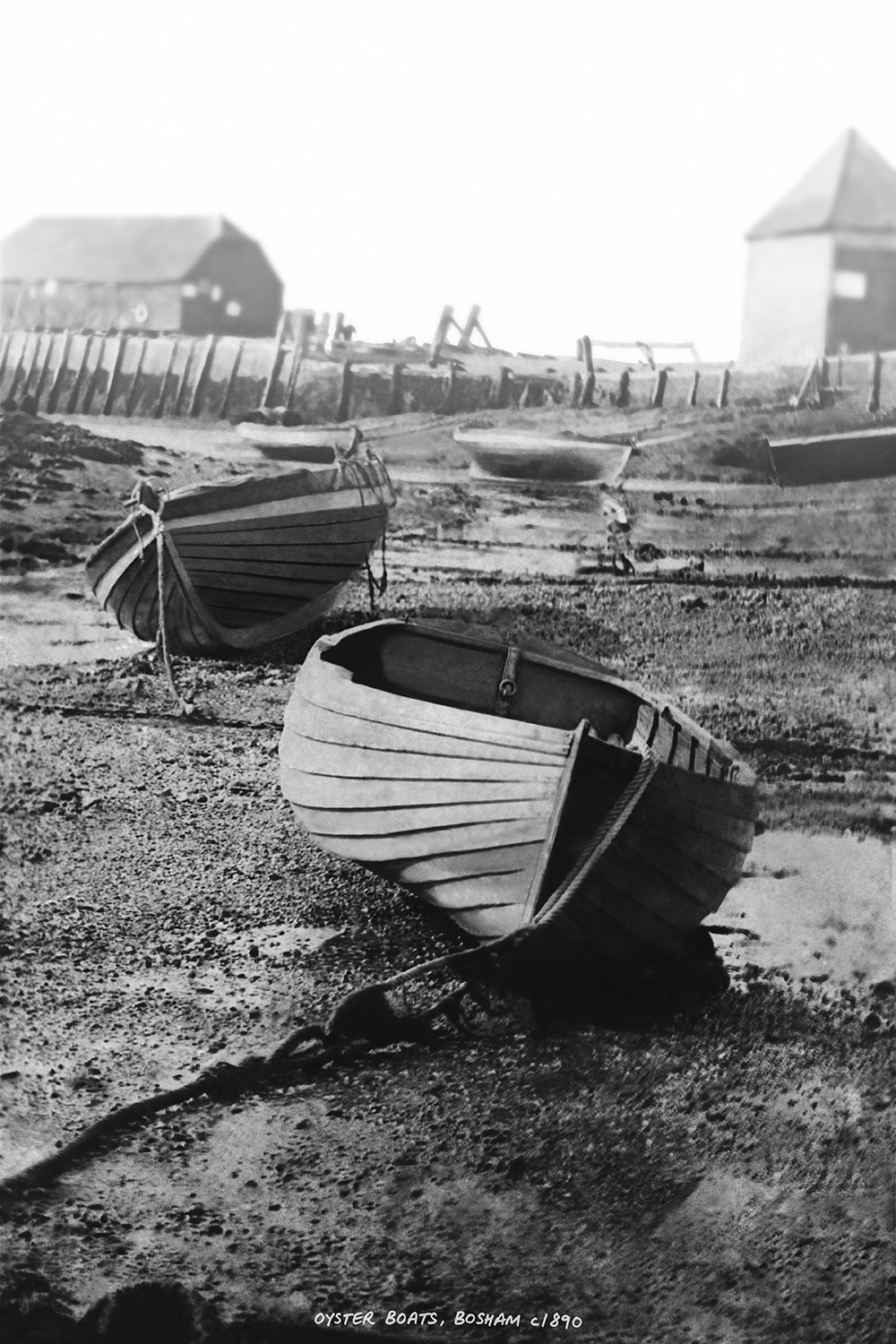 Oyster Boats, Bosham, Sussex, England c1890
Oyster Boats, Bosham, Sussex, England c1890Emsworth & Bosham's Oyster Ponds In The 19th Century
Archive Reference: BGA1652Longer read...
At the end of the nineteenth century, Bosham's oyster fishery was booming, and there was a huge demand for oysters in London, where it is estimated that a staggering 144 million were sold each year. The oyster ponds were located along the foreshore of Bosham's two creeks, either side of the Quay. The oysters needed a great deal of care to protect them from growing over each other, and smothering the smaller ones, which caused suffocation, and the fishermen would continually walk or row out to the ponds to monitor their growth. They were constantly sorting and grading them, and removing mud and seaweed from the ponds, which could also suffocate them.
Bosham's oyster boats, pictured here, were built in the village. They were wide rowing boats with low sides to allow the fishermen to easily dredge and use a net. A cross between a fork and a rake was used to scoop the oysters out of the ponds, into buckets or bags. They were brought ashore and packed into baskets and taken by horse and cart to the railway station, one mile to the north. The majority of Bosham's oysters were sold in fish markets in Portsmouth, Southampton, Brighton, Winchester, Hove, Guildford and various boroughs of London.
As well as using these rowing boats to manage the oyster ponds, fishermen would have used them to fish for shrimp in shallow waters within Bosham's creeks.
-
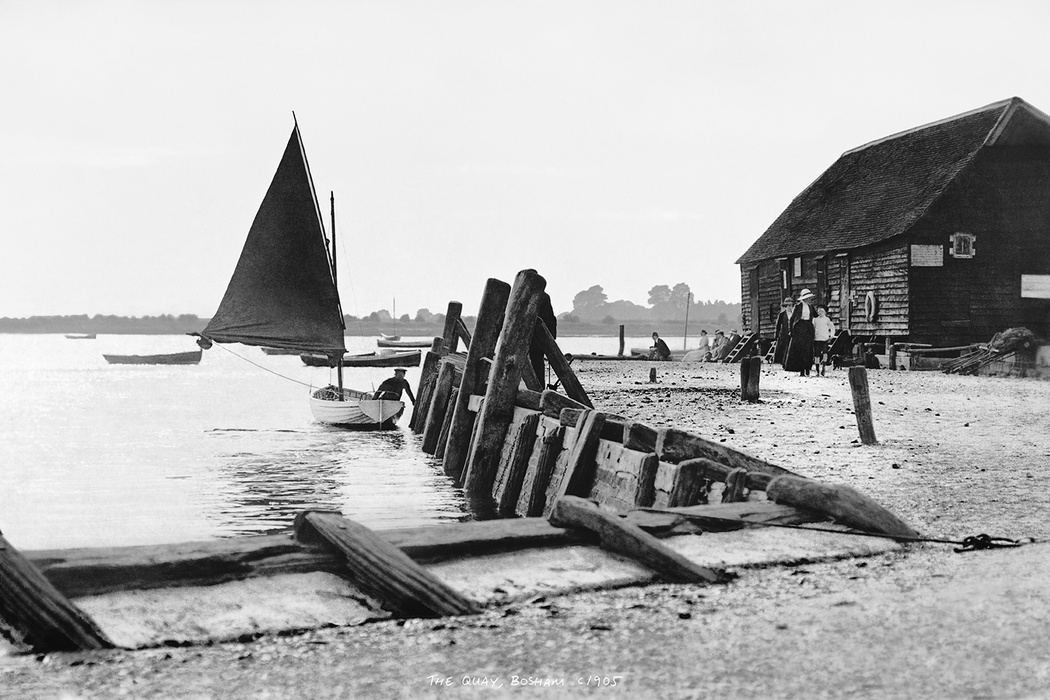 The Quay, Bosham, Sussex, England c1905
The Quay, Bosham, Sussex, England c1905Chichester Harbour's Booming Oyster Industry In The 19th Century
Archive Reference: BGA820Longer read...
Perhaps the most interesting passage of Chichester Harbour's oyster history is the story of the fishery during the nineteenth century when we saw the emergence of oyster merchants such as James Duncan Foster in Emsworth and William Yetman in Bosham, who established an early form of factory farm fishing to take advantage of the arrival of the railways in 1846, which significantly expanded markets for local fishermen, and shortened delivery times dramatically. Their fishing fleets built much larger oyster boats that could stay at sea longer and carry larger cargoes of fish, and produced better quality oysters by using oyster ponds to manage their growth and allow the oysters to cleanse before they were sent to market. By the end of the nineteenth century, oysters had been elevated from a subsistence food for the lower classes to a prized delicacy of the upper classes. The story of Chichester Harbour's oysters through the centuries is fascinating...
-
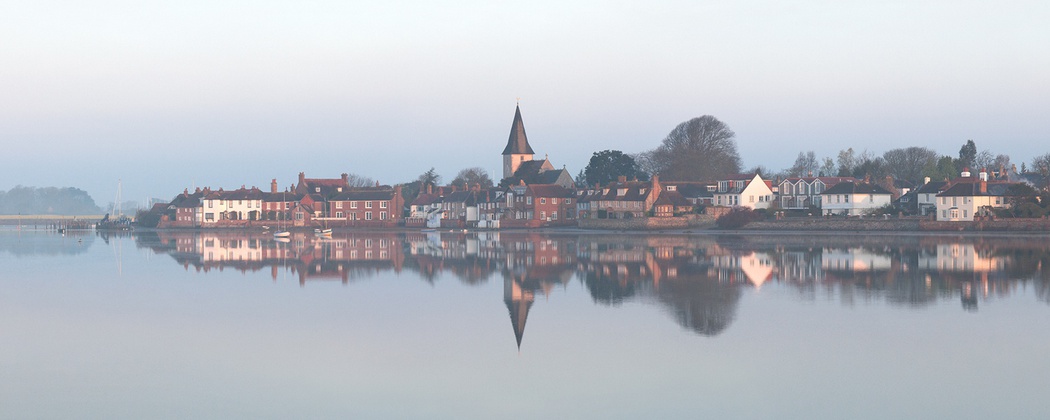 First Light, Bosham, Sussex, England 2012
First Light, Bosham, Sussex, England 2012First Light, Bosham, Sussex, England 2012
Luke Whitaker: Picture/StoryUp at 5am on a still April morning to capture this moment of peace and tranquility in the Bosham Creek. I walked along Shore Road and sat on an old wooden jetty for an hour waiting for the light to strengthen. Bosham can feel a very spiritual place at first light, and a calmness came over me that I have never experienced before.
-
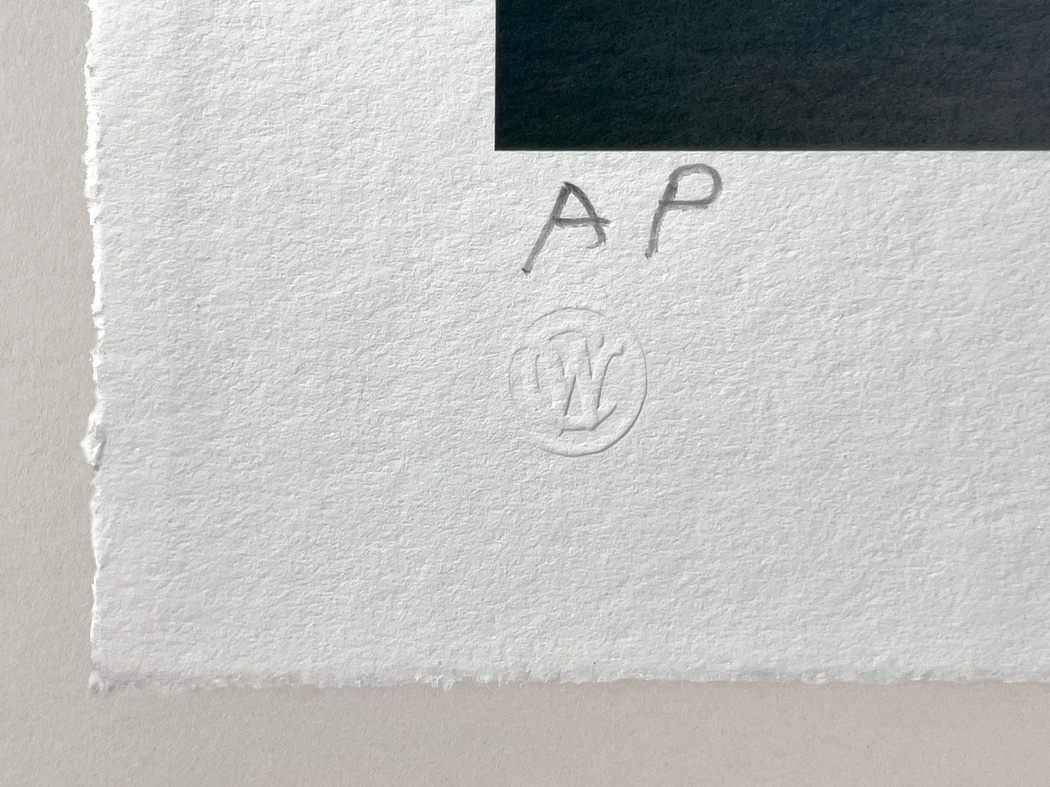
Artists use their signature and blind stamp to signify completion of the printing process and to show a mark of provenance, which allows collectors to trace the work back to the artist's studio. A blind stamp ('blind' meaning uncoloured) is often unobtrusive and you might have to inspect a print carefully to establish its presence.
-
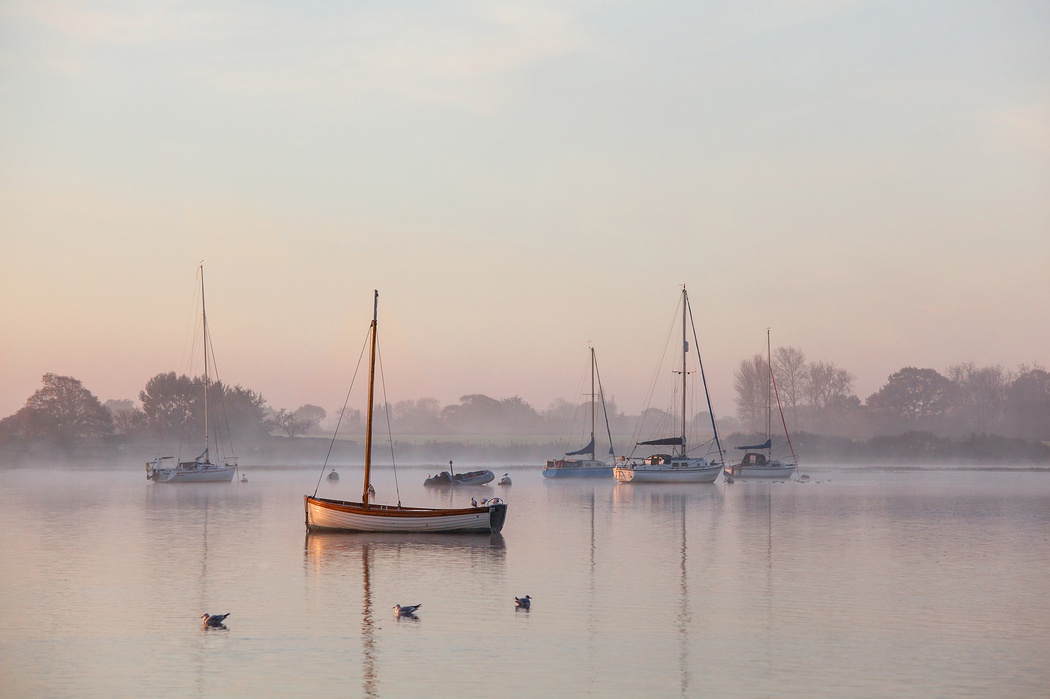 Misty Morning, Bosham, Sussex, England 2012
Misty Morning, Bosham, Sussex, England 2012Misty Morning, Bosham, Sussex, England 2012
Luke Whitaker: Picture/StoryWhat does it feel like to walk around Chichester Harbour on a freezing cold winter's morning? Despite the cold and damp, I find those still mornings are some of the best of the year. Every now and again the sun might break through the clouds for a fleeting moment or two, and the whole channel can look quite enchanting.
-
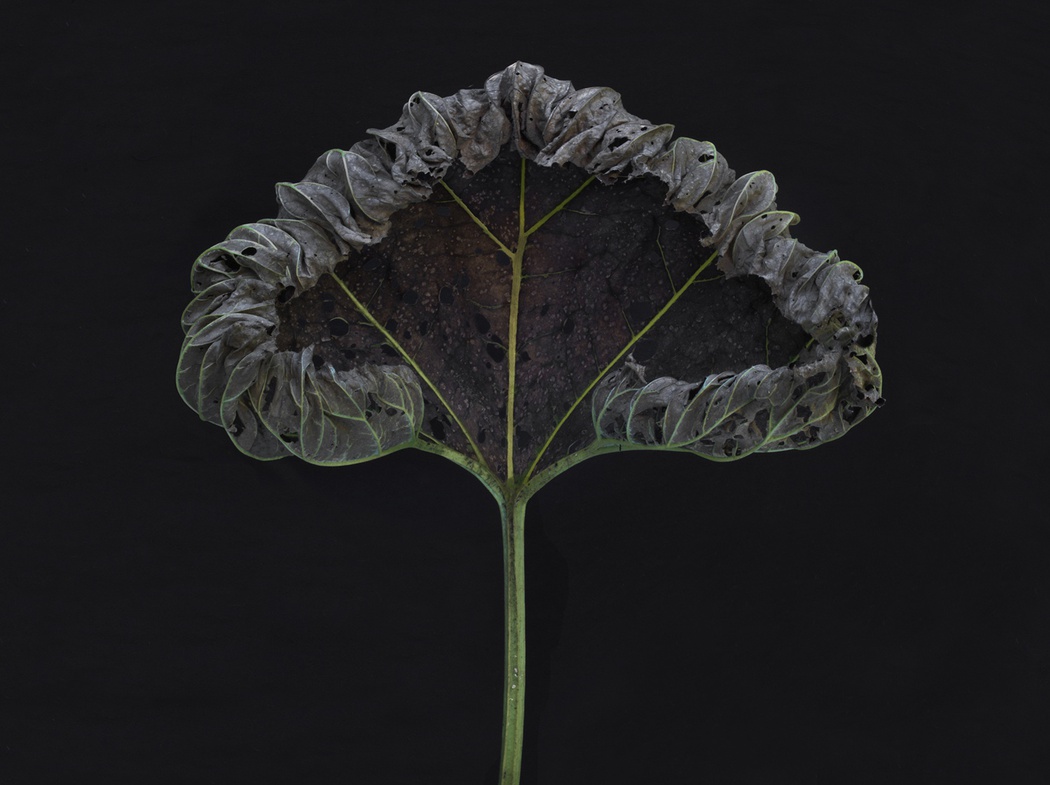 The Leaf, England, 2015 | Edition of 50 | £1400 exc. VAT
The Leaf, England, 2015 | Edition of 50 | £1400 exc. VAT -
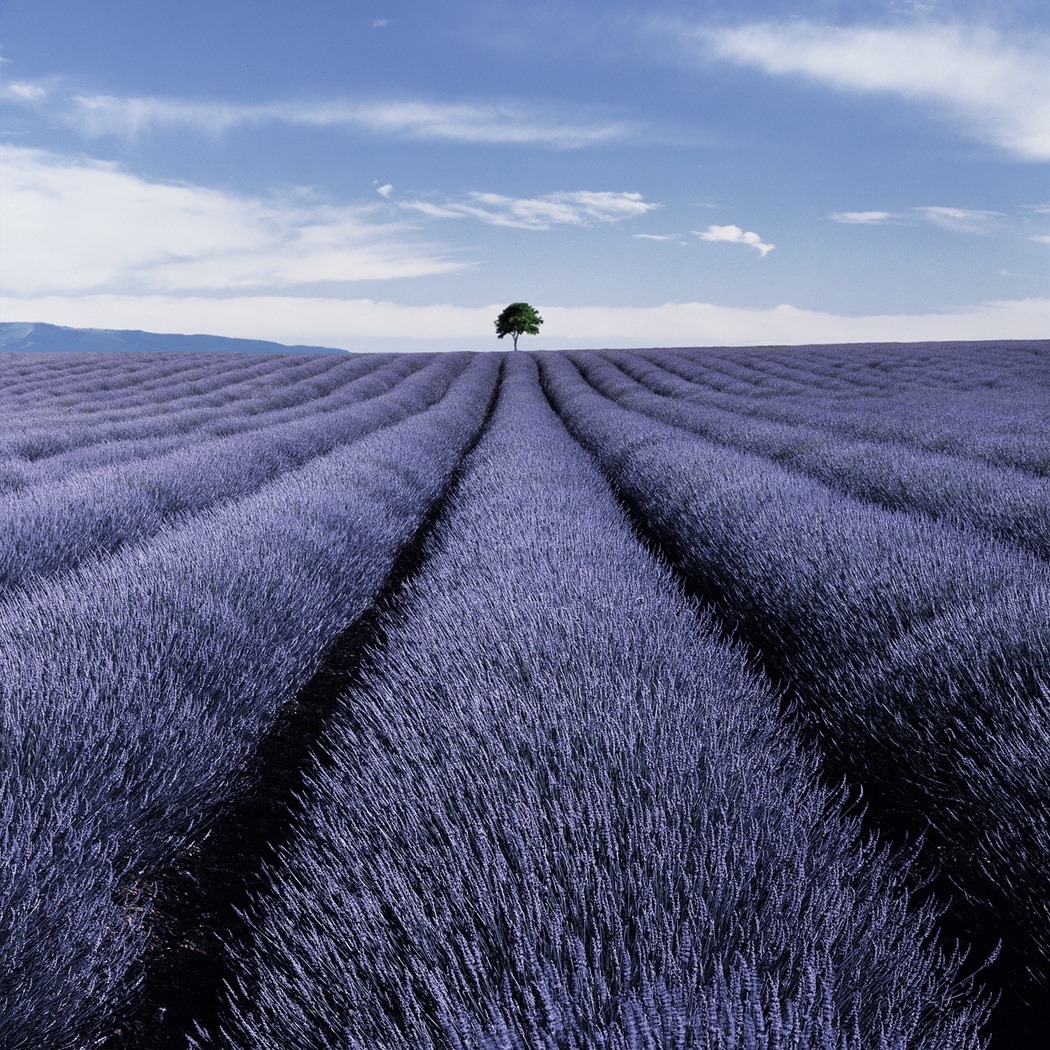 Valensole Study 2, France, 2004 | Open Edition | £1100 exc. VAT
Valensole Study 2, France, 2004 | Open Edition | £1100 exc. VAT -
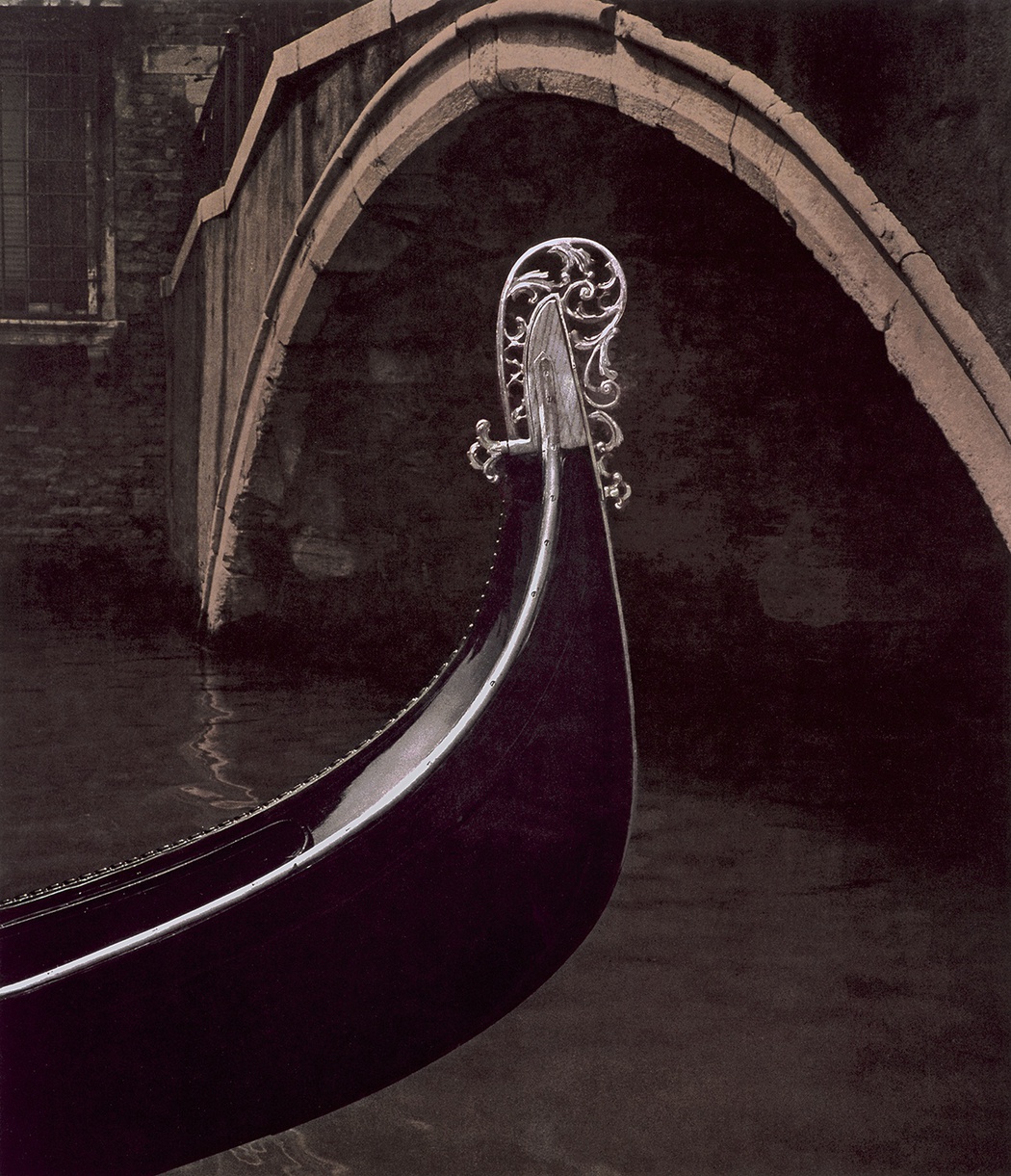 Gondola, Venice, Italy 1996 | Edition of 50 | £1600 exc. VAT
Gondola, Venice, Italy 1996 | Edition of 50 | £1600 exc. VAT -
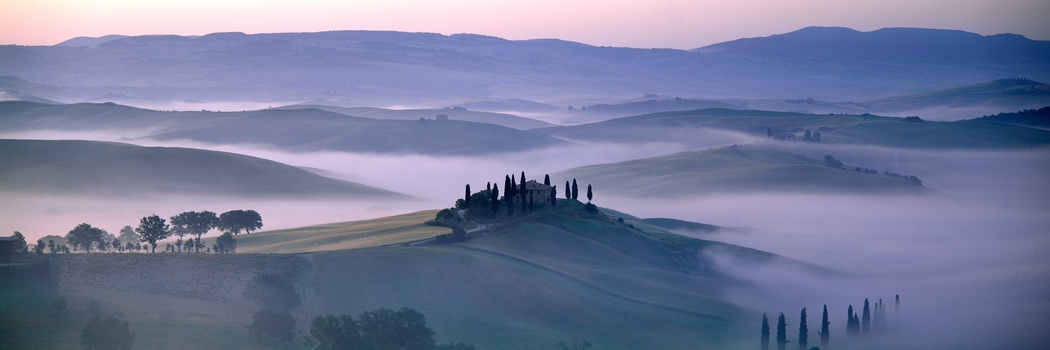 Val D'Orcia Study 1, Tuscany, Italy 1999 | Artist Proof | £2385 exc. VAT
Val D'Orcia Study 1, Tuscany, Italy 1999 | Artist Proof | £2385 exc. VAT -
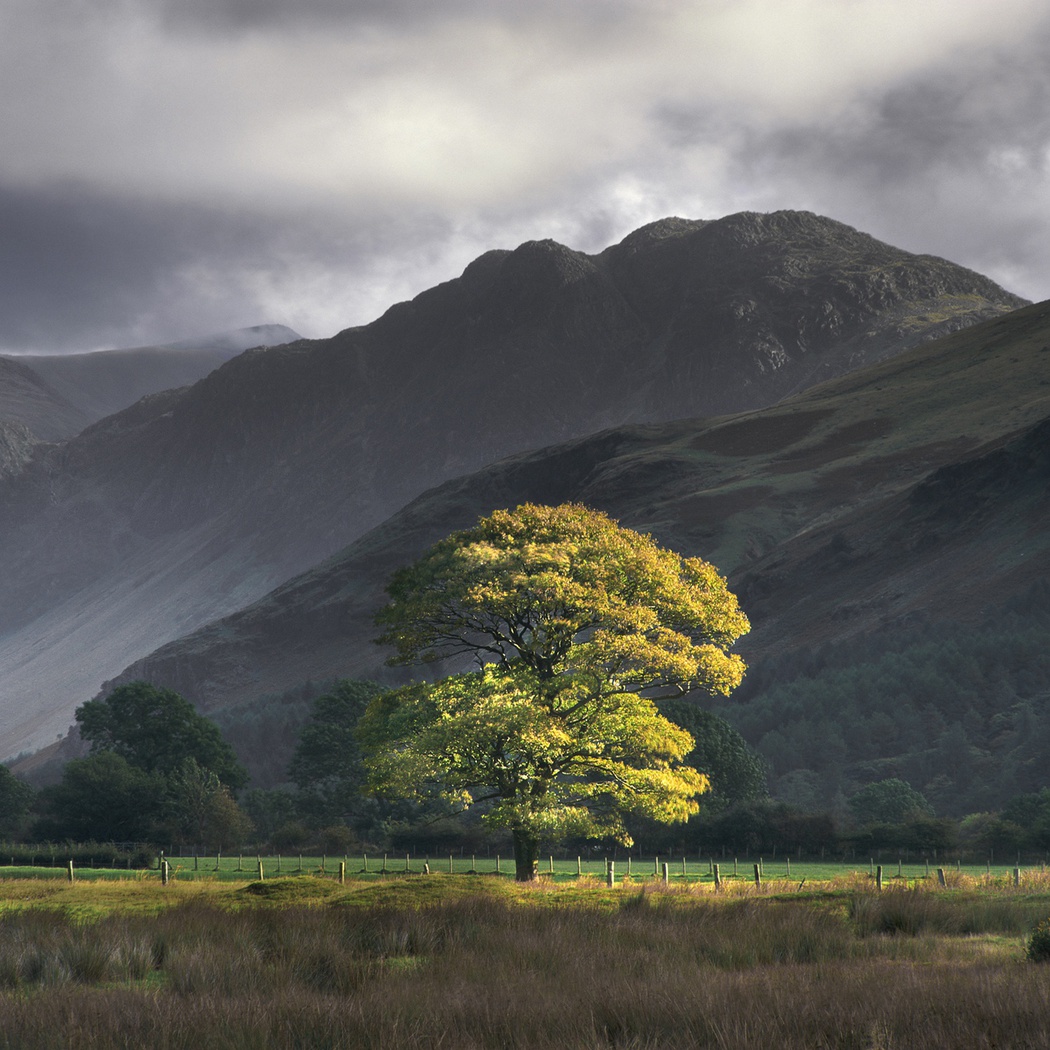 Buttermere Study 2, Cumbria, England, 2012 | Edition of 50 | £1550 exc. VAT
Buttermere Study 2, Cumbria, England, 2012 | Edition of 50 | £1550 exc. VAT -
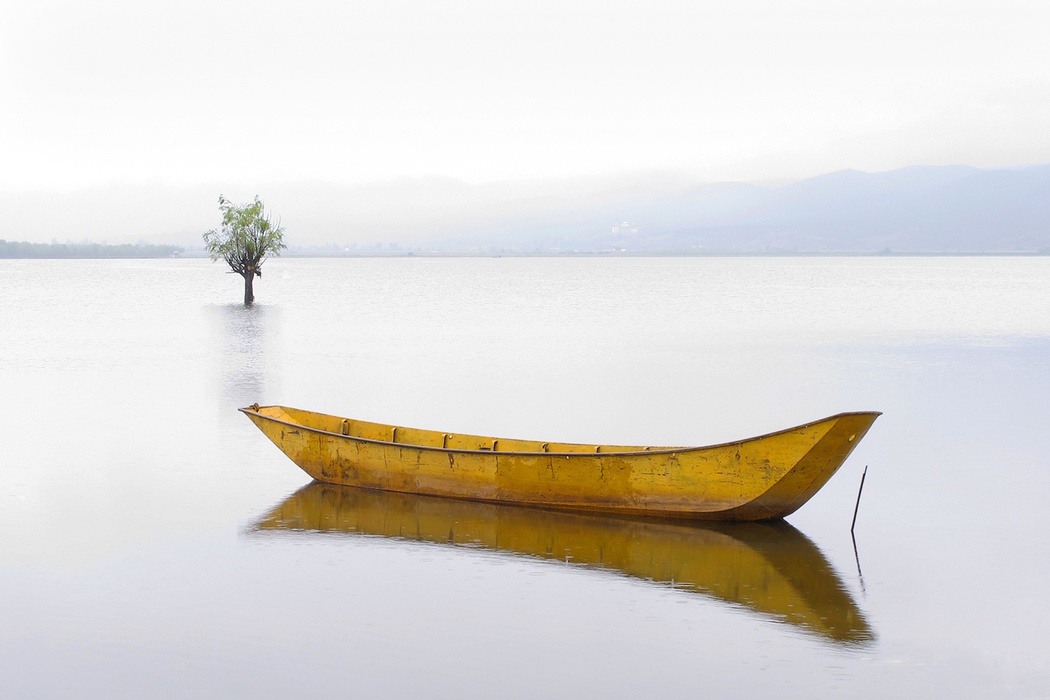 Shangri-La, Yunnan, China 2007 | Edition of 50 | £1950 exc. VAT
Shangri-La, Yunnan, China 2007 | Edition of 50 | £1950 exc. VAT -
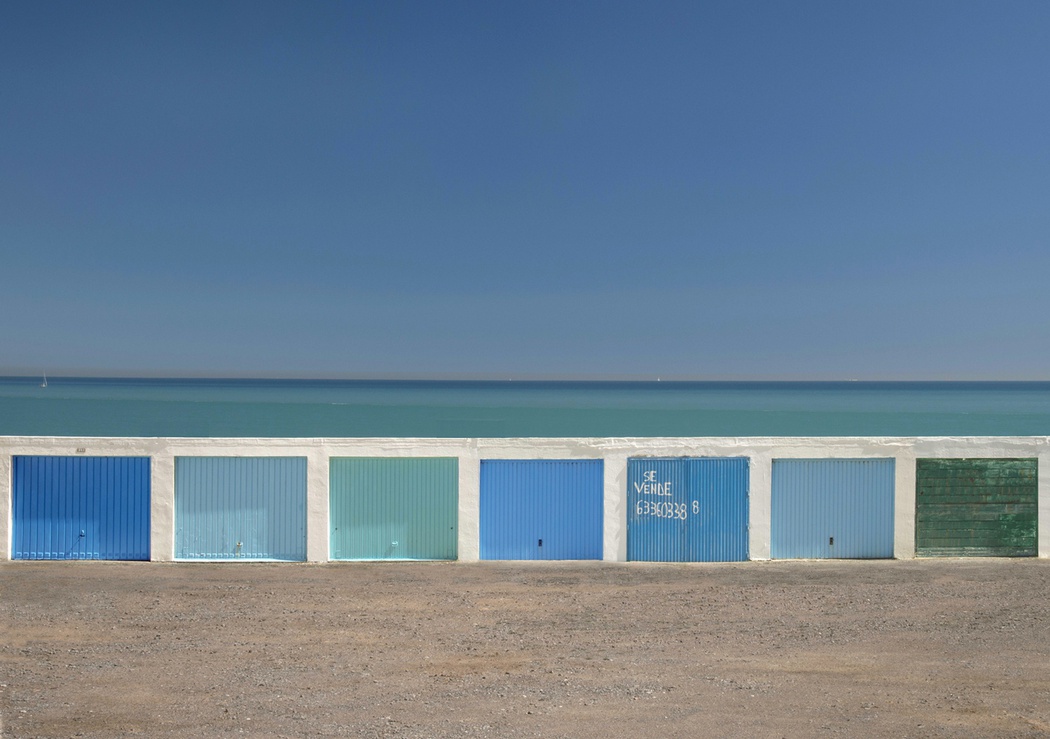 West of San Diego, Spain 2017 | Edition of 50 | £1500 exc. VAT
West of San Diego, Spain 2017 | Edition of 50 | £1500 exc. VAT -
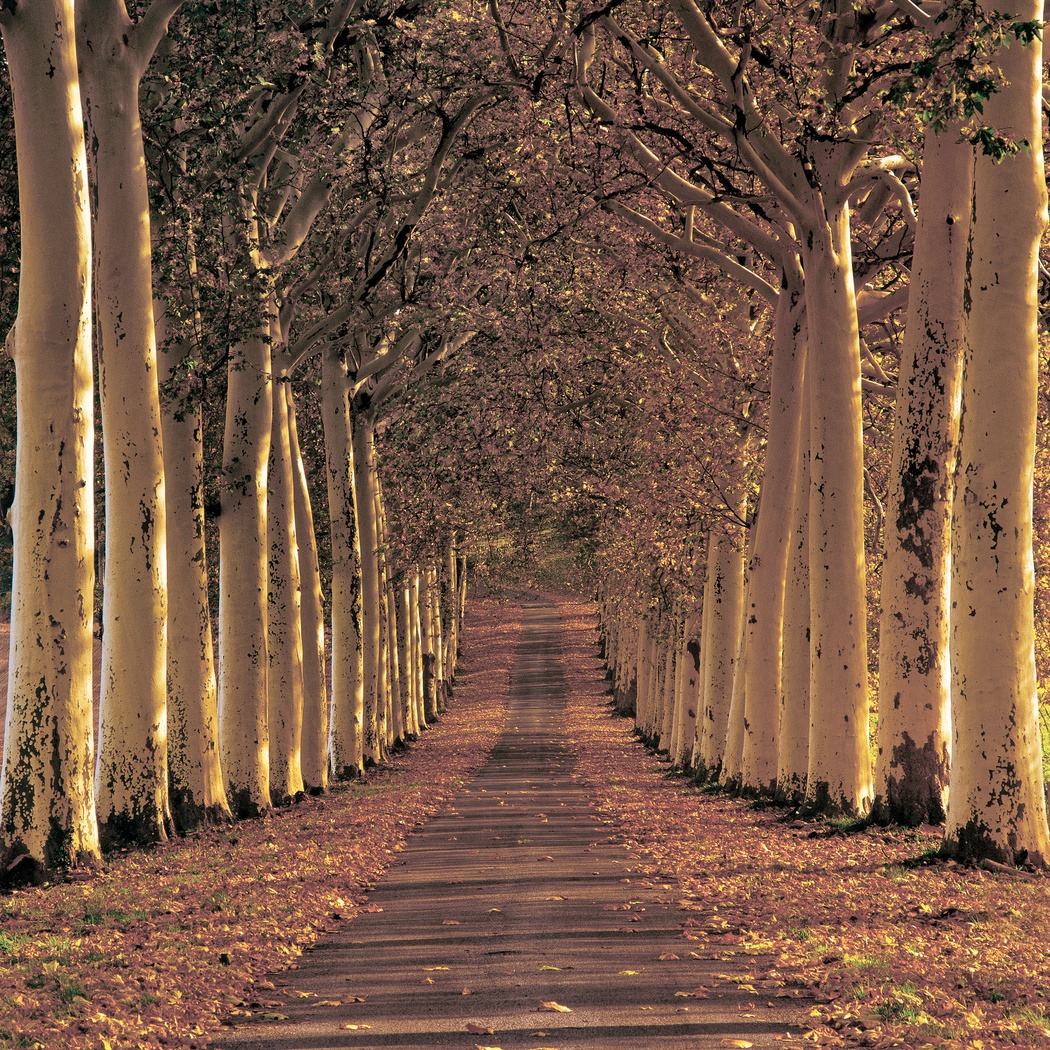
-
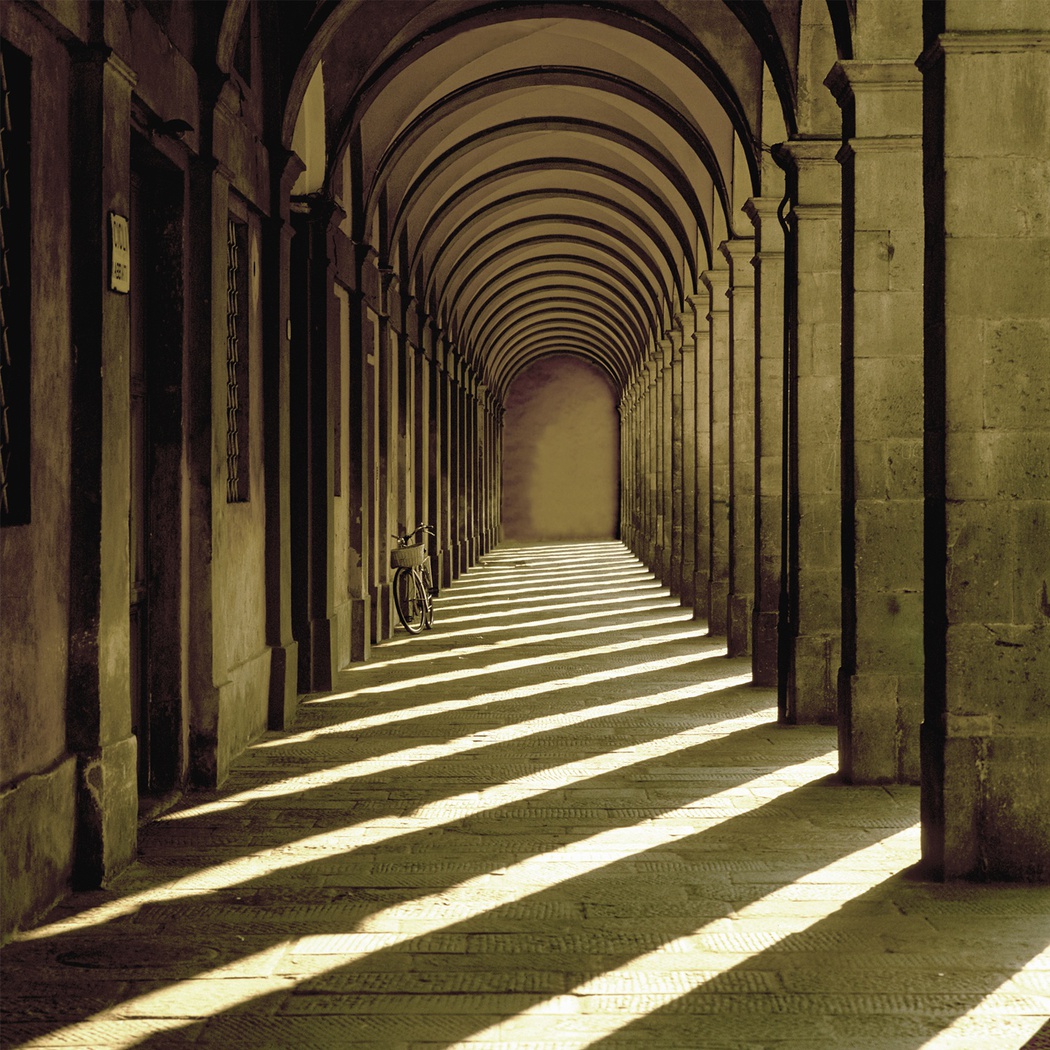 Lucca, Tuscany, Italy, 1990 | Edition of 50 | £1300 exc. VAT
Lucca, Tuscany, Italy, 1990 | Edition of 50 | £1300 exc. VATLucca, Tuscany, Italy, 1990
Charlie Waite: Picture/StoryOver the years Charlie Waite has become famous for his iconic studies of avenues of trees, which satisfies his deep sense of order, and provides pleasure in repetition and the aesthetics of arcs and diagonals. In this article we read the story behind Lucca, Tuscany, Italy 1990 and hear how he finds the opportunity to photograph a corridor or cloister just as irresistable as an avenue of trees.
-
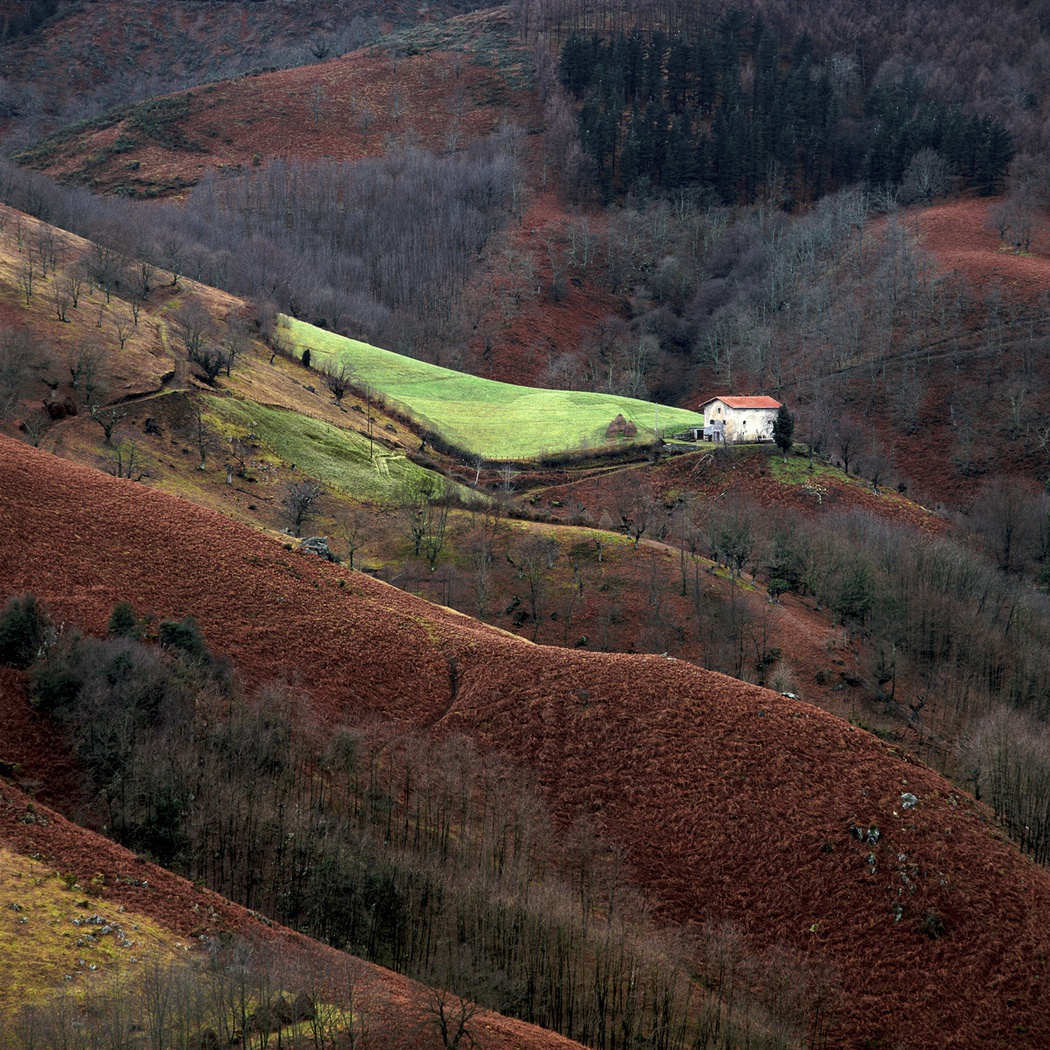 Cantabria, Spain, 1990 by Charlie Waite | Archival Pigment Print | Limited Edition of 50
Cantabria, Spain, 1990 by Charlie Waite | Archival Pigment Print | Limited Edition of 50Cantabria, Spain, 1990
Charlie Waite: Picture/StoryCharlie Waite tells the story behind one of his popular works from Cantabria, made during a book project on Spain in 1990, and shares the despair of waiting patiently through prolonged periods of rain, and the photographic ecstasy of capturing this very special image in a brief moment of flat lighting with no direct sunlight at all.
-
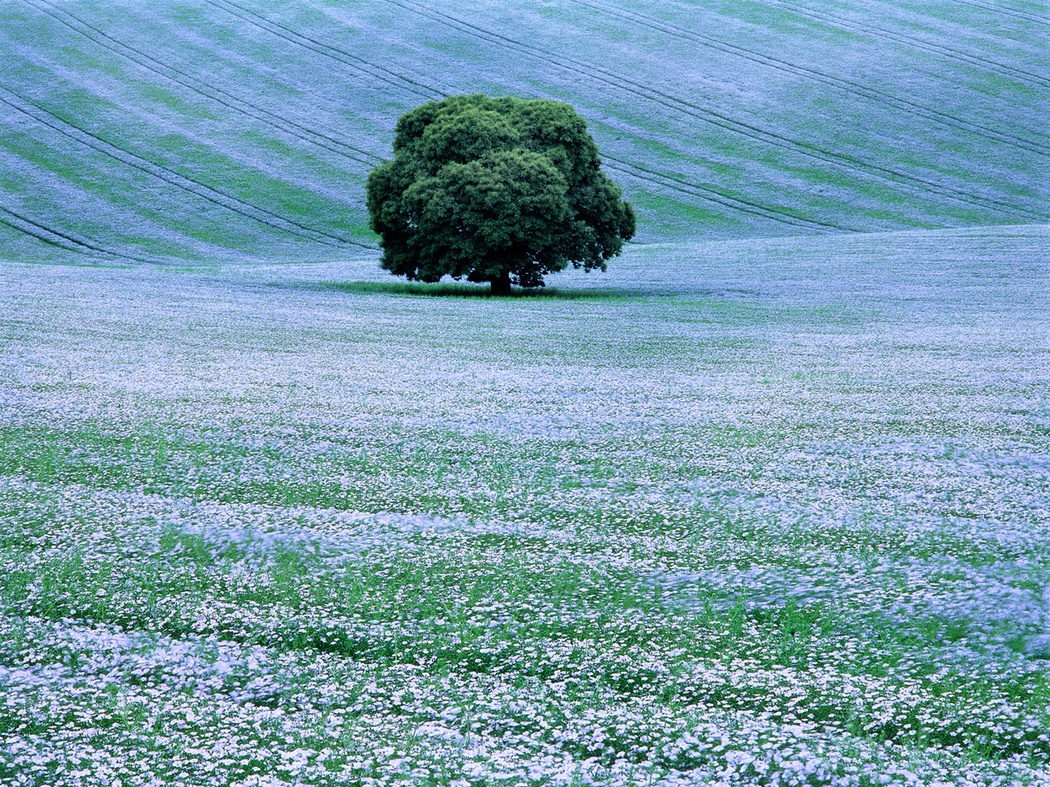
Willoughby Hedge, Wiltshire, England, 2000
Charlie Waite: Picture/StoryCharlie Waite's love affair with trees dates back 40 years and in this piece we hear from the artist about his relationship with a dear tree in the West Country that he has photographed for more than 25 years, and remains very close to his heart.
-
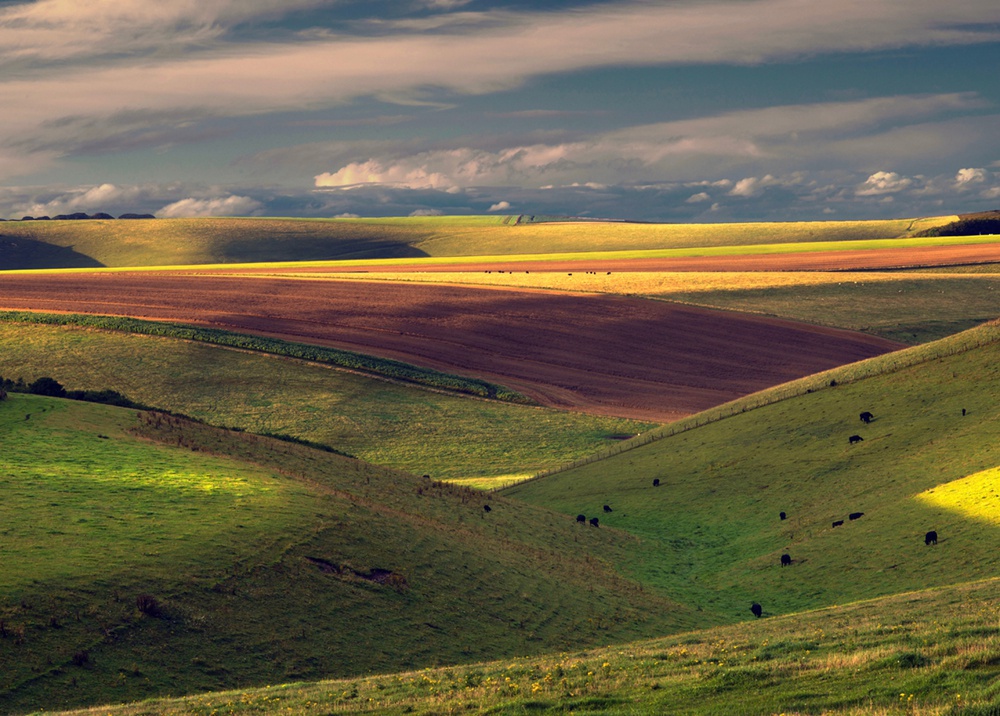 Mere Study 4, Wiltshire, England 2021
Mere Study 4, Wiltshire, England 2021Mere Study 4, Wiltshire, England 2021
New Work | Charlie WaiteWe are delighted to introduce a stunning new photograph by Charlie Waite titled Mere Study 4, Wiltshire, England 2021 which will feature in a forthcoming documentary 'My Greatest Shot', filmed by Sky Arts and expected to be published this autumn or early 2022.
-
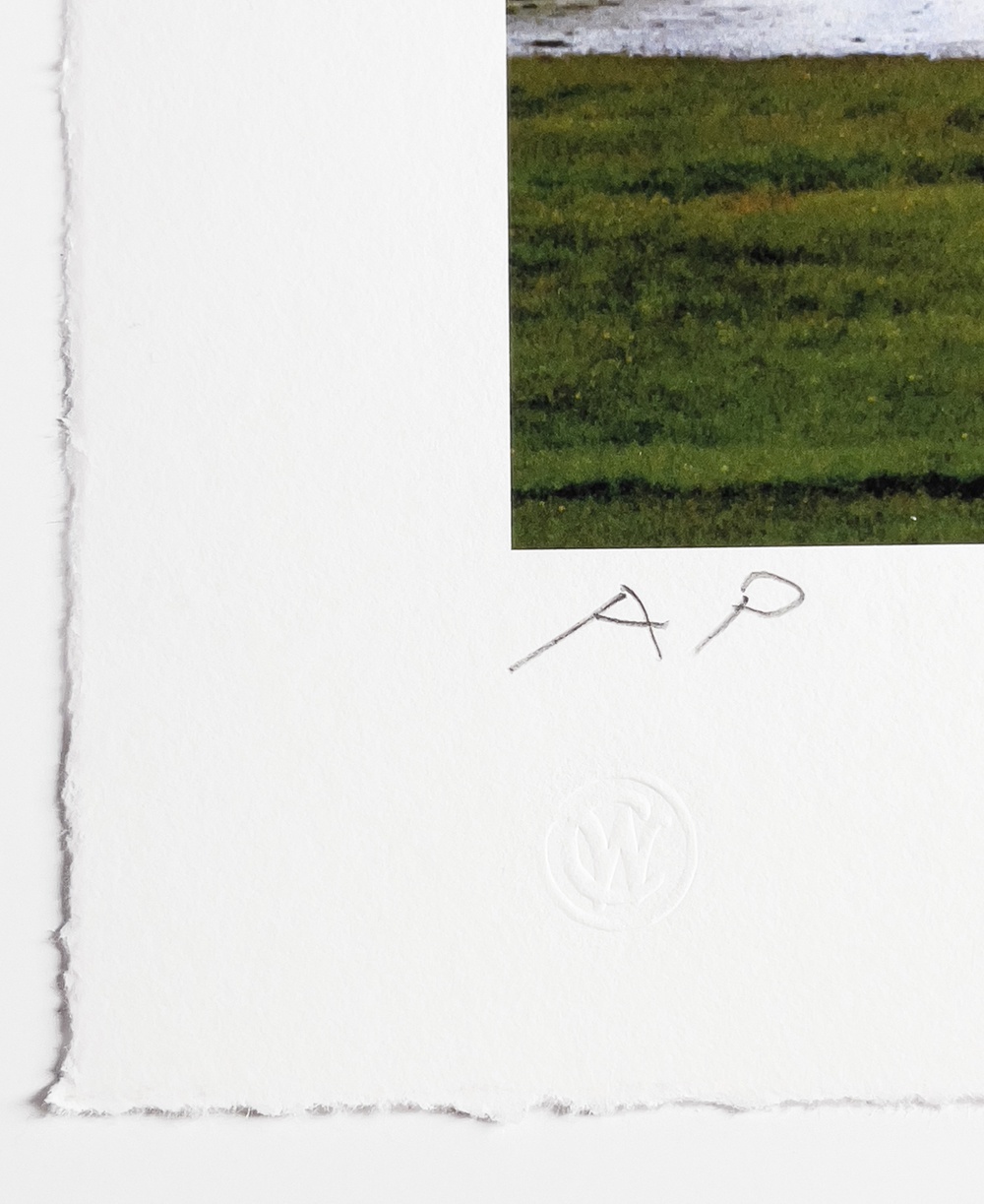 Charlie Waite's signature finish includes the edition number, blind stamp and his artist signature on the front of the print below the photograph.
Charlie Waite's signature finish includes the edition number, blind stamp and his artist signature on the front of the print below the photograph.Charlie Waite Signature Finish | Colour Prints
Archival Pigment Prints With Deckled Edges In White Box FramesCharlie Waite's colour photographs are archival pigment prints, signed and numbered with the artist's blind stamp. All prints are made personally by the artist in limited editions of 25 or 50 prints. Bespoke print sizes and frame mouldings are available for all photographs by request - please email sales@boshamgallery.com
-
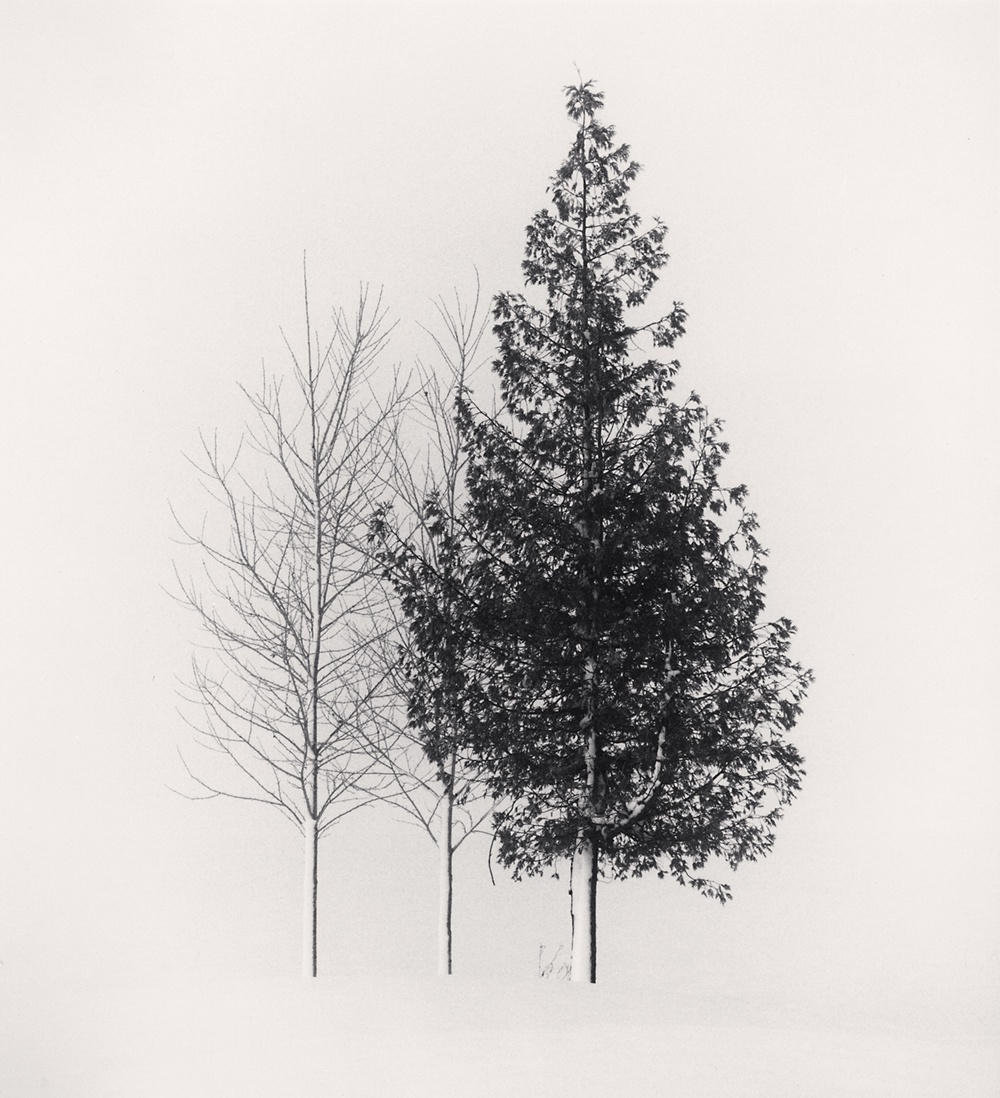 Tree Portrait Study 4, Wakoto, Hokkaido, Japan 2002
Tree Portrait Study 4, Wakoto, Hokkaido, Japan 2002 -
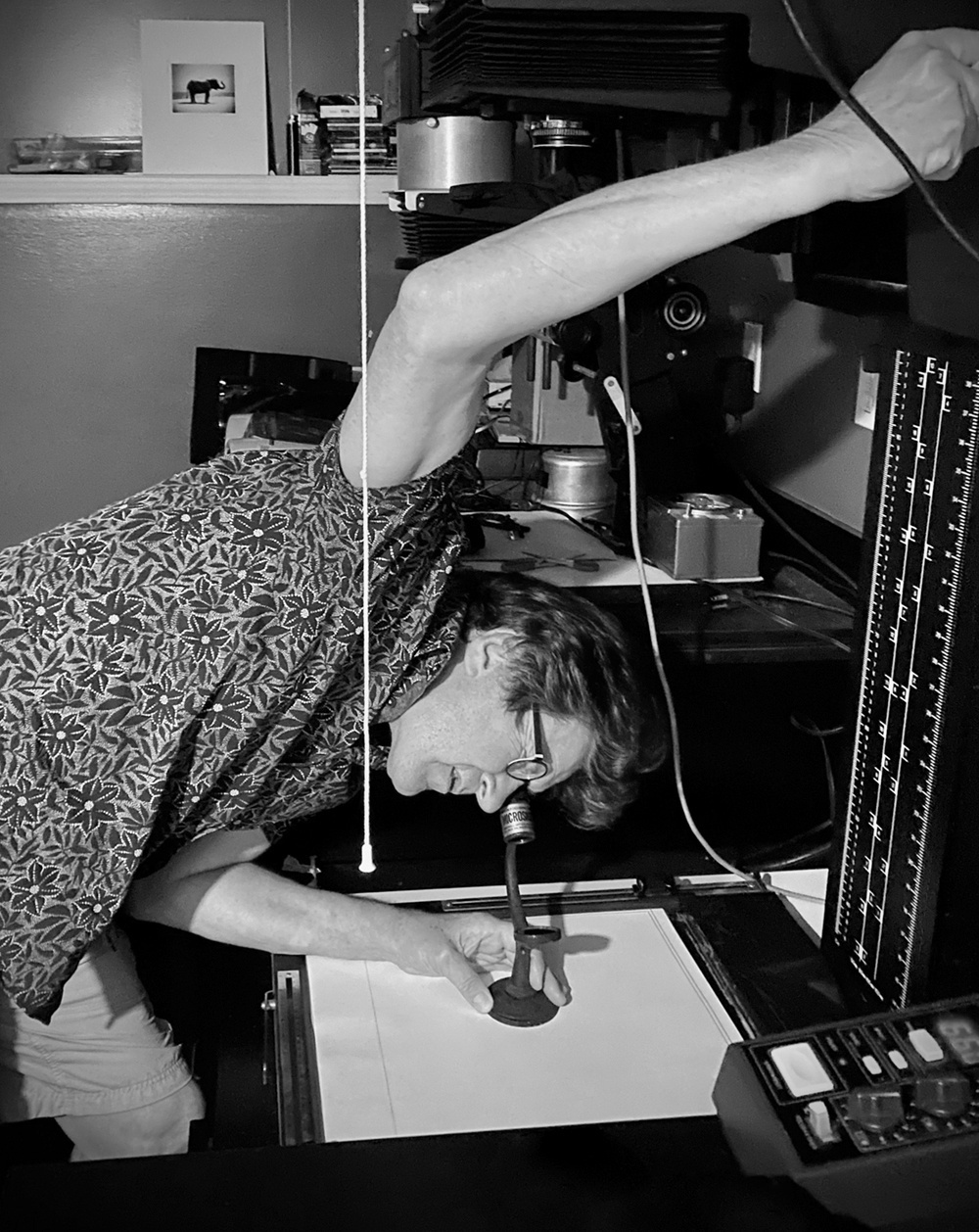 Michael Kenna Working In His Darkroom, Seattle 2021 | © Mamta Kenna
Michael Kenna Working In His Darkroom, Seattle 2021 | © Mamta KennaMichael Kenna | Prints Of Distinguished Provenance Since 1973
Handmade Silver Gelatin Prints In SeattleMichael Kenna’s prints have a distinguished provenance. Since the start of his career in the 1970s Michael Kenna has worked solely with film, and he makes every silver gelatin print himself personally, in his darkroom at his home studio in Seattle, USA.
-
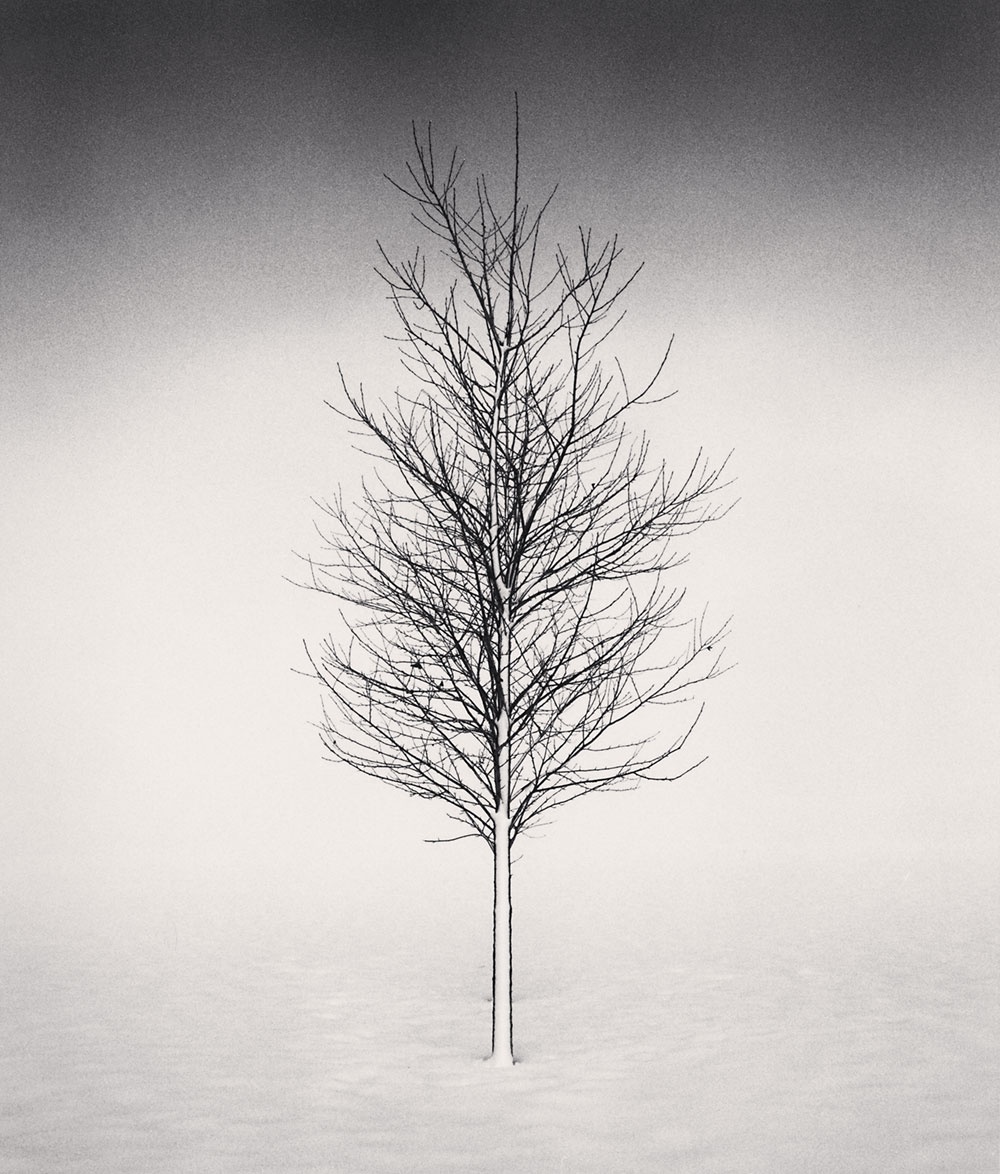 Tree Portrait Study 1, Wokato, Hokkaido, Japan, 2002 | Artist Proof 04
Tree Portrait Study 1, Wokato, Hokkaido, Japan, 2002 | Artist Proof 04Michael Kenna | Tree Portrait, Study 1, Hokkaido, Japan 2002
Picture | Story By Michael KennaMichael Kenna has travelled the world to create his distinct black and white images of unpopulated landscapes. It was in the mid-1980s that Kenna first began to visit Japan and became influenced by an Asian sense of aesthetics.
-
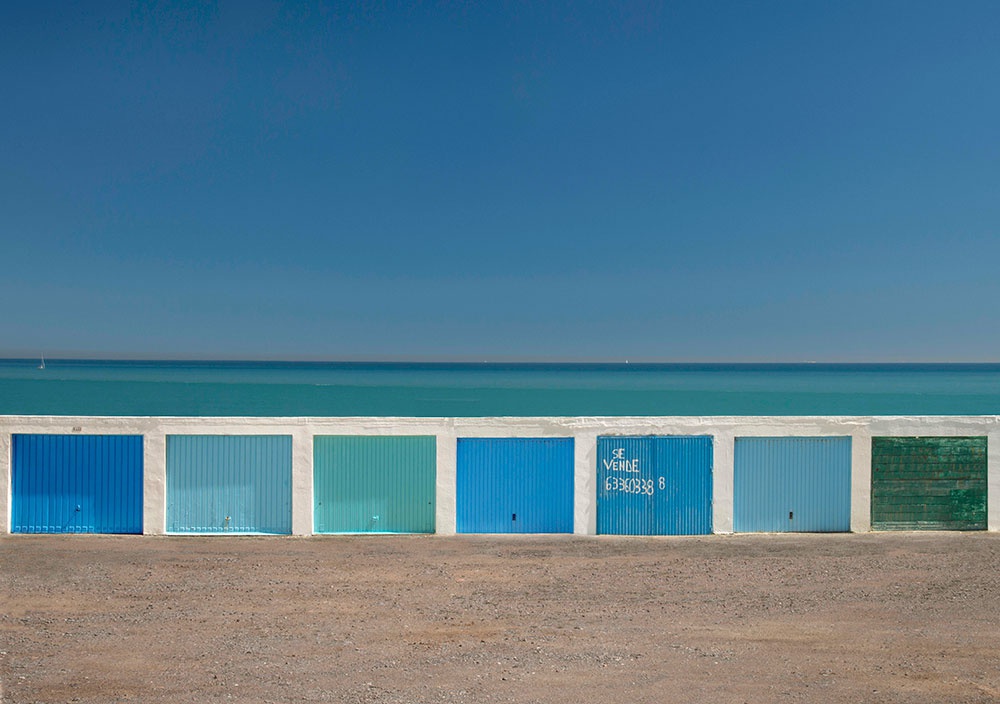 East of Gibraltar, Spain, 2017 | Charlie Waite | Limited Edition of 50 Prints
East of Gibraltar, Spain, 2017 | Charlie Waite | Limited Edition of 50 PrintsEast of Gibraltar, Spain, 2017
Picture/Story By Charlie WaiteHe is one of the most celebrated landscape photographers in the world and art critics have described Charlie Waite's instantly recognisable prints as 'rare perfections of light, colour and composition which offer the viewer a luxuriant portrait of a planet at peace and one where mankind and his activities are in harmony with his surroundings'. But did you know what a charming and eloquent writer Waite is too? Here we enjoy the story behind one of Waite's more unusual photographs within his archive, East of Gibraltar, Spain, 2017, and his clever use of a limited colour palette. 'I acquired an early edition for my own collection and have loved living with this stunning print in my hallway at home. I adore this sea blue!' Luke Whitaker. BUY
-
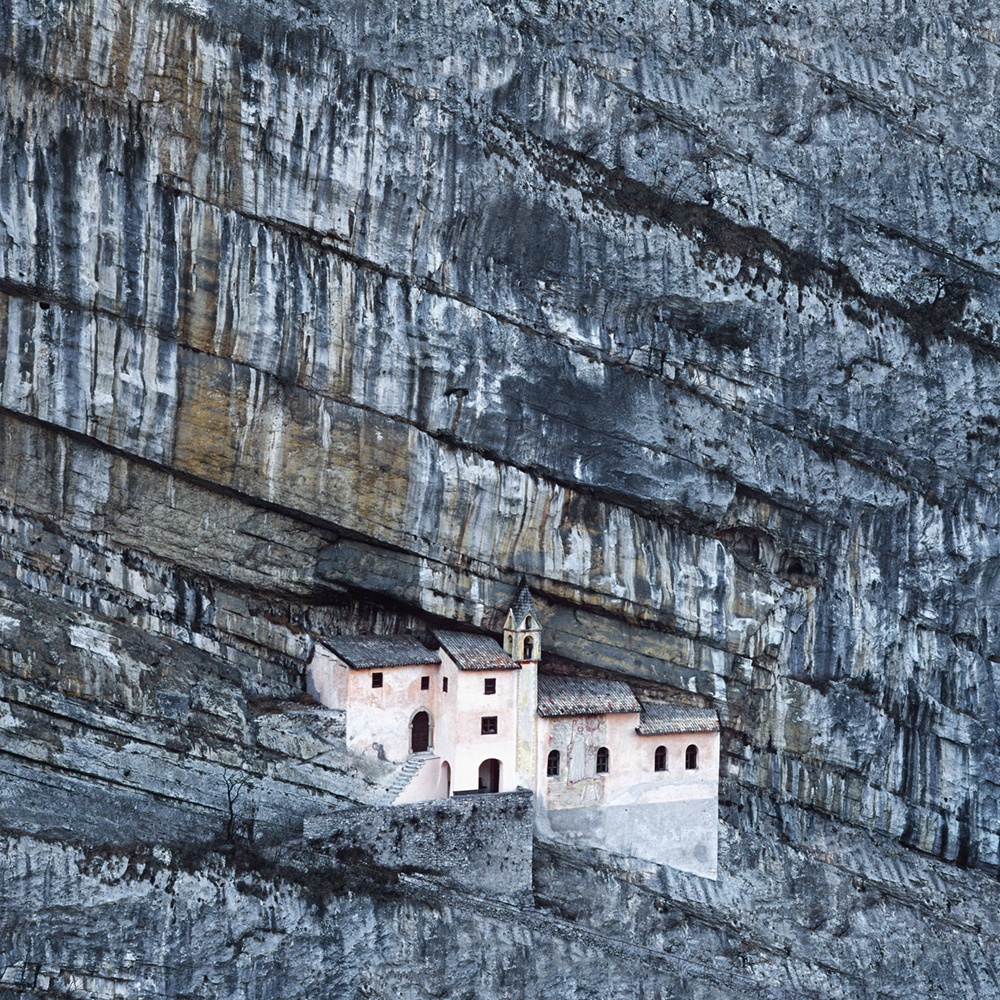 Rovereto, Italy 1989
Rovereto, Italy 1989 -
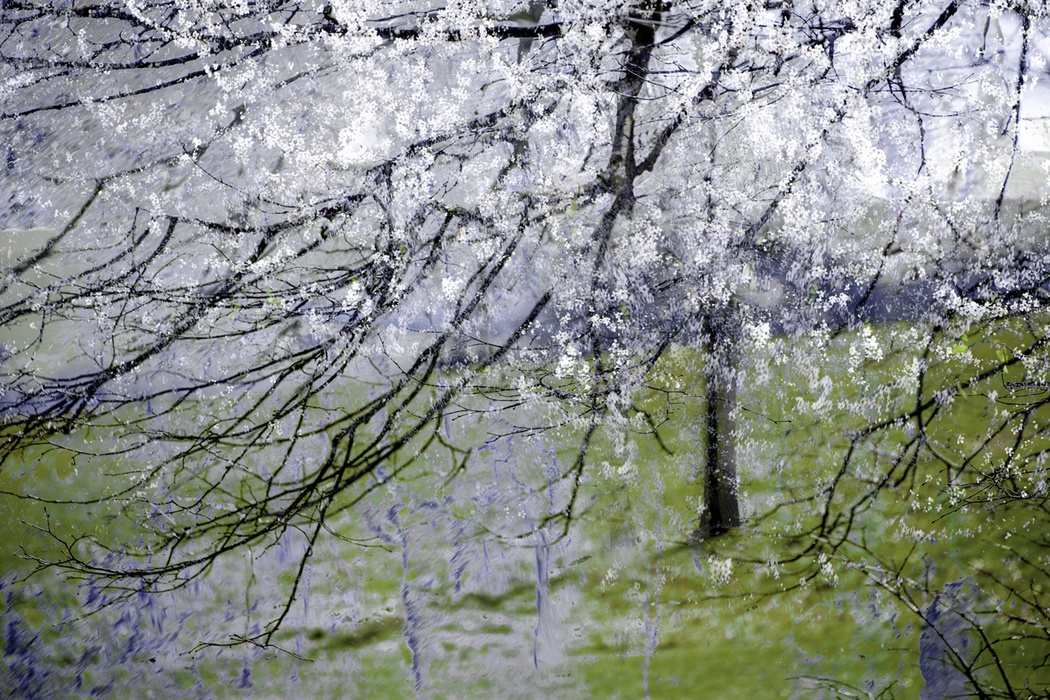 Blossom Blizzard Study 1, Stanmer Park, Sussex, England 2014 | Valda Bailey | Edition of 10
Blossom Blizzard Study 1, Stanmer Park, Sussex, England 2014 | Valda Bailey | Edition of 10Blossom Blizzard Study 1, Stanmer Park, Sussex, England 2014
Picture/Story By Valda Bailey -

-
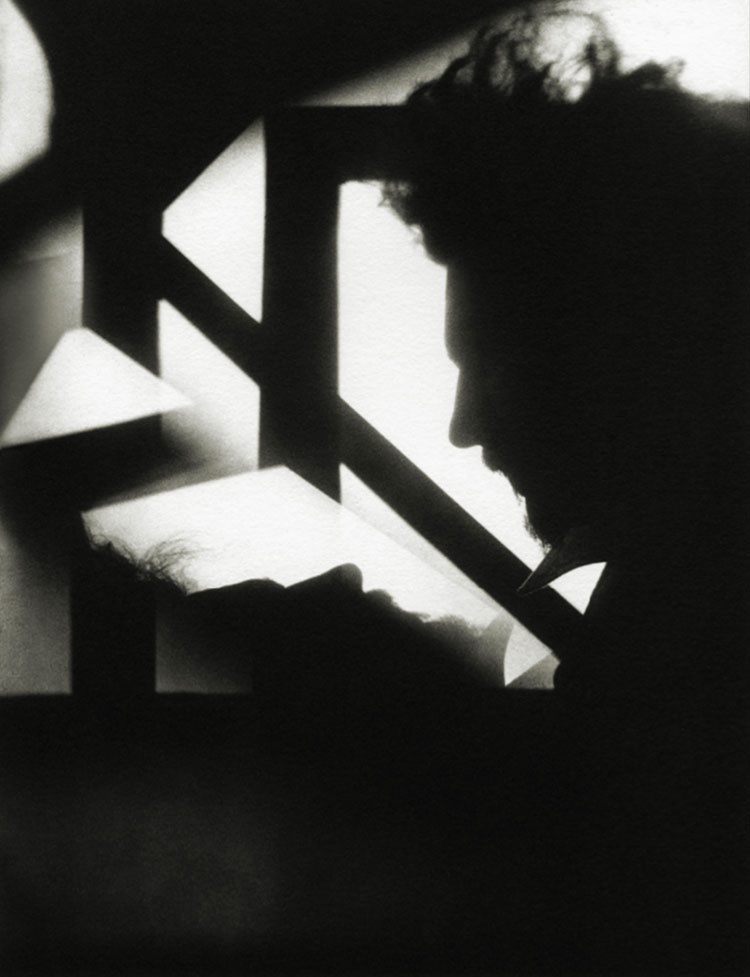 Vortograph of Ezra Pound 1916 by Alvin Langdon Coburn
Vortograph of Ezra Pound 1916 by Alvin Langdon Coburn -
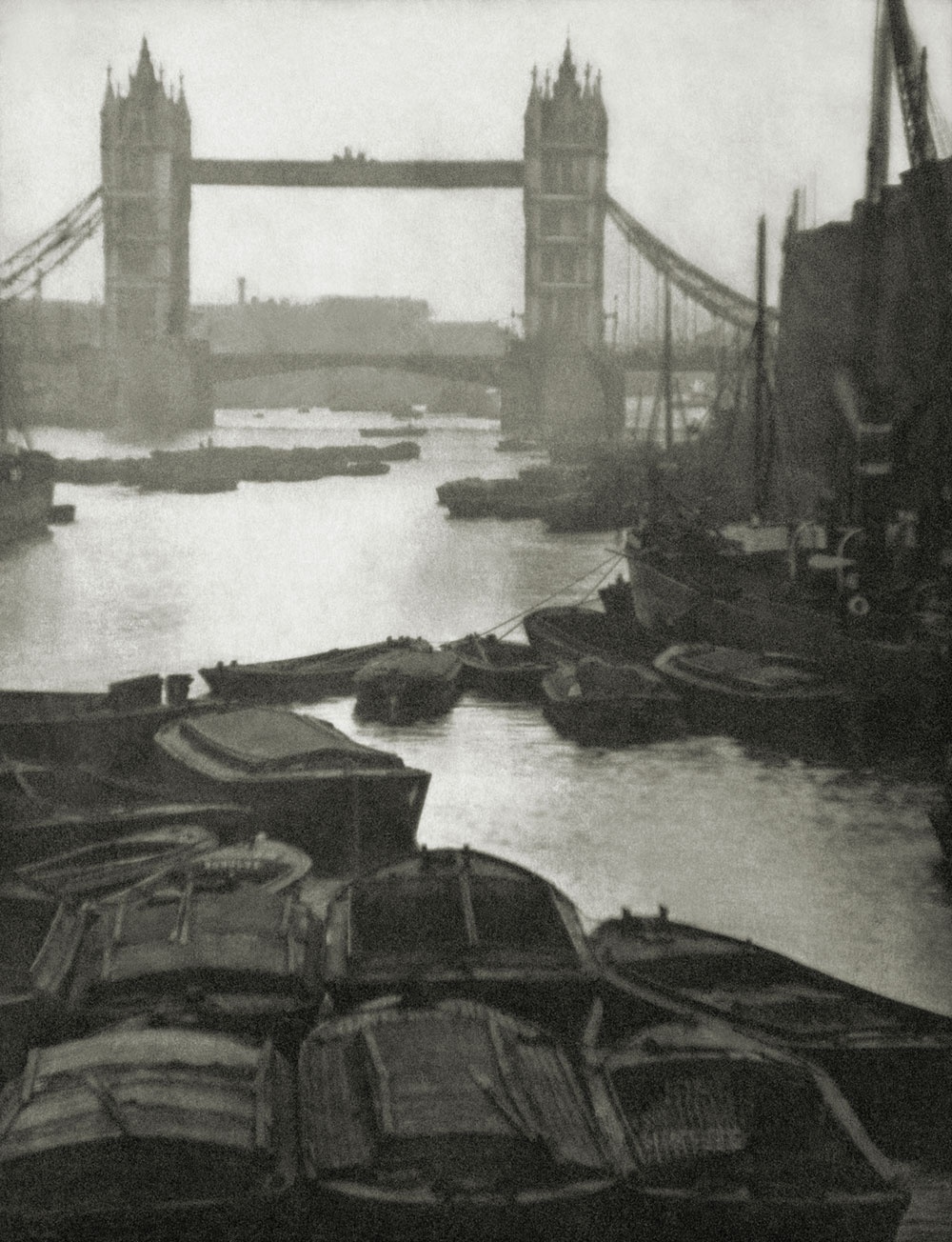 The Tower Bridge, London 1909 by Alvin Langdon Coburn
The Tower Bridge, London 1909 by Alvin Langdon Coburn -
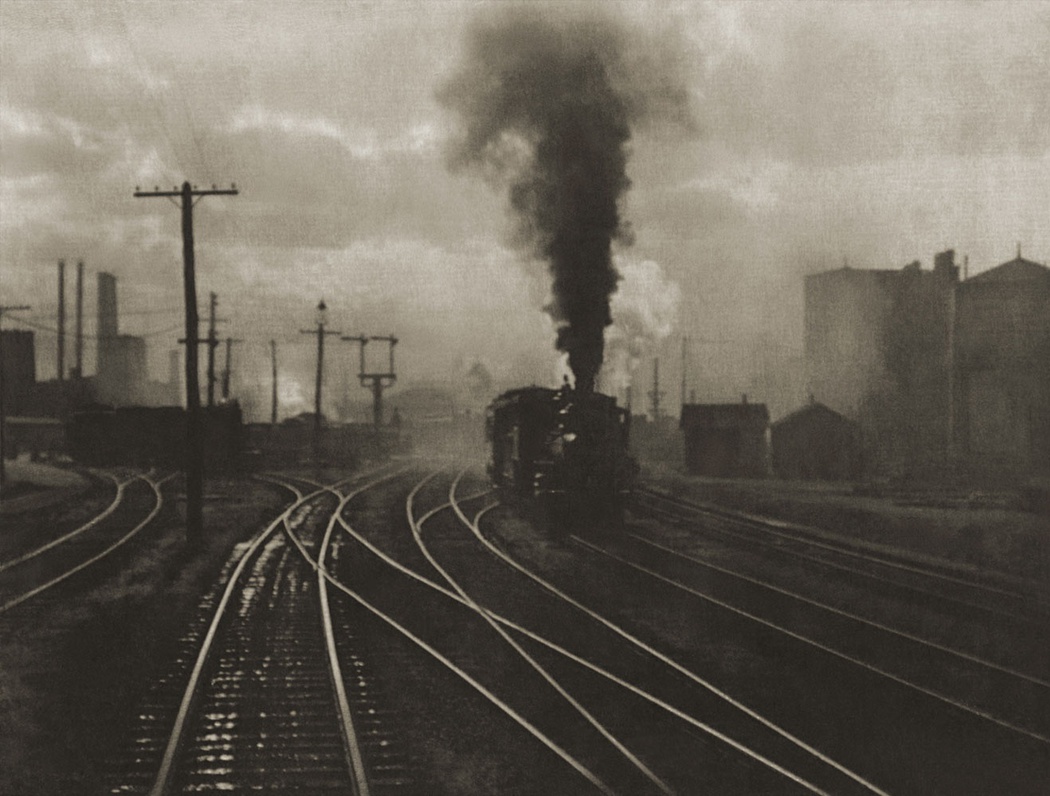 The Hand of Man, 1902 by Alfred Stieglitz
The Hand of Man, 1902 by Alfred Stieglitz